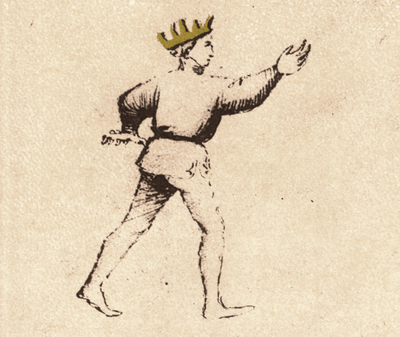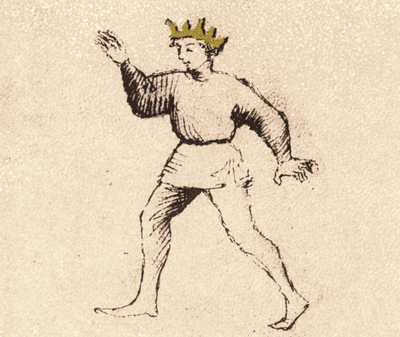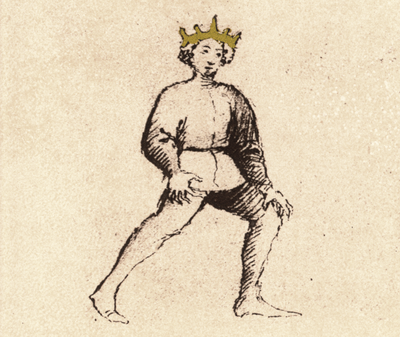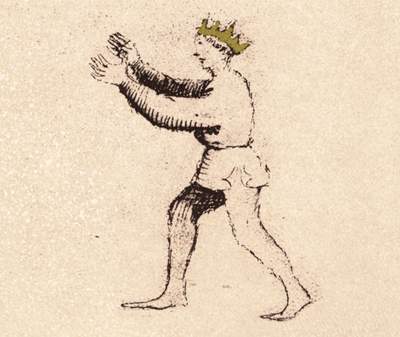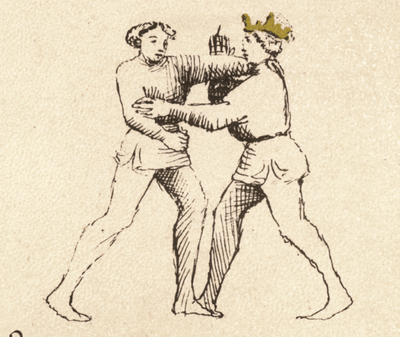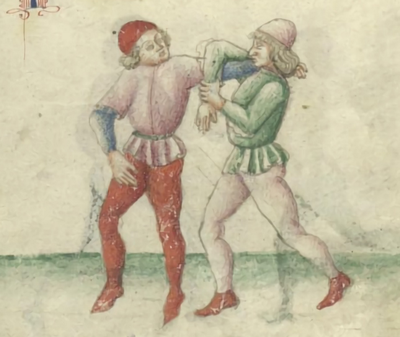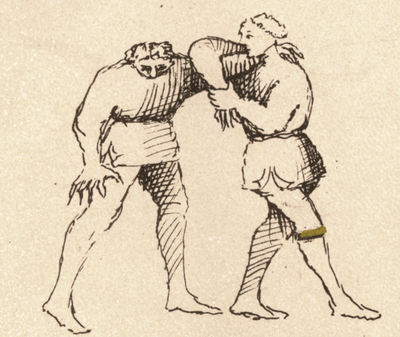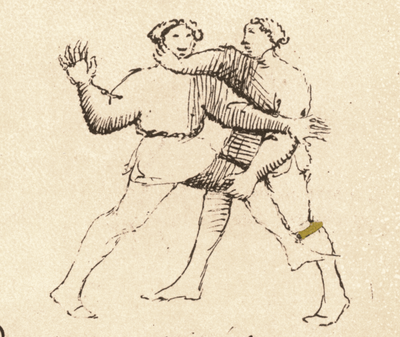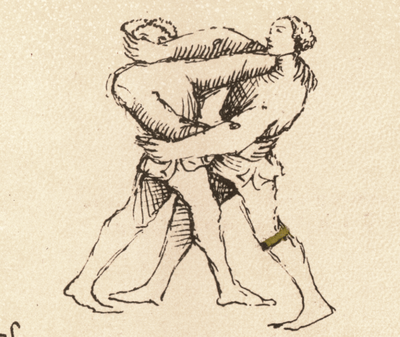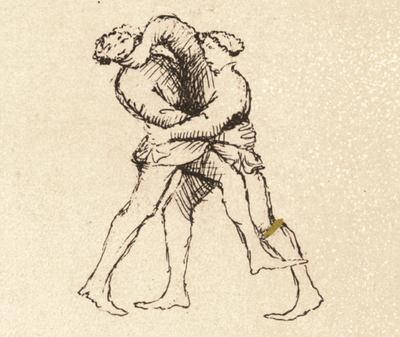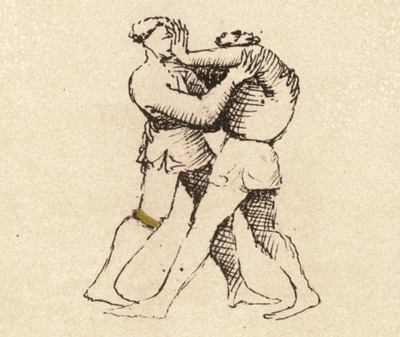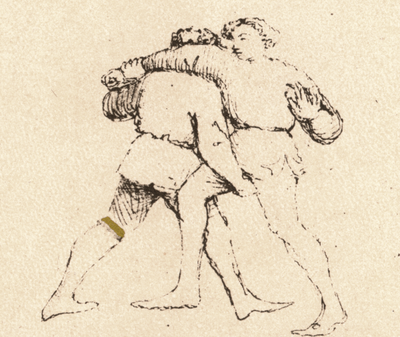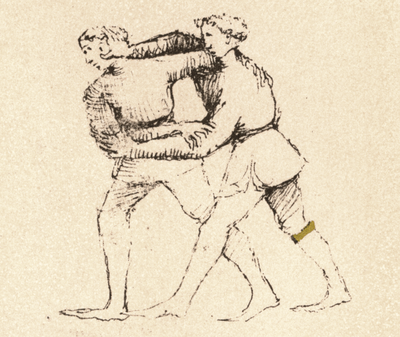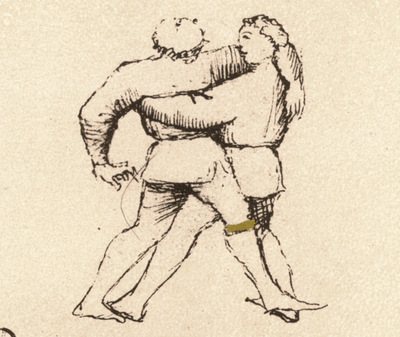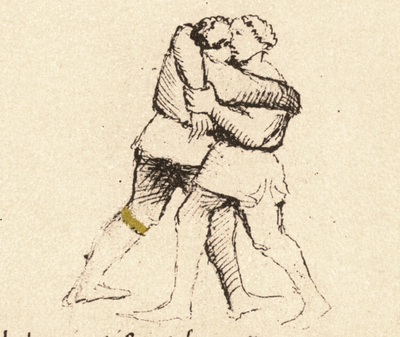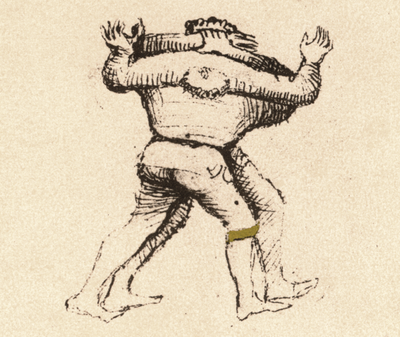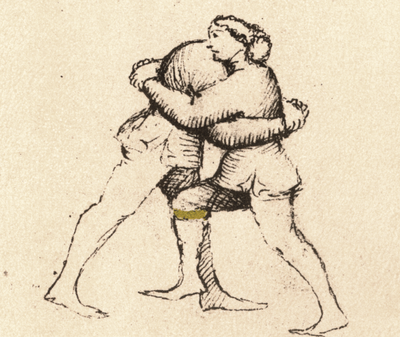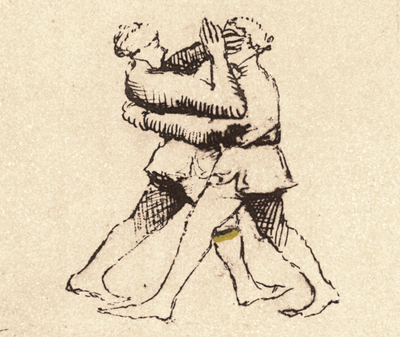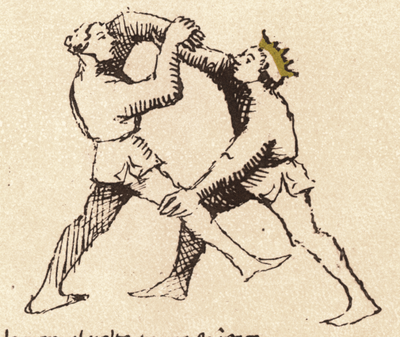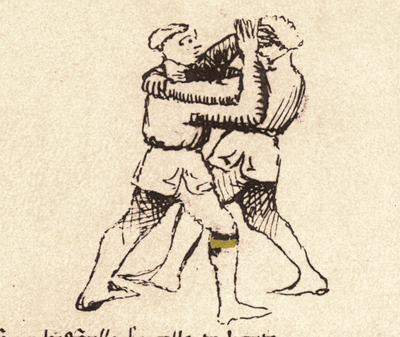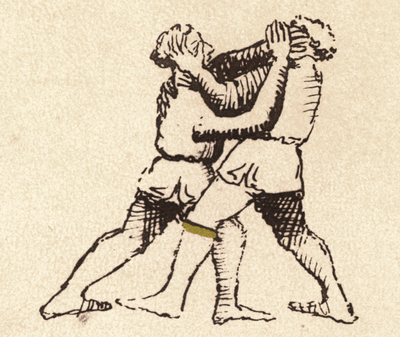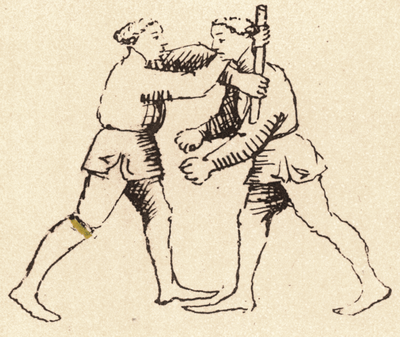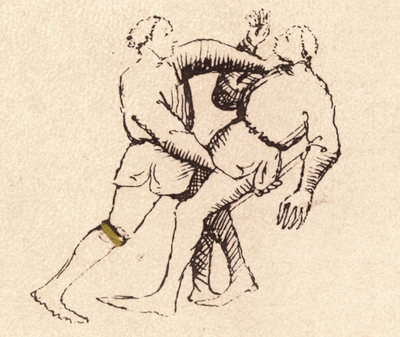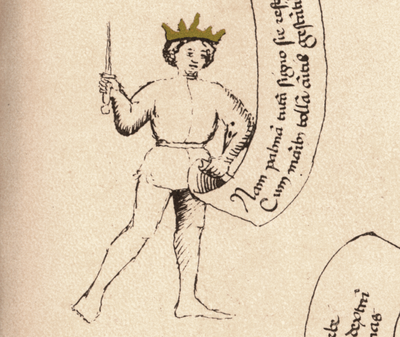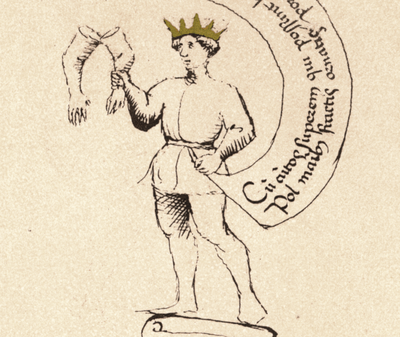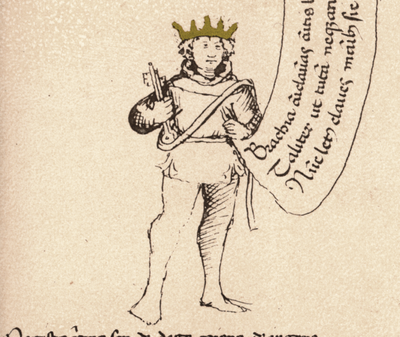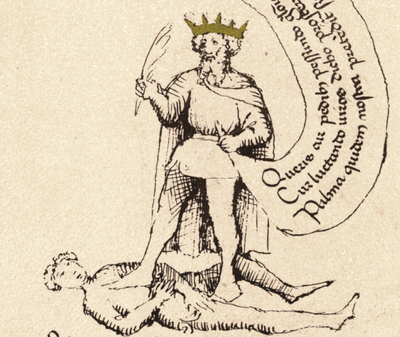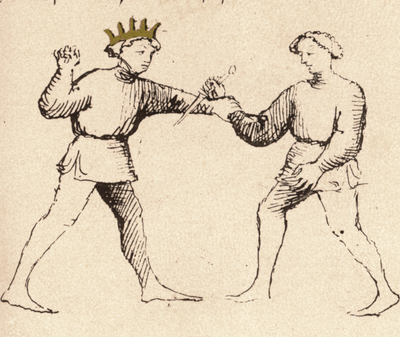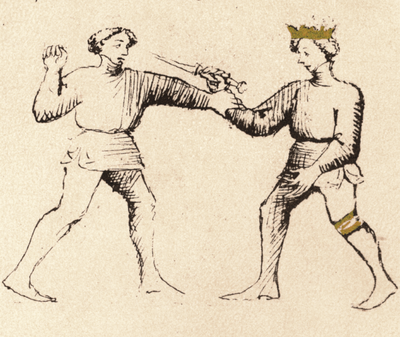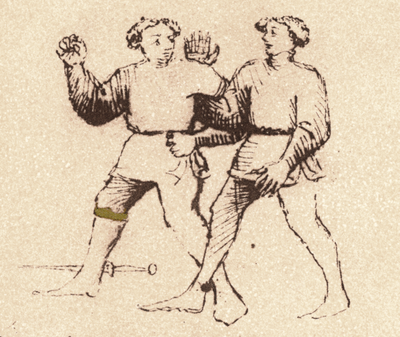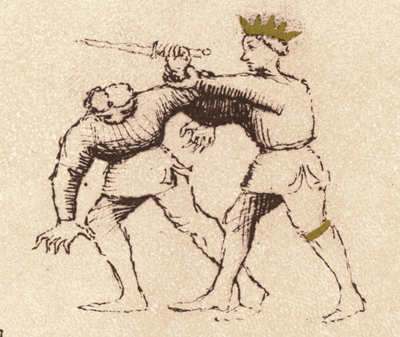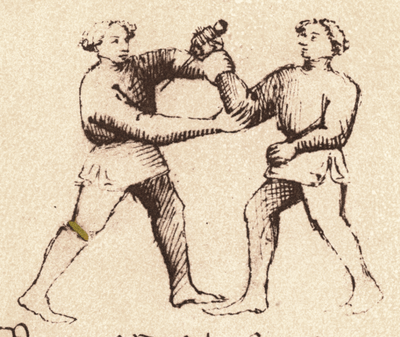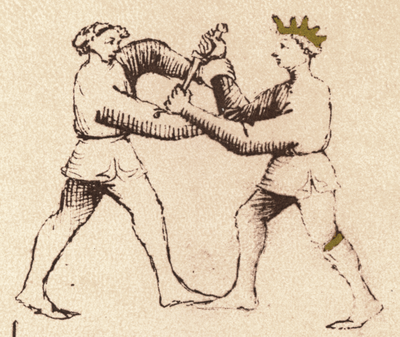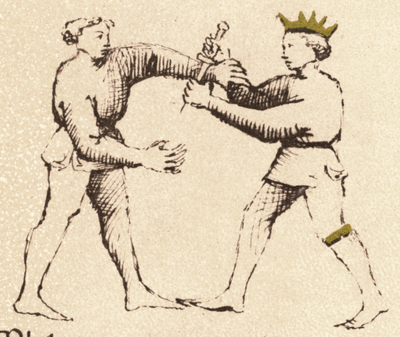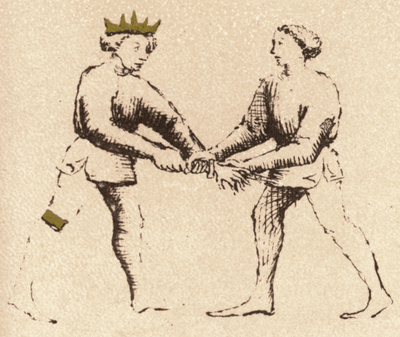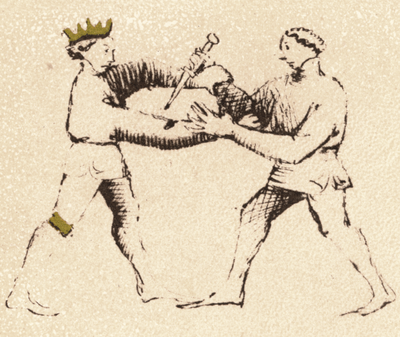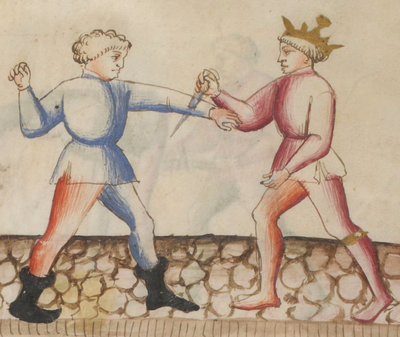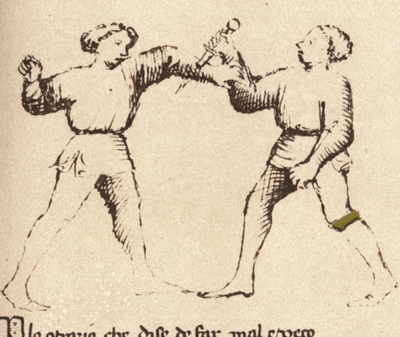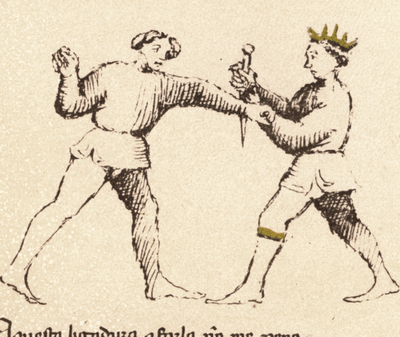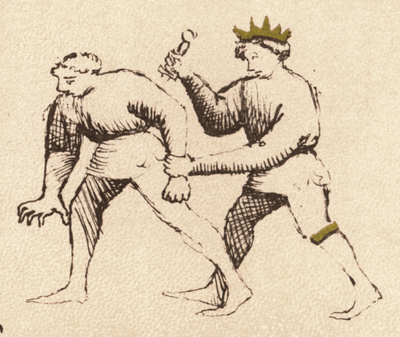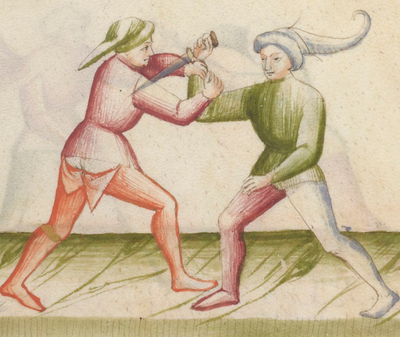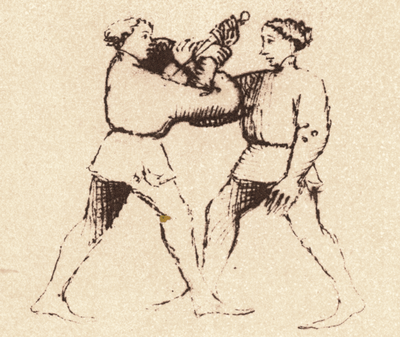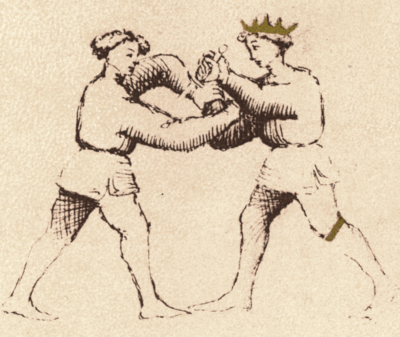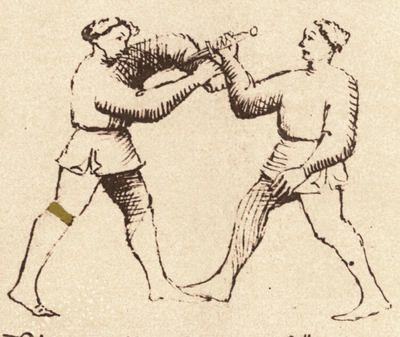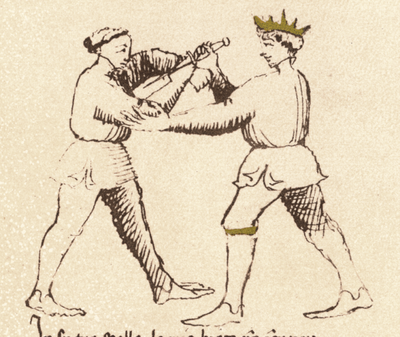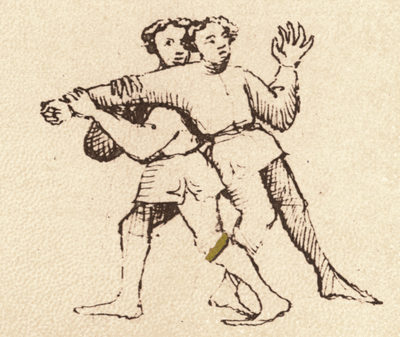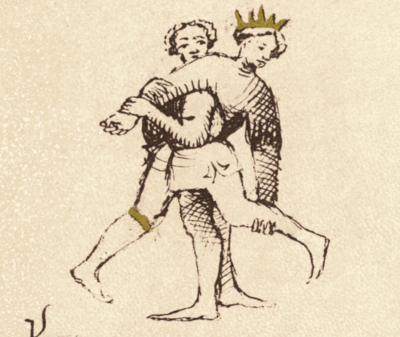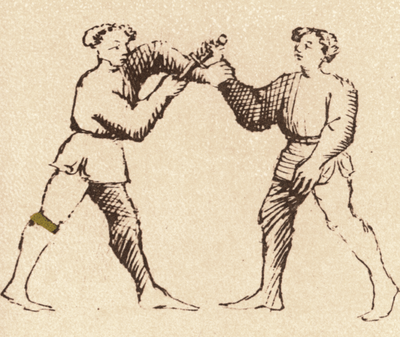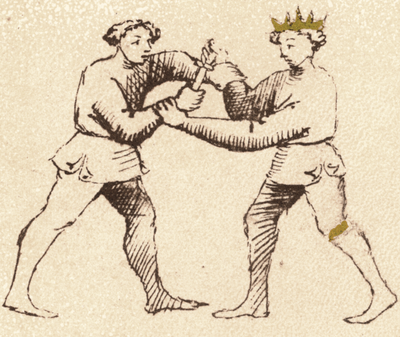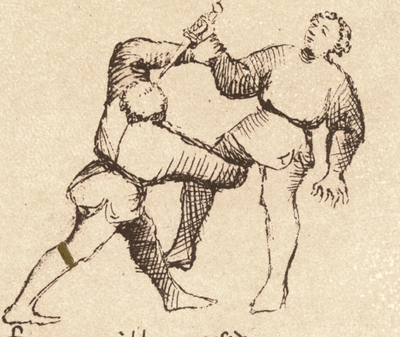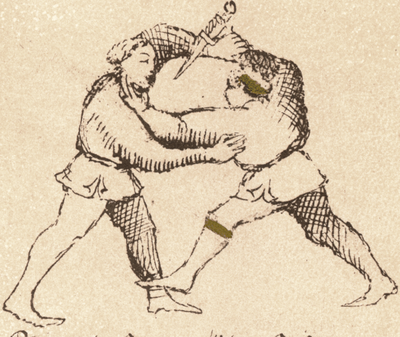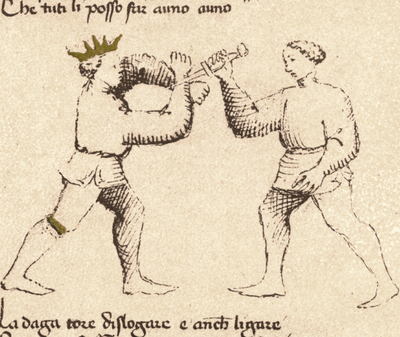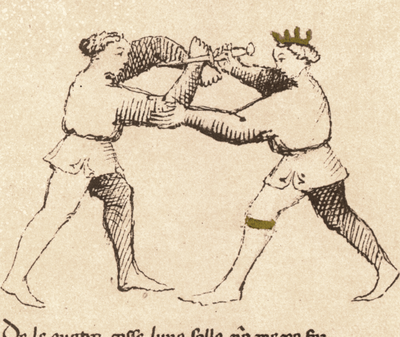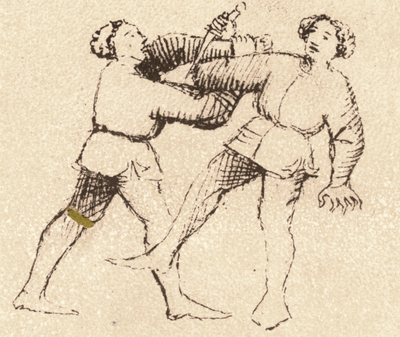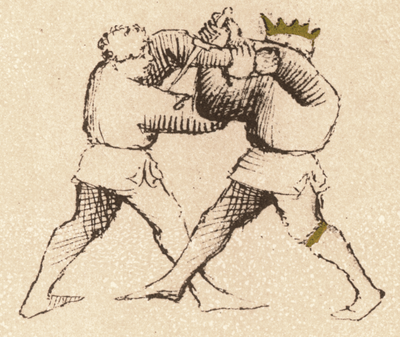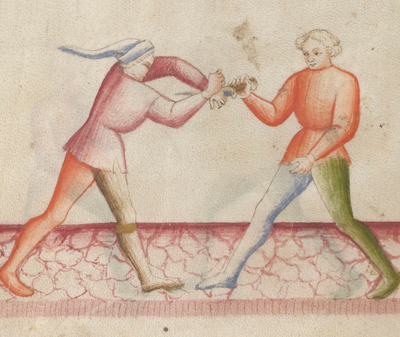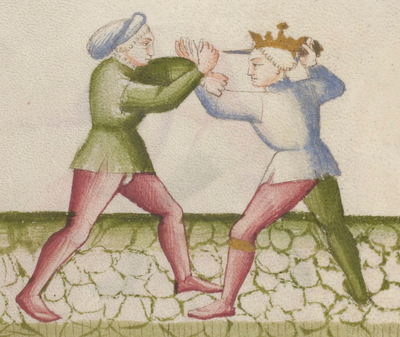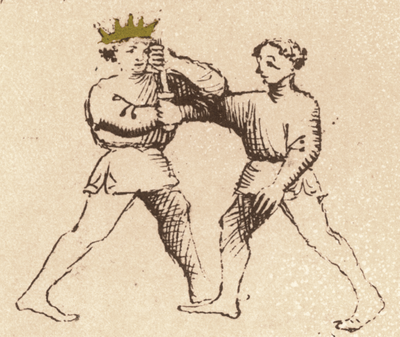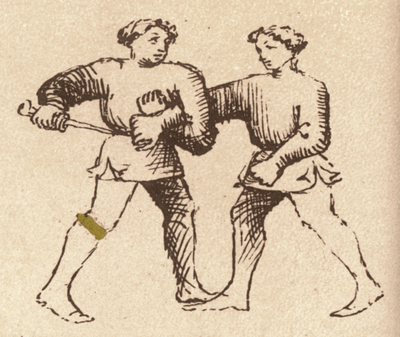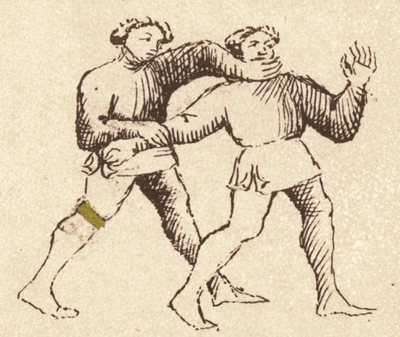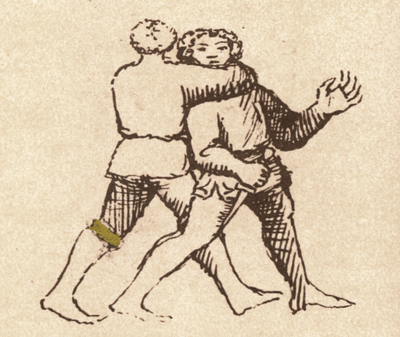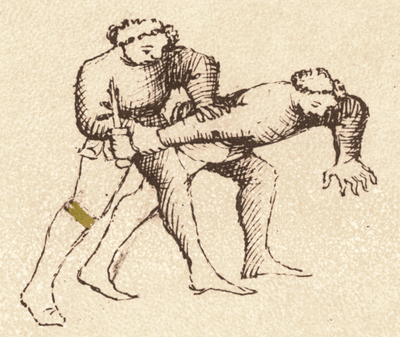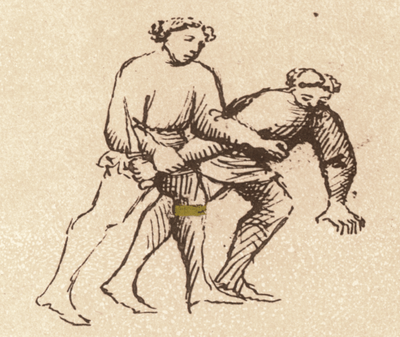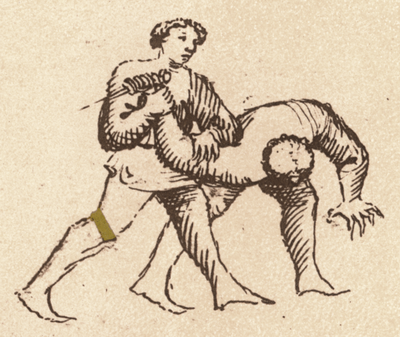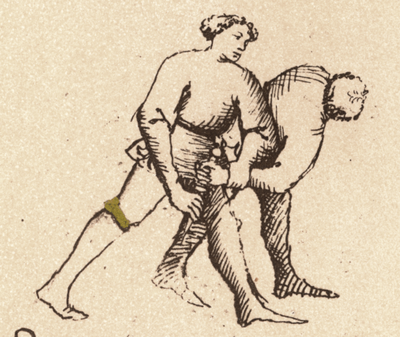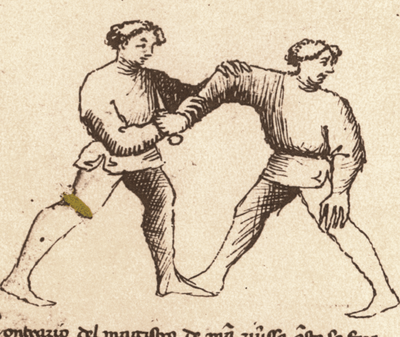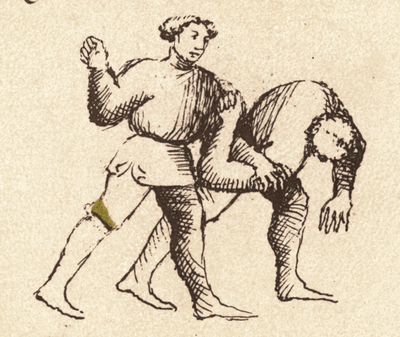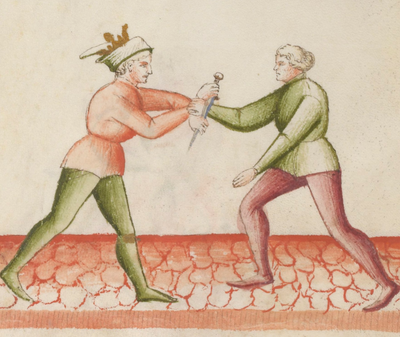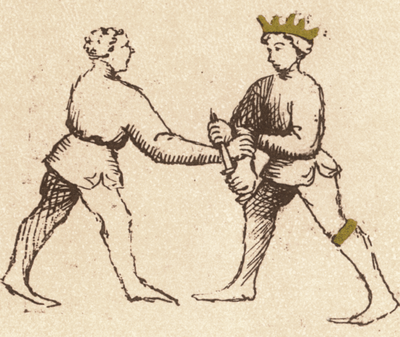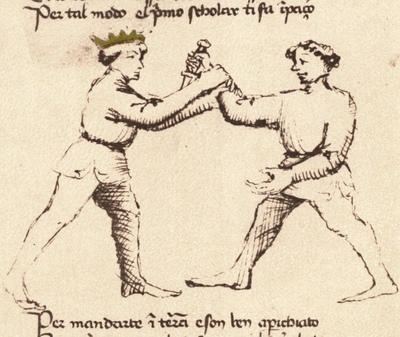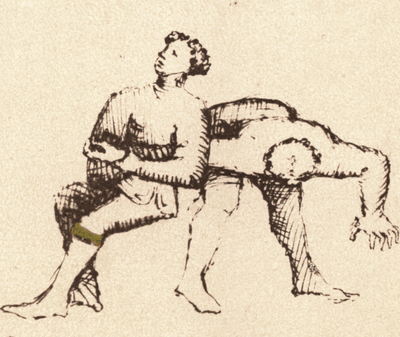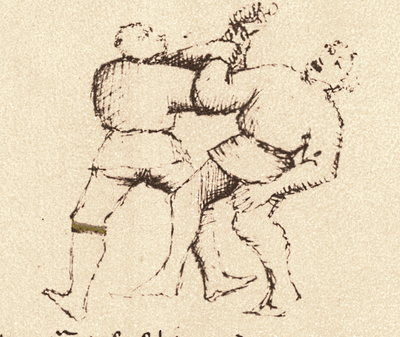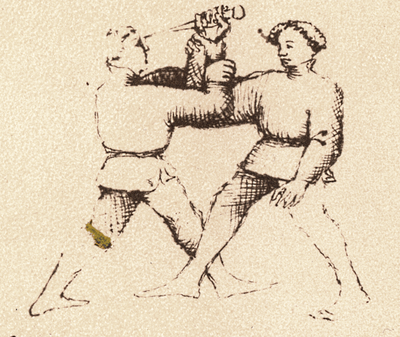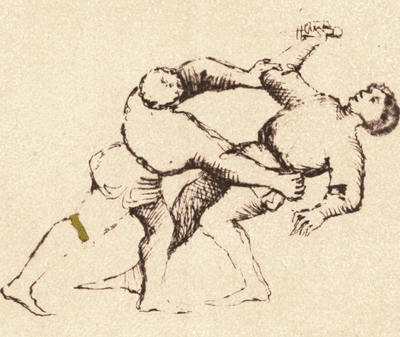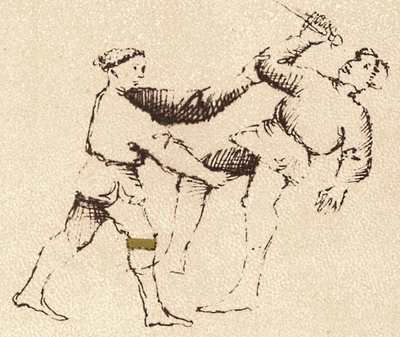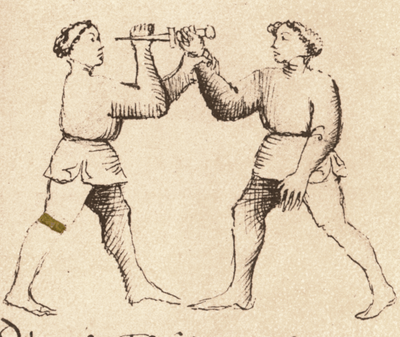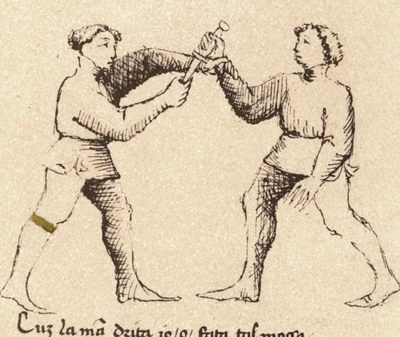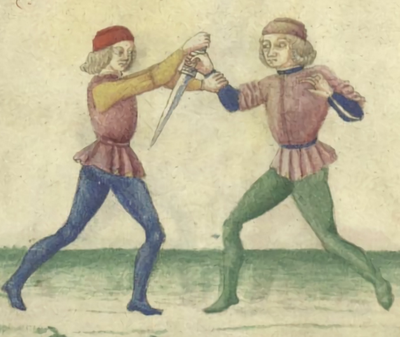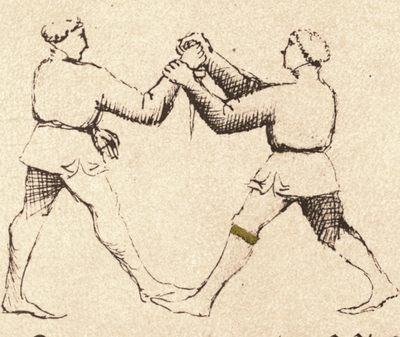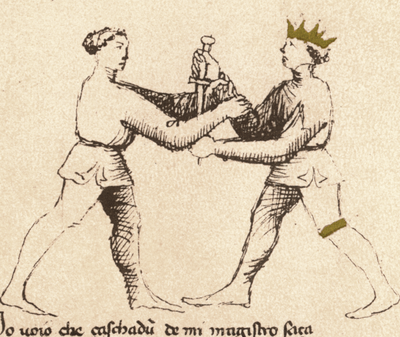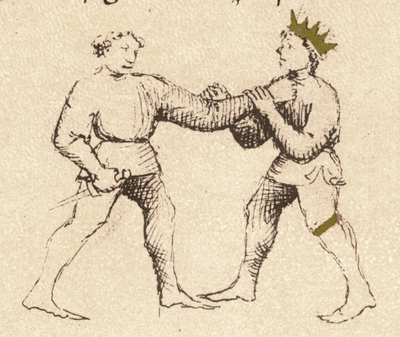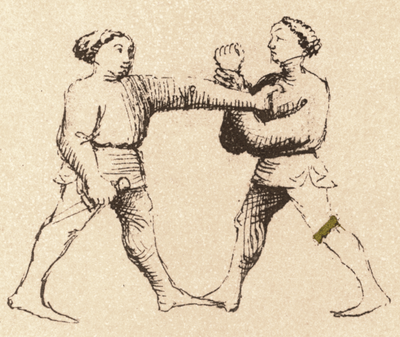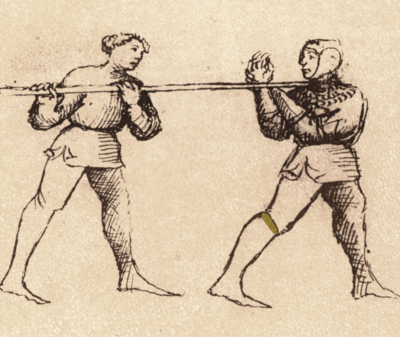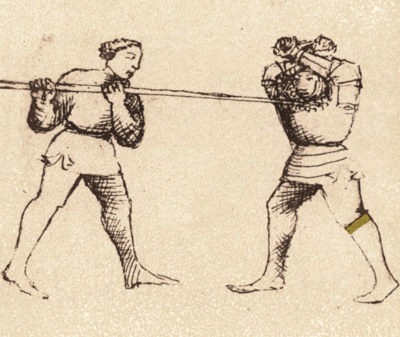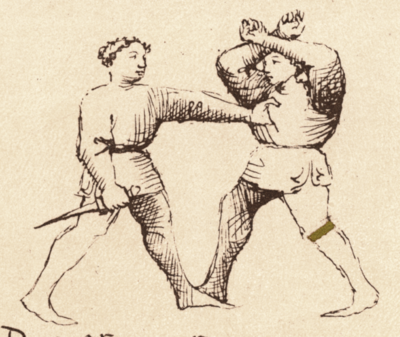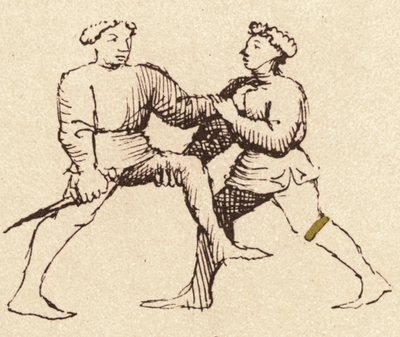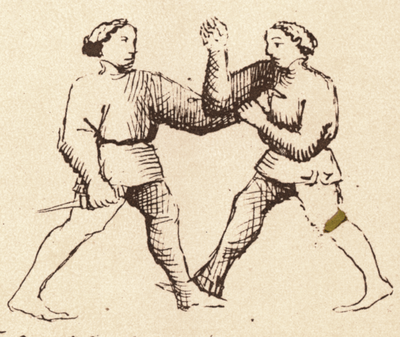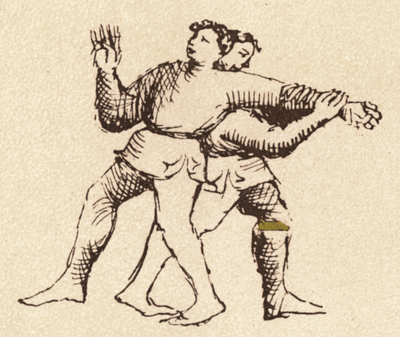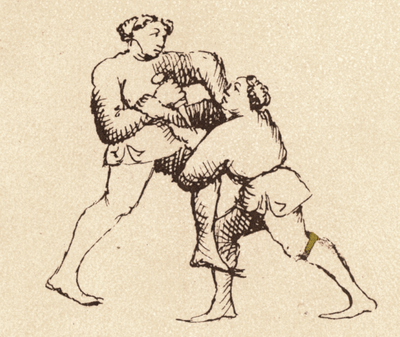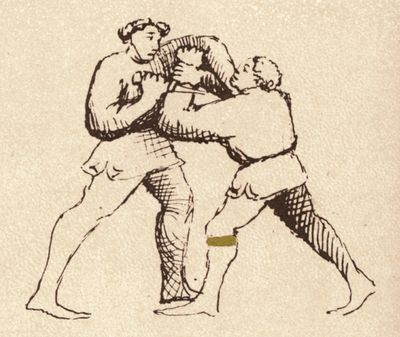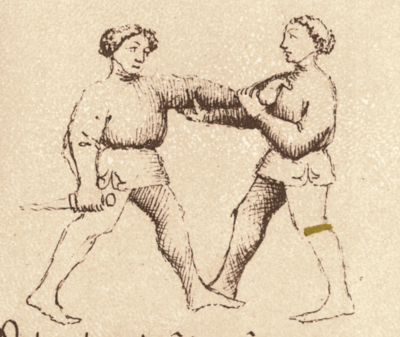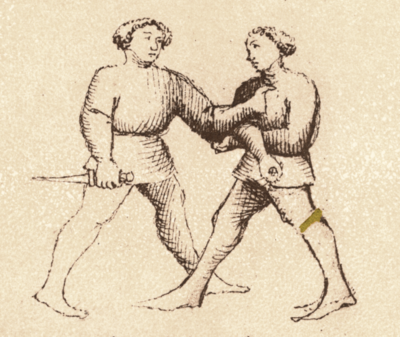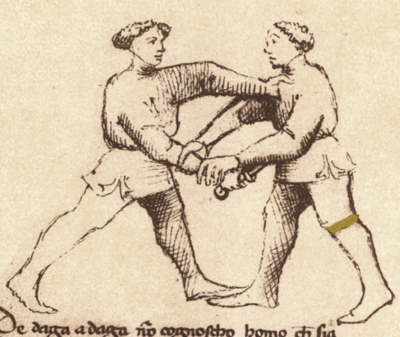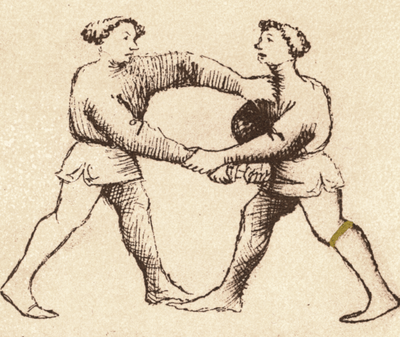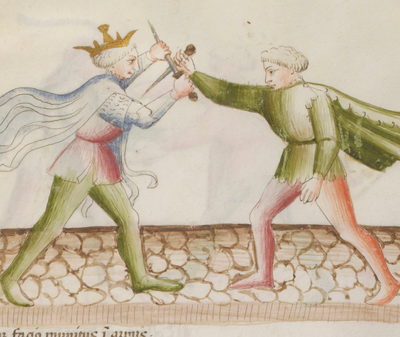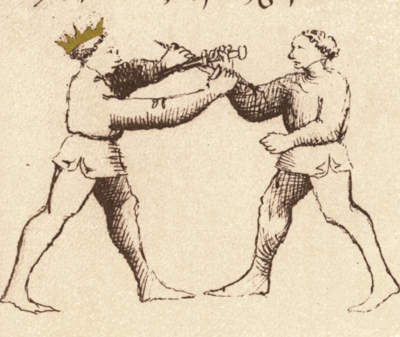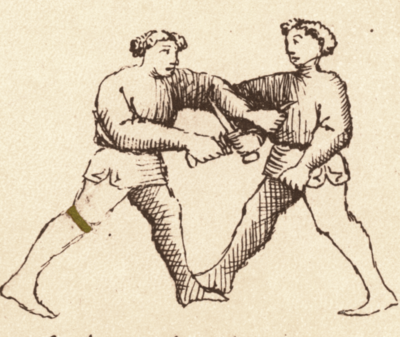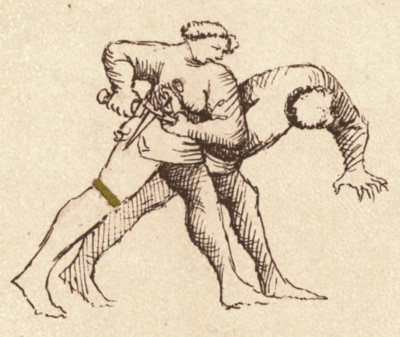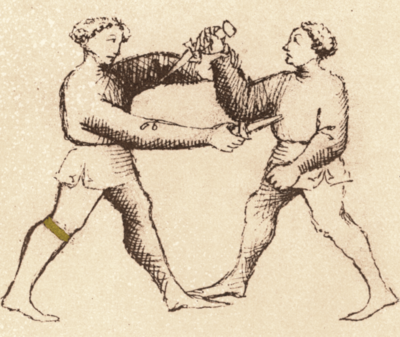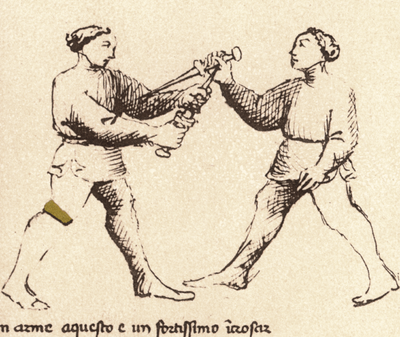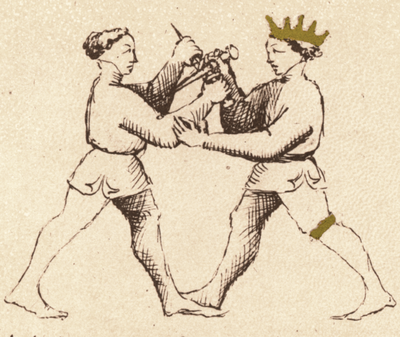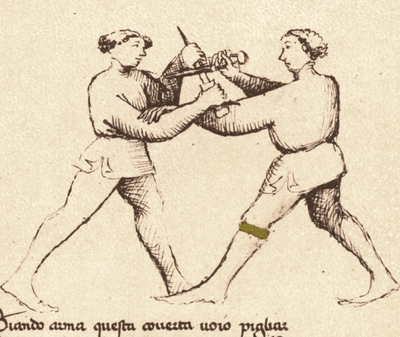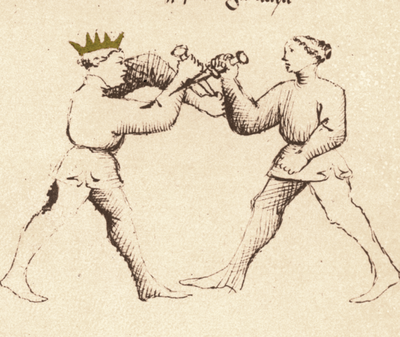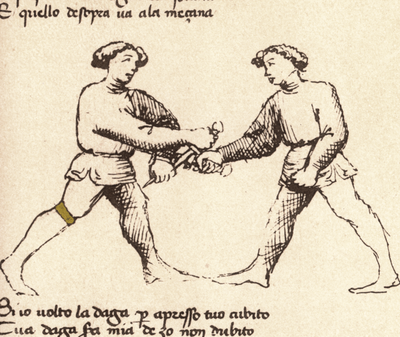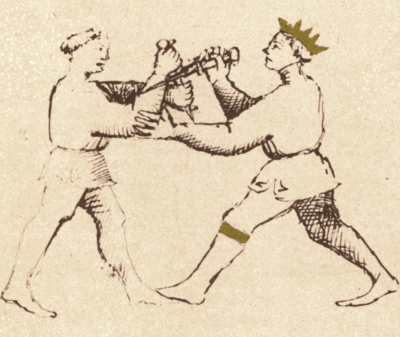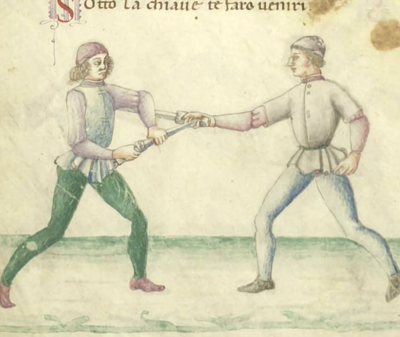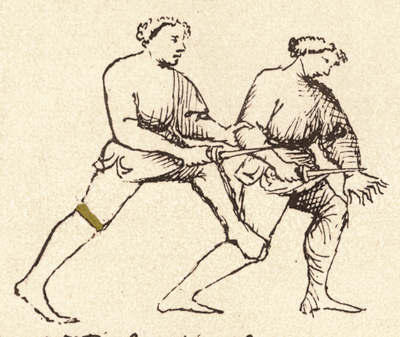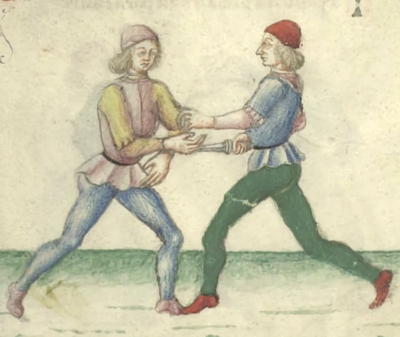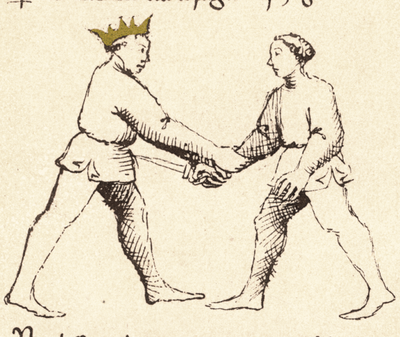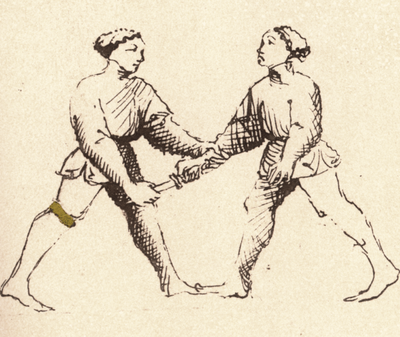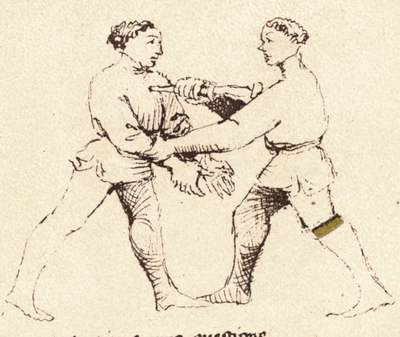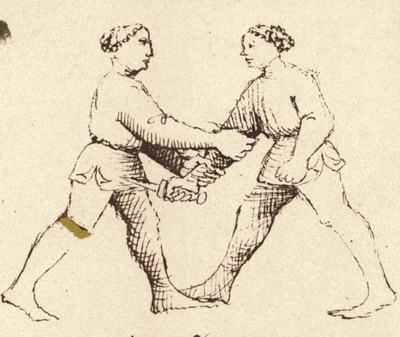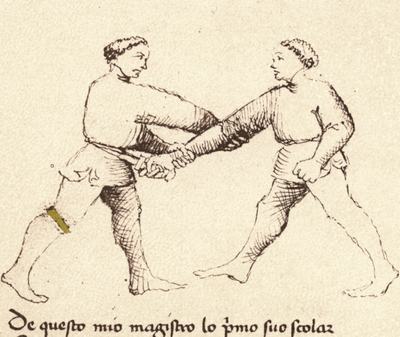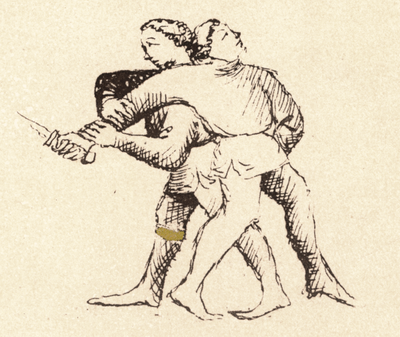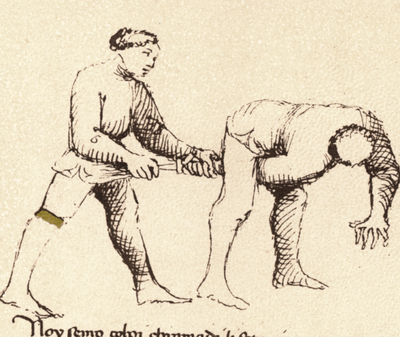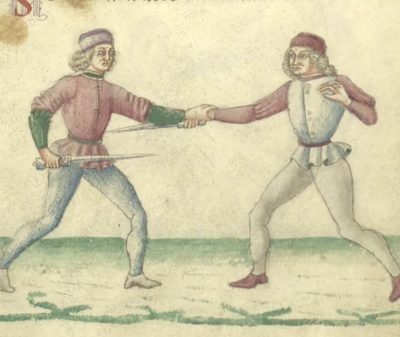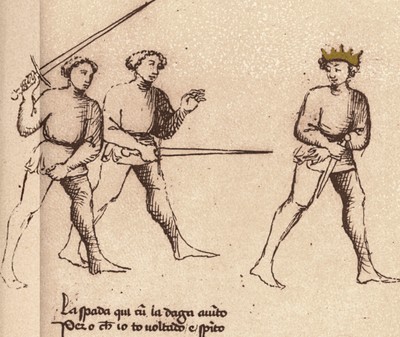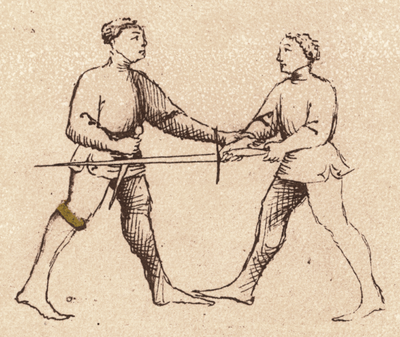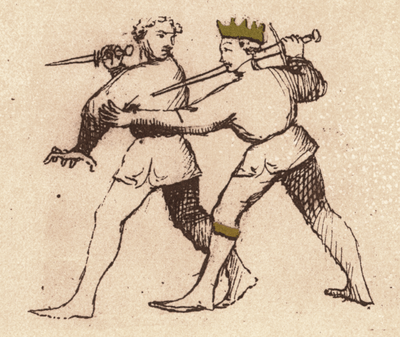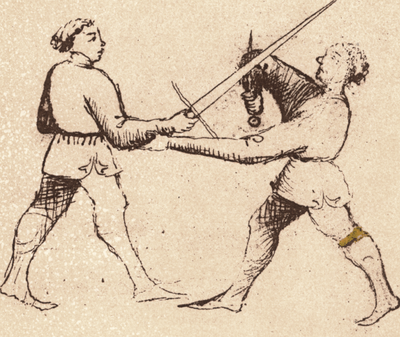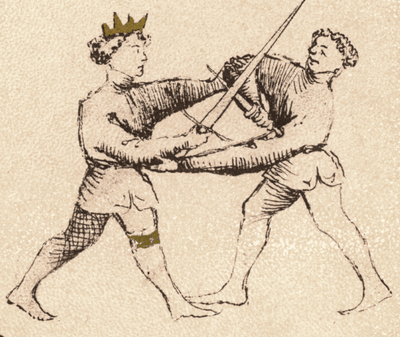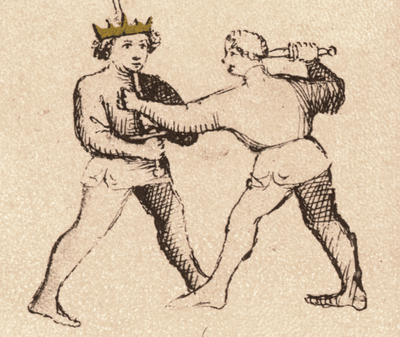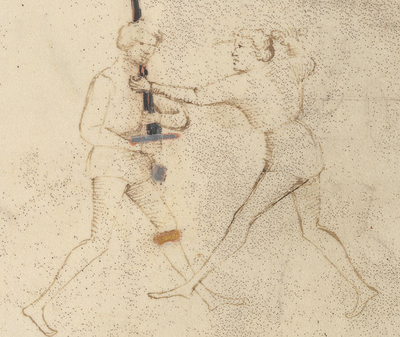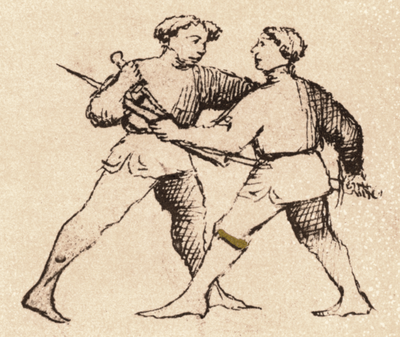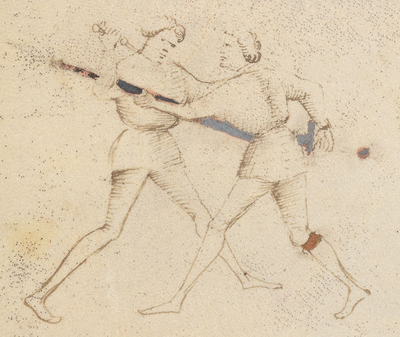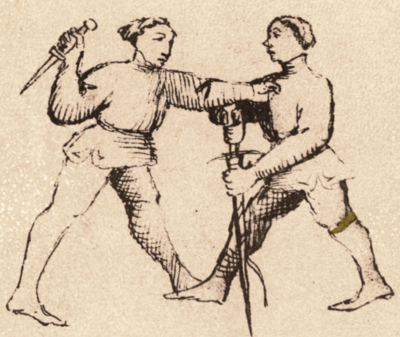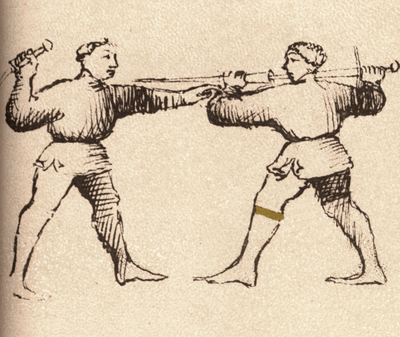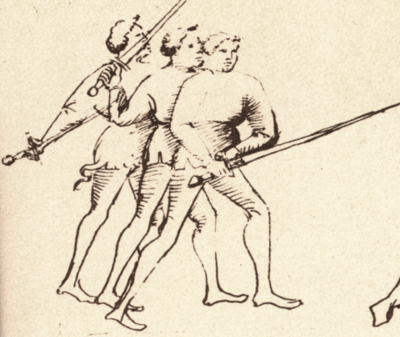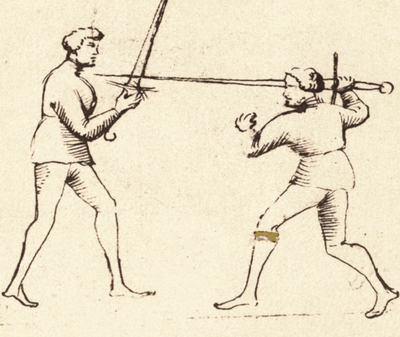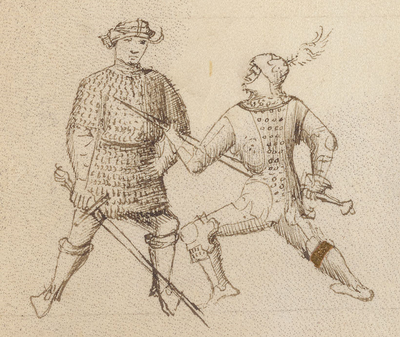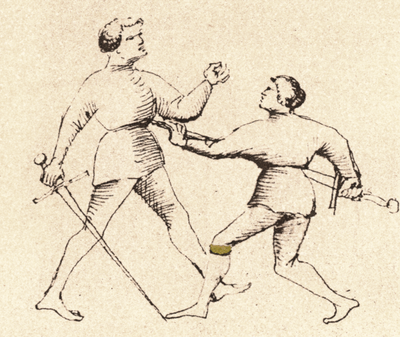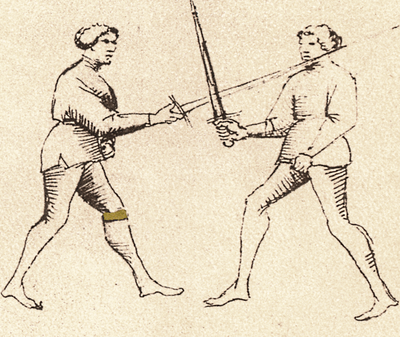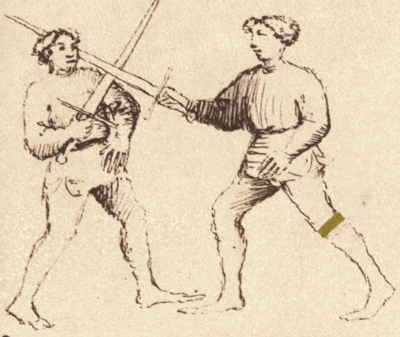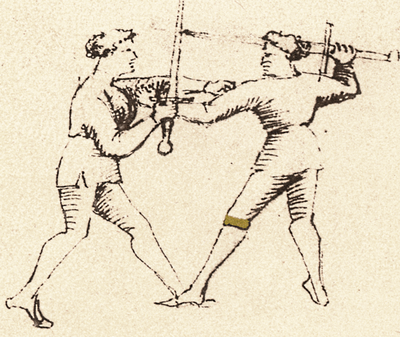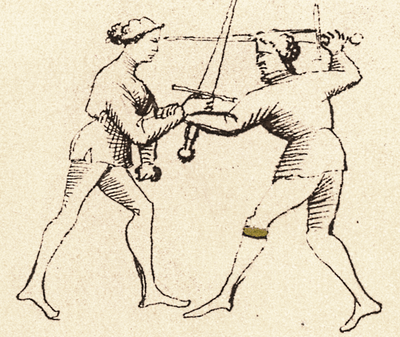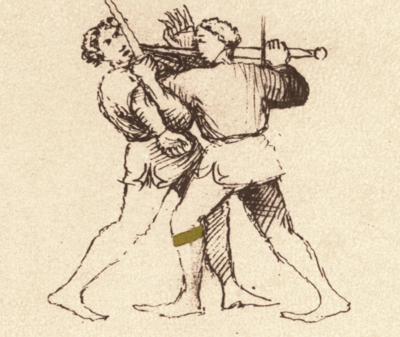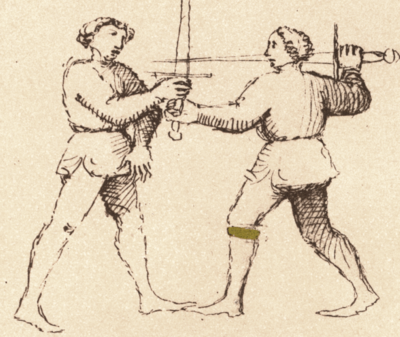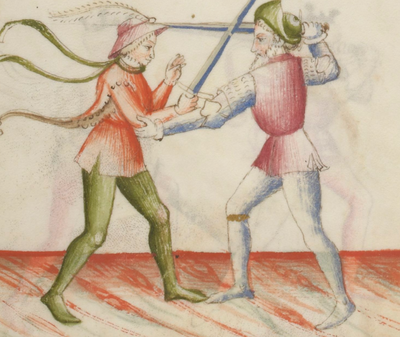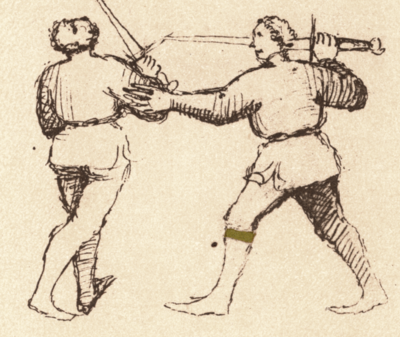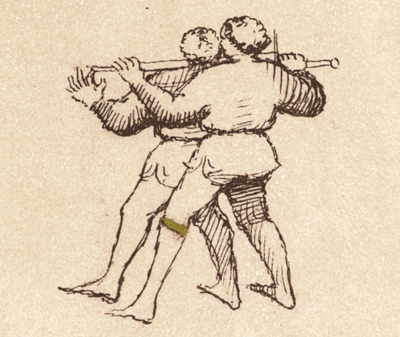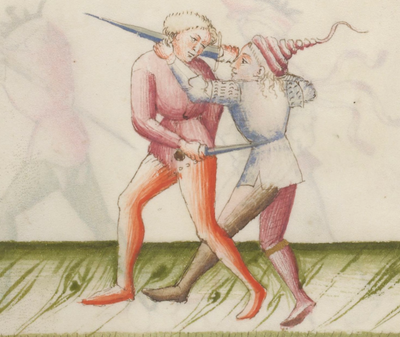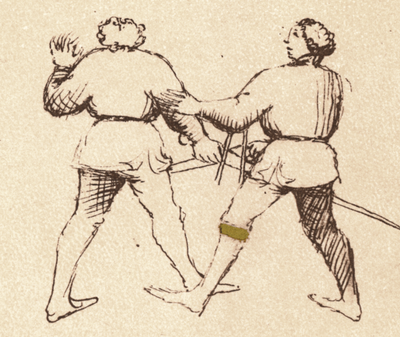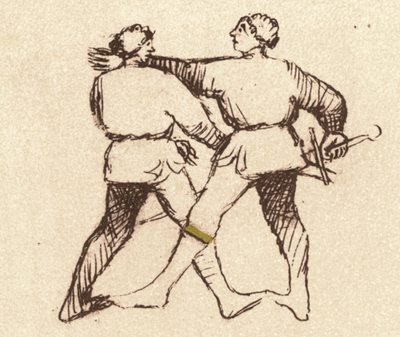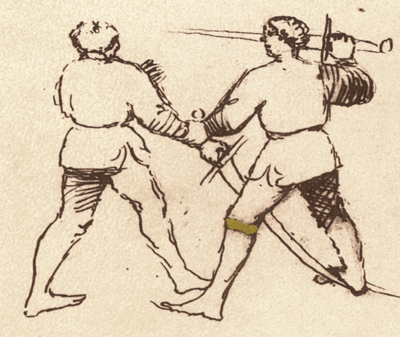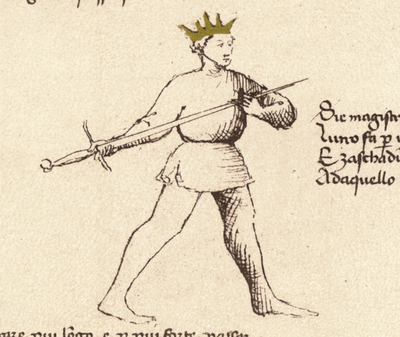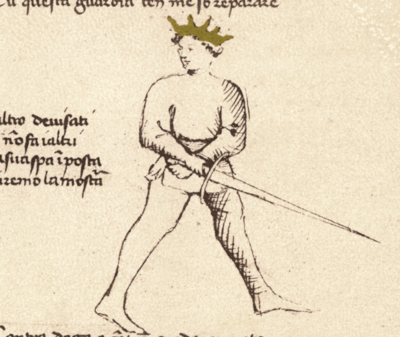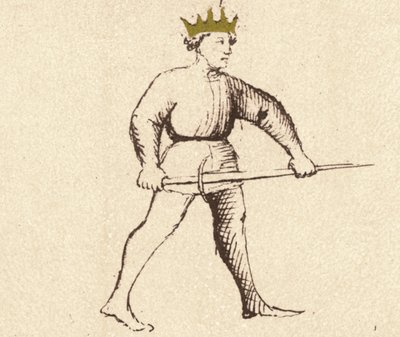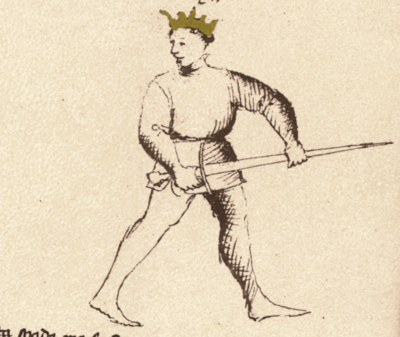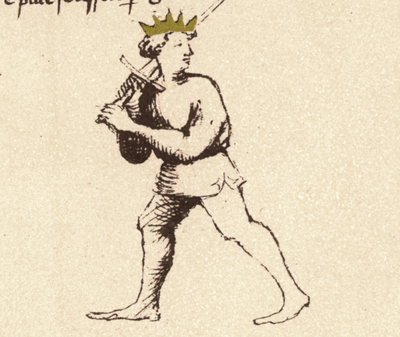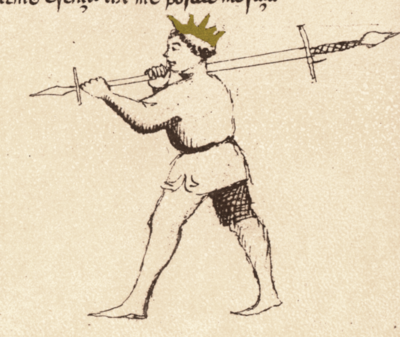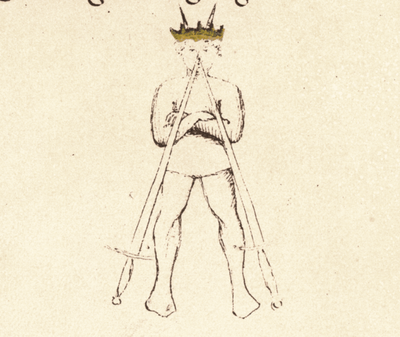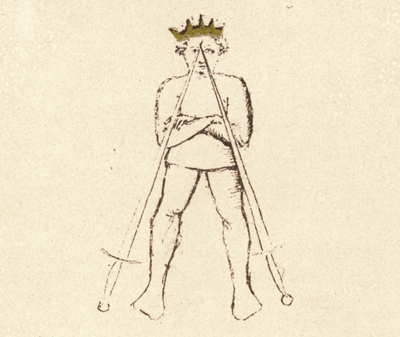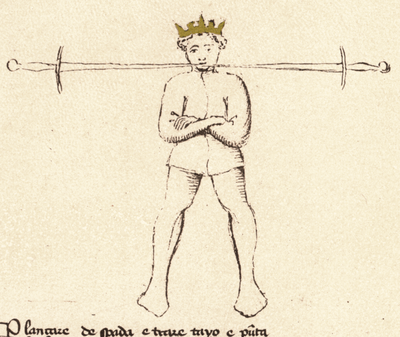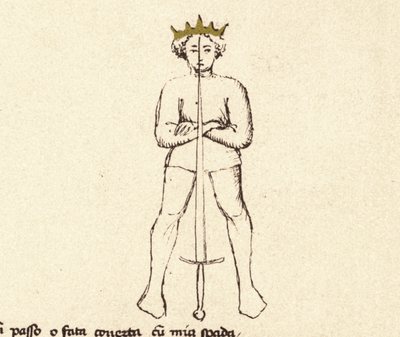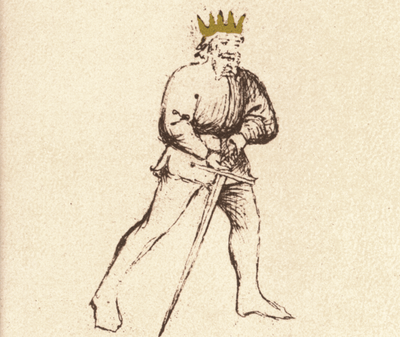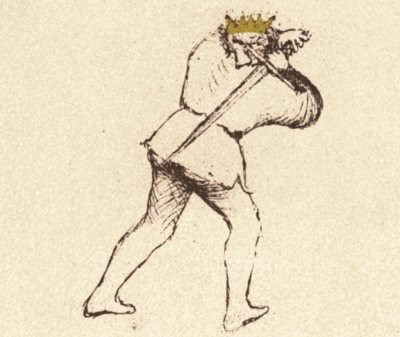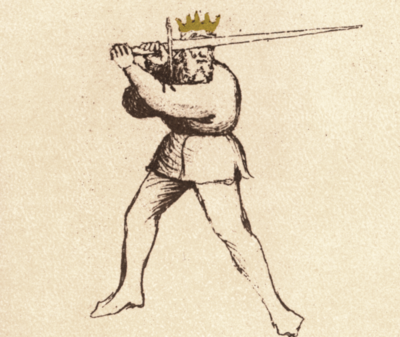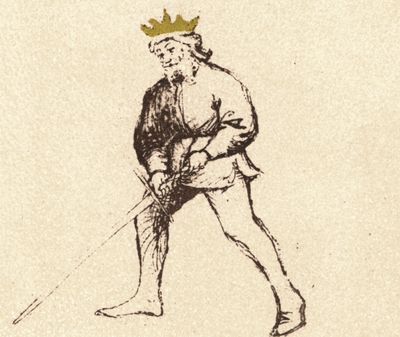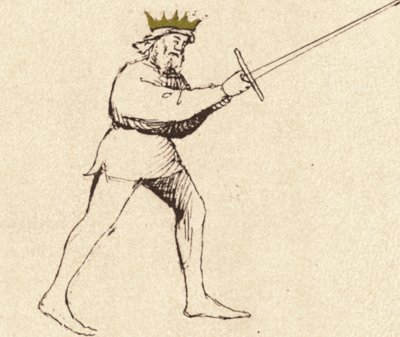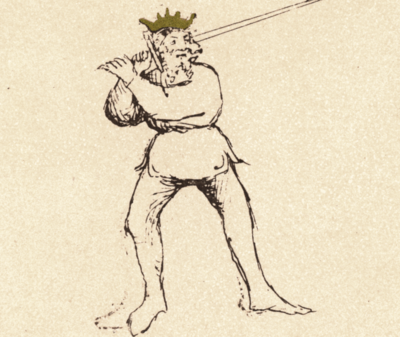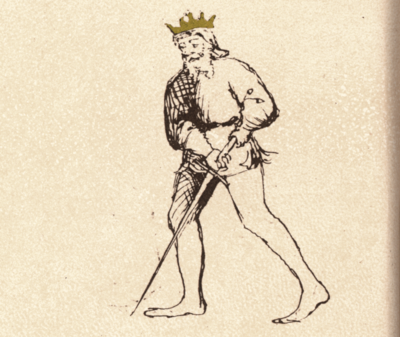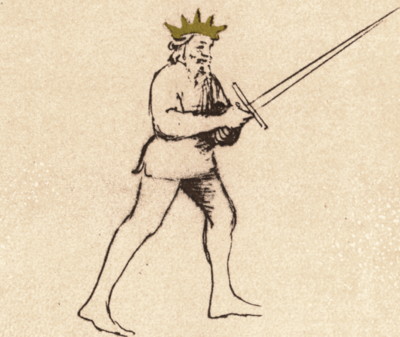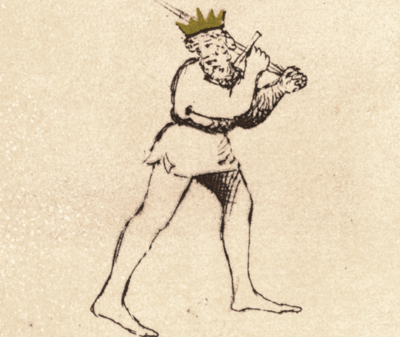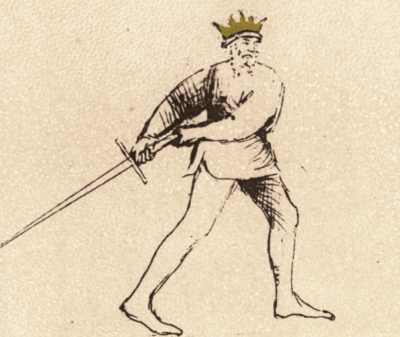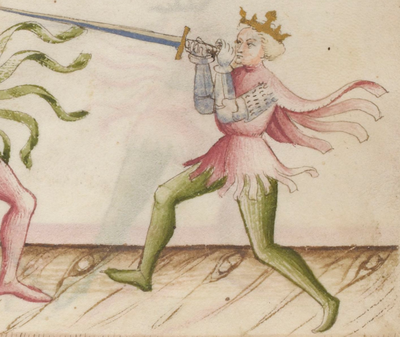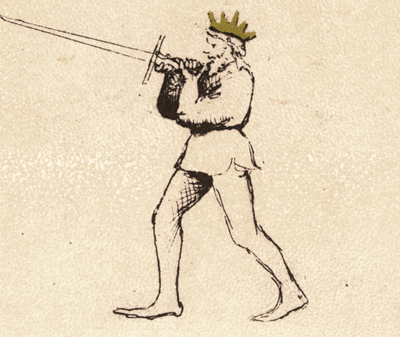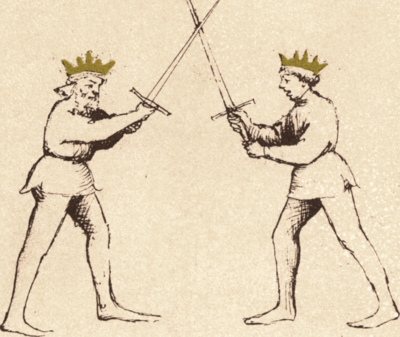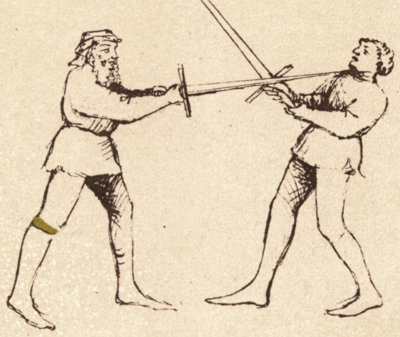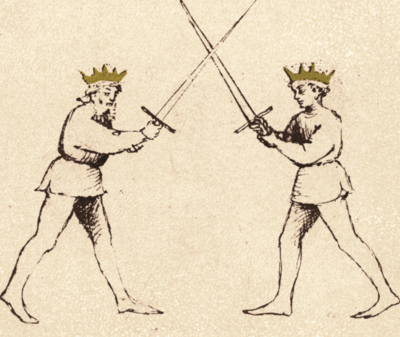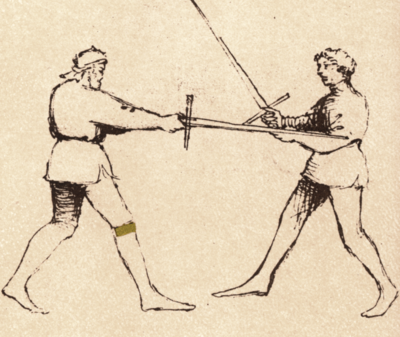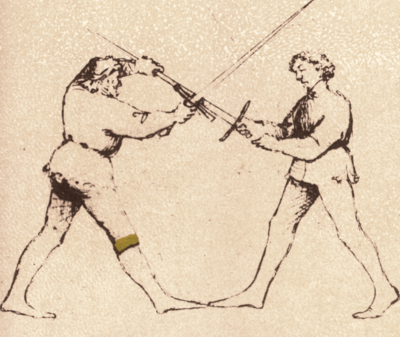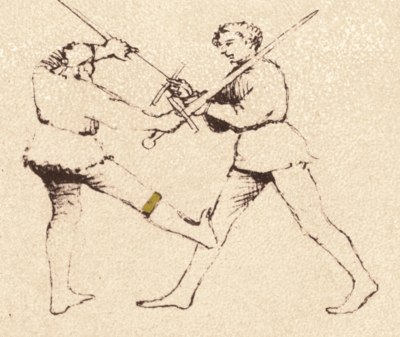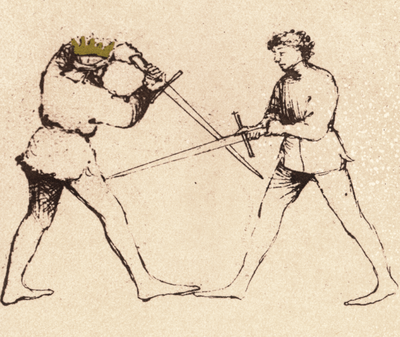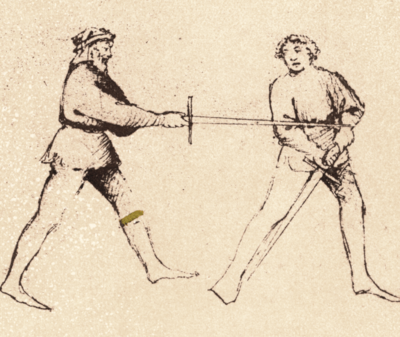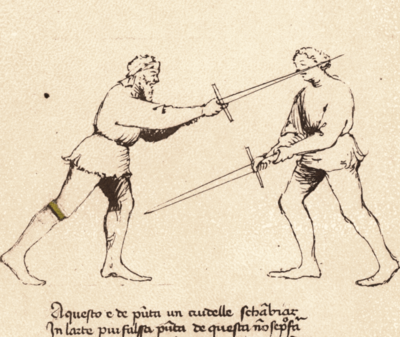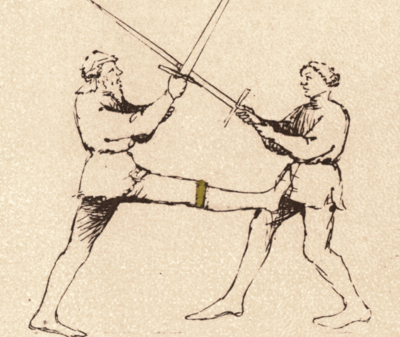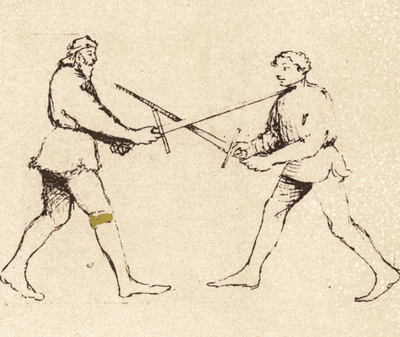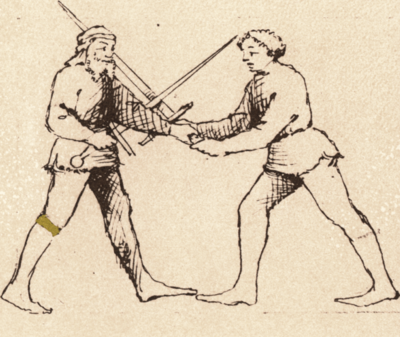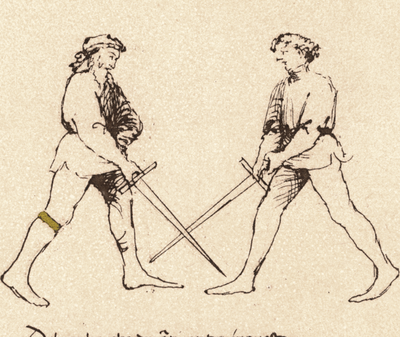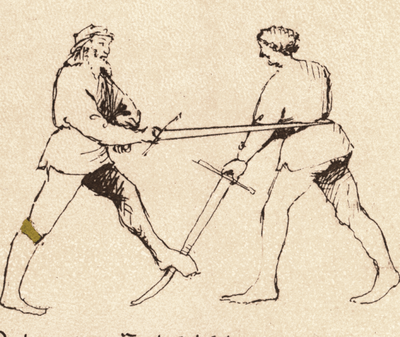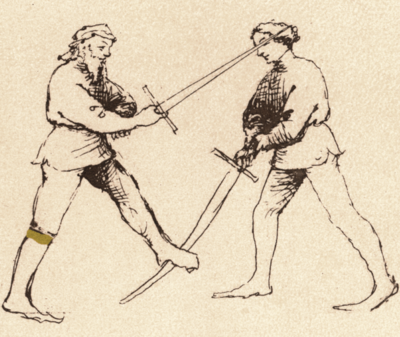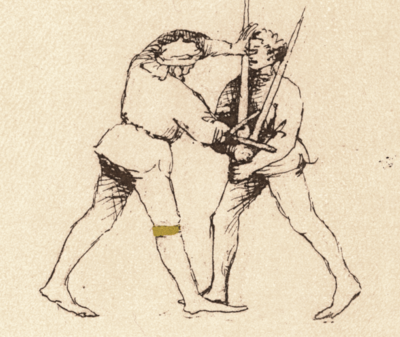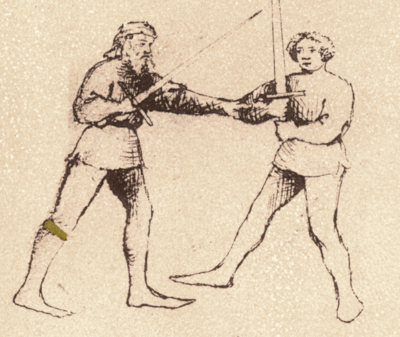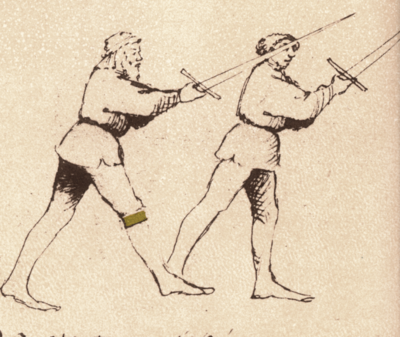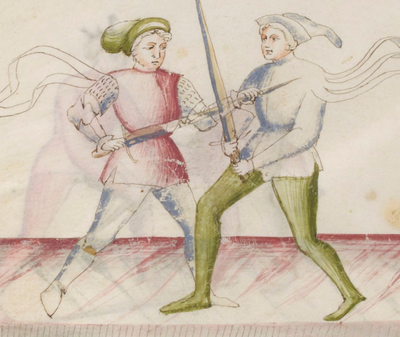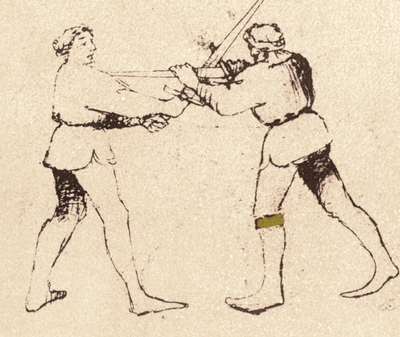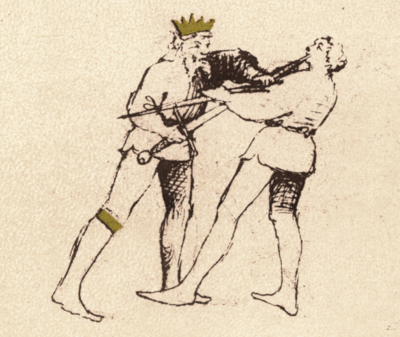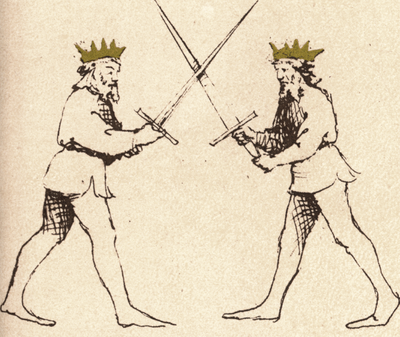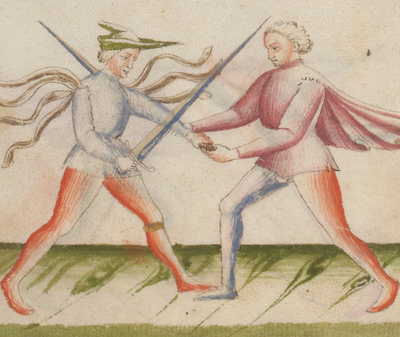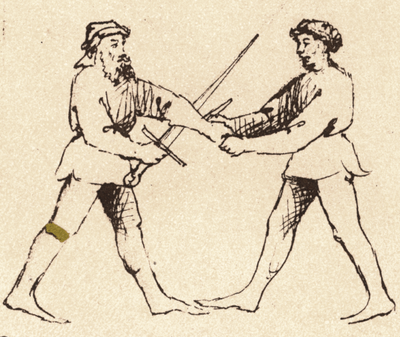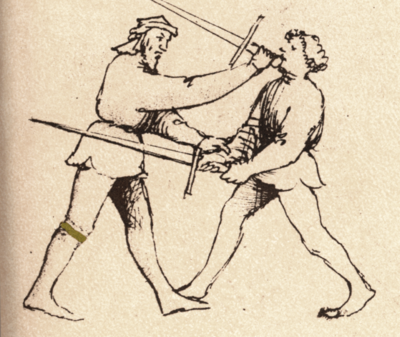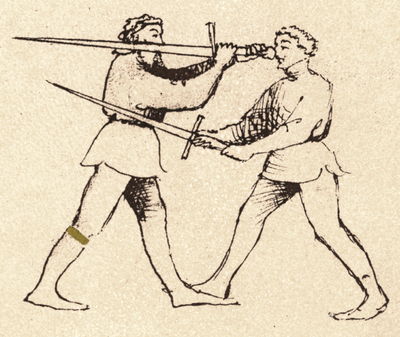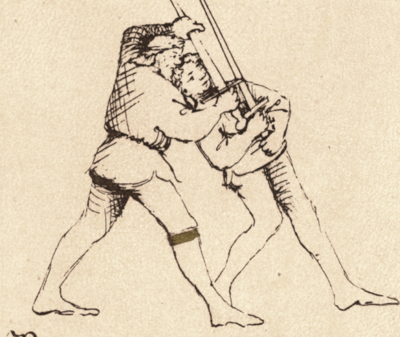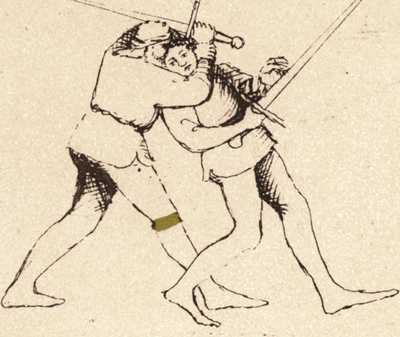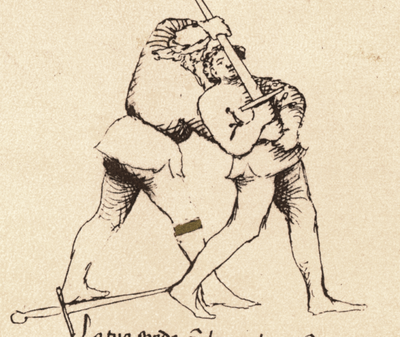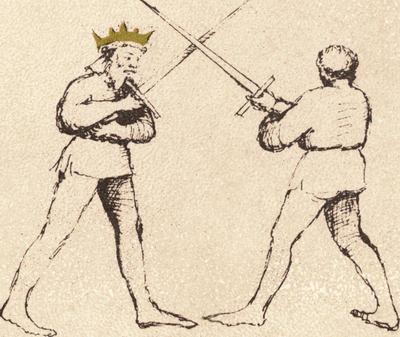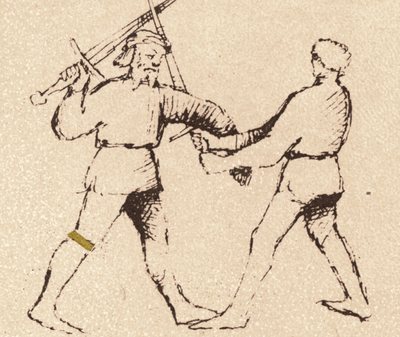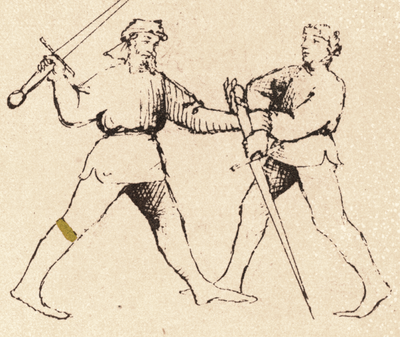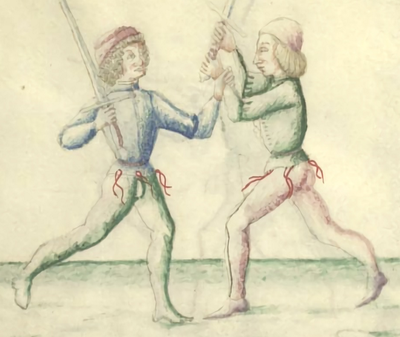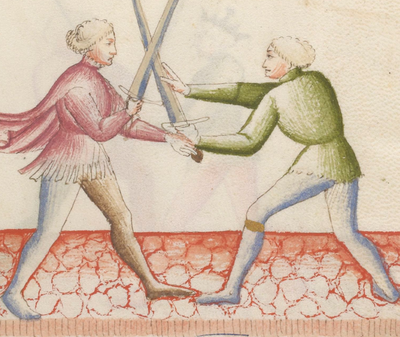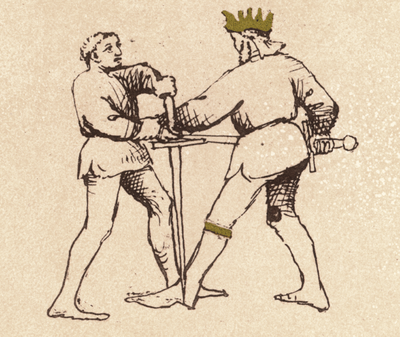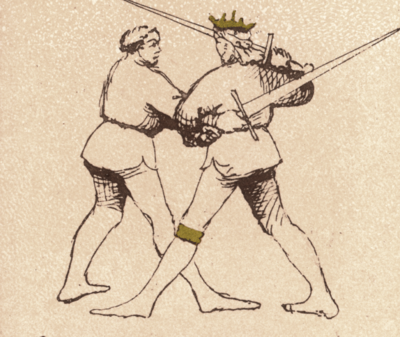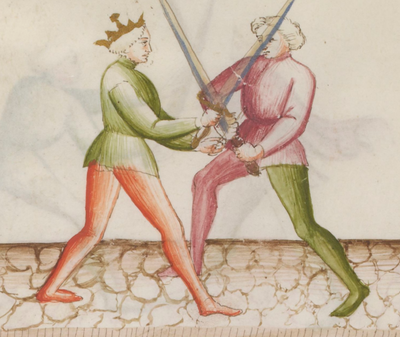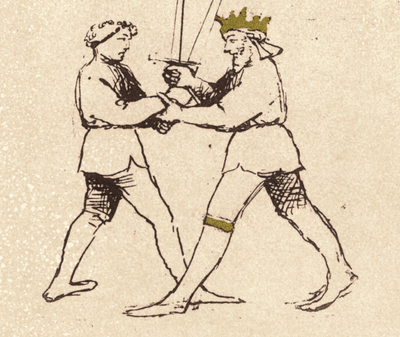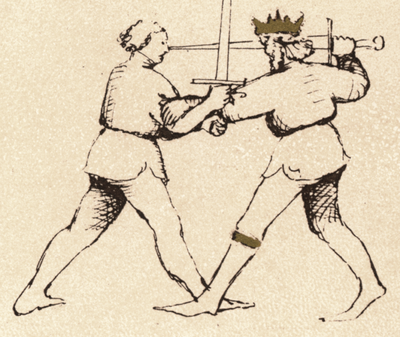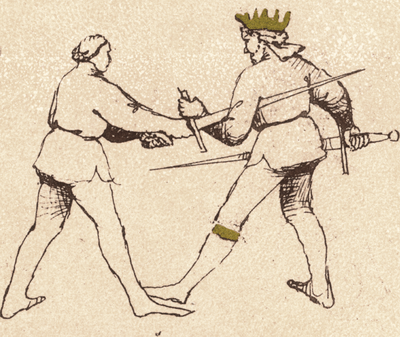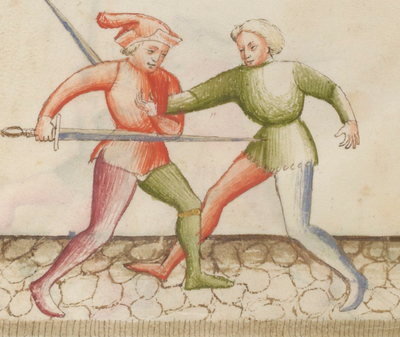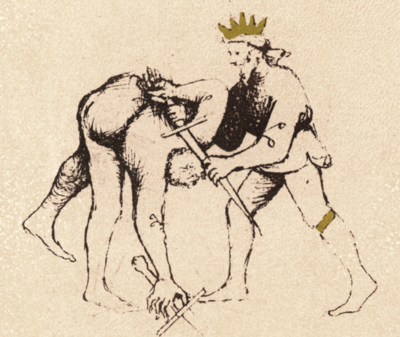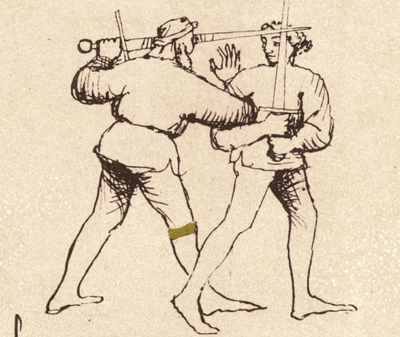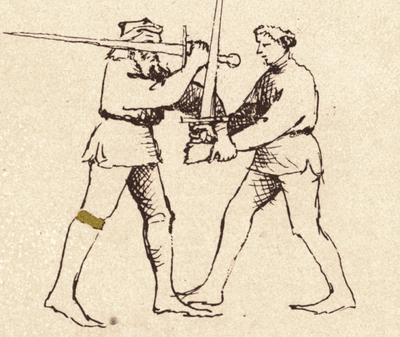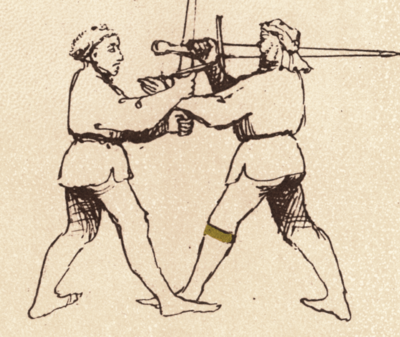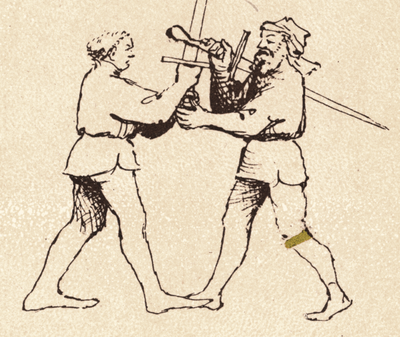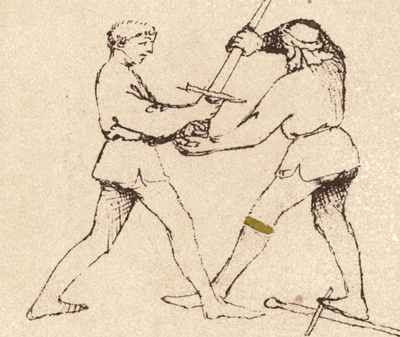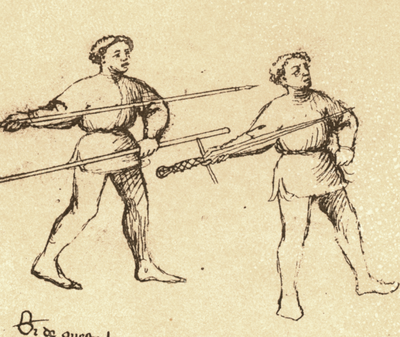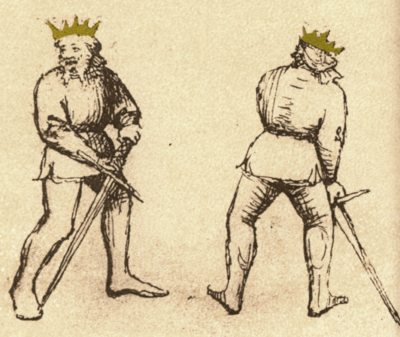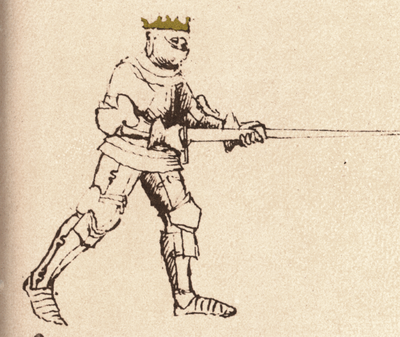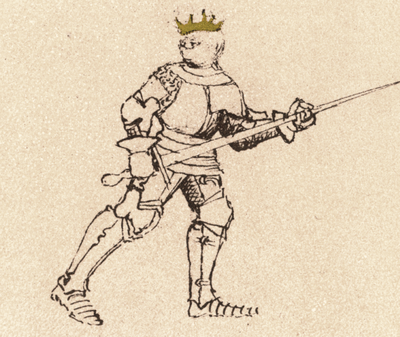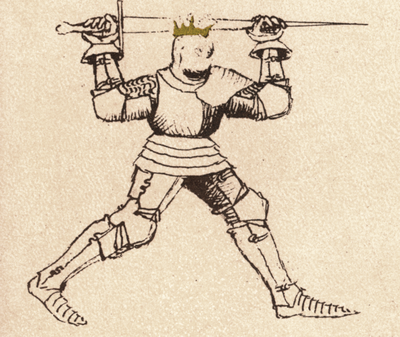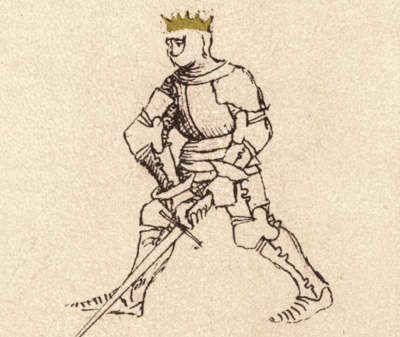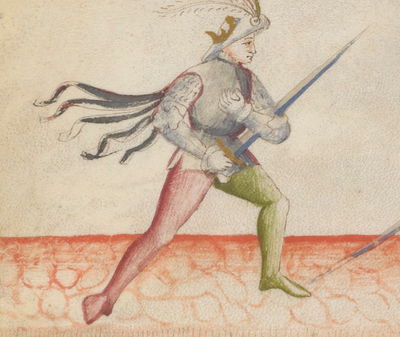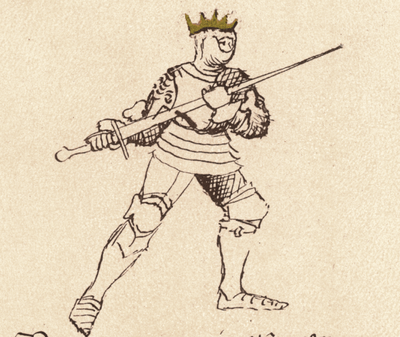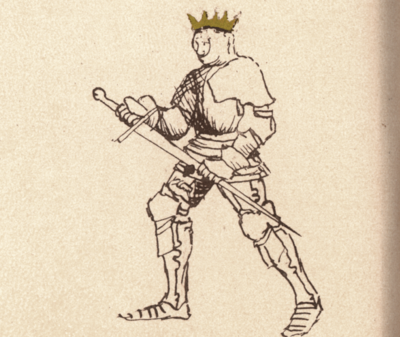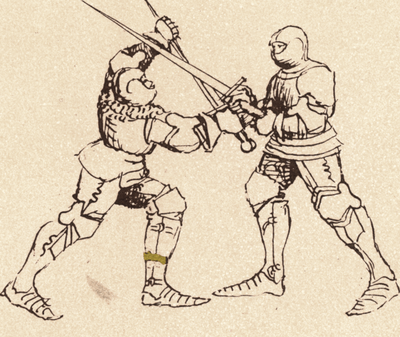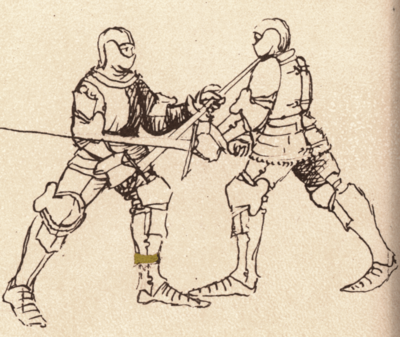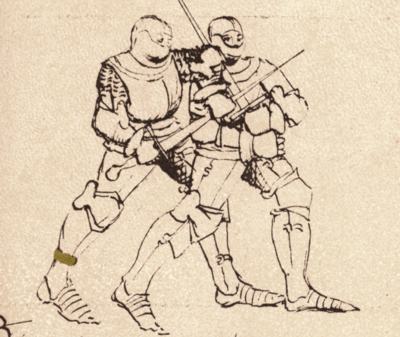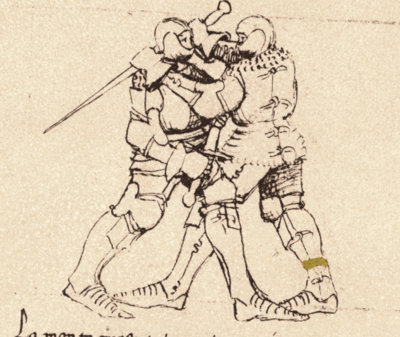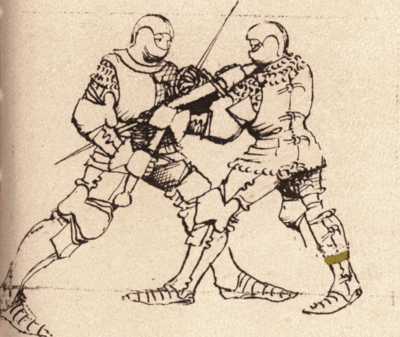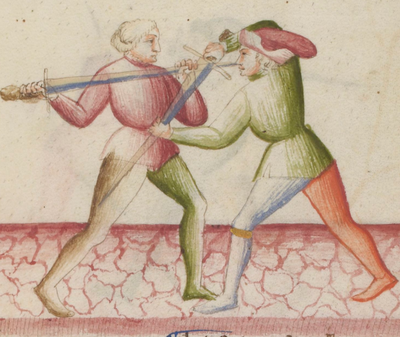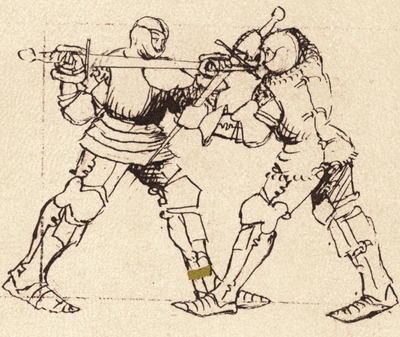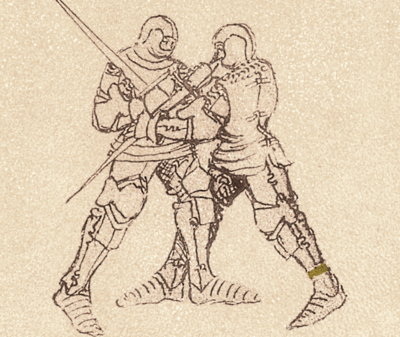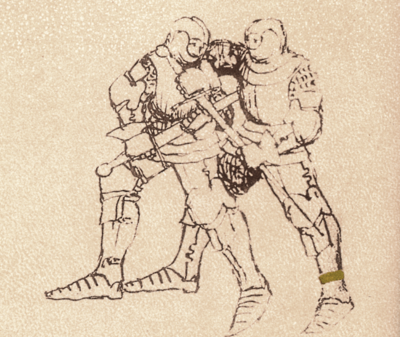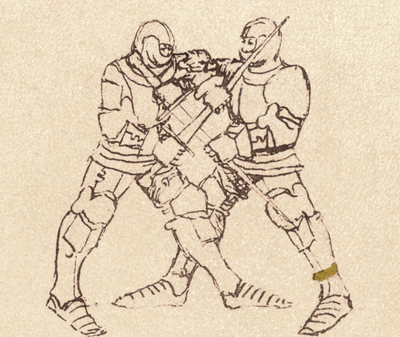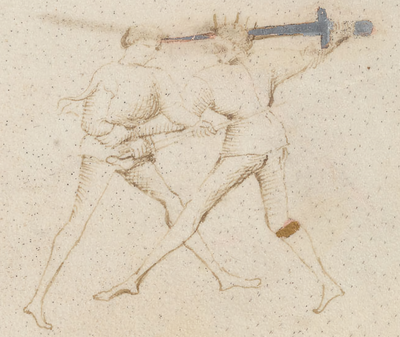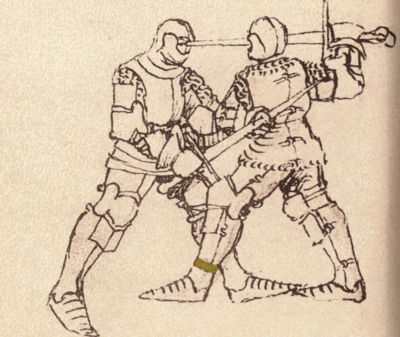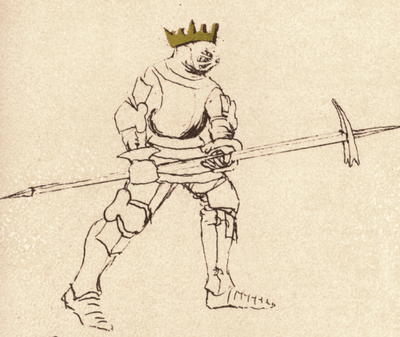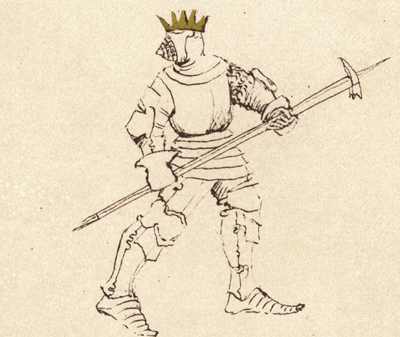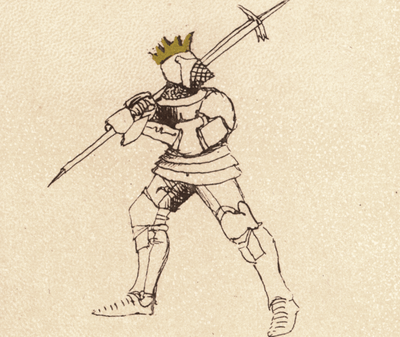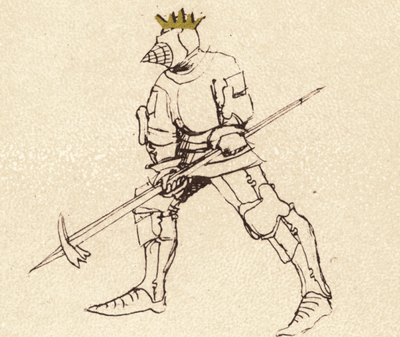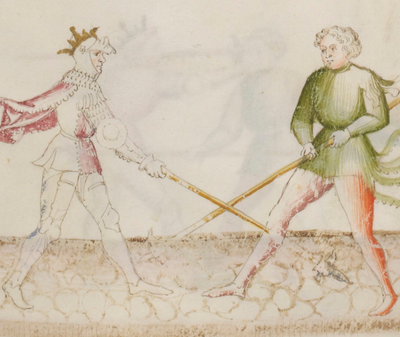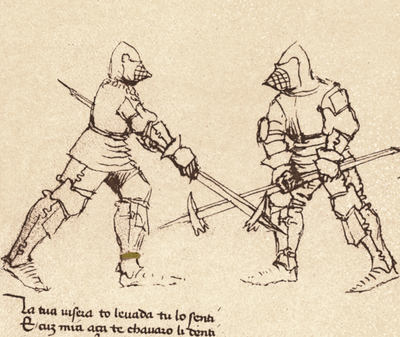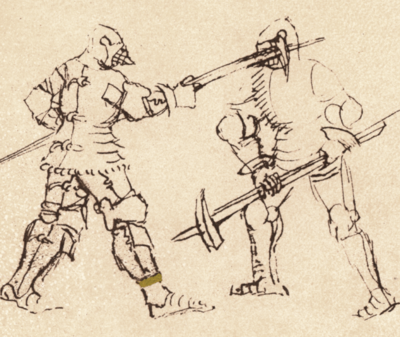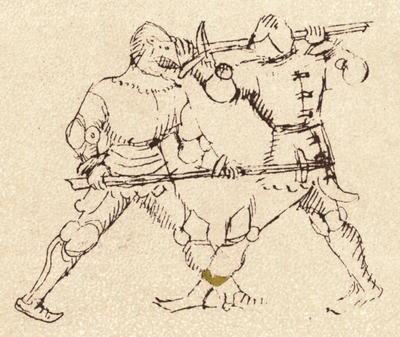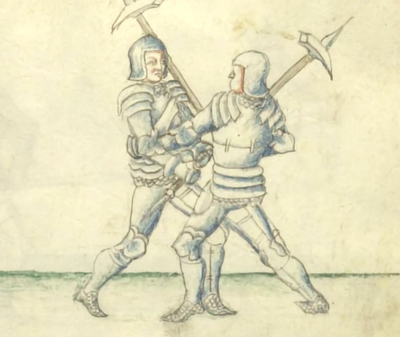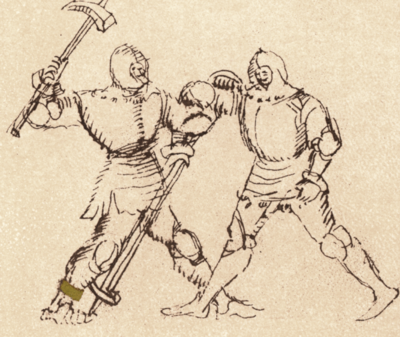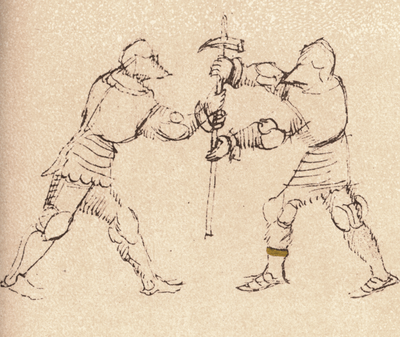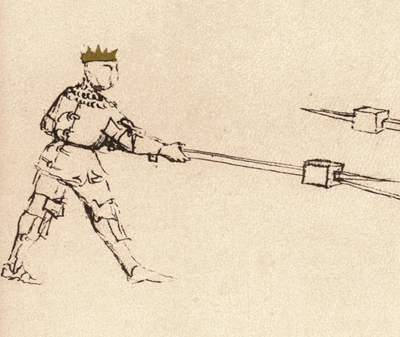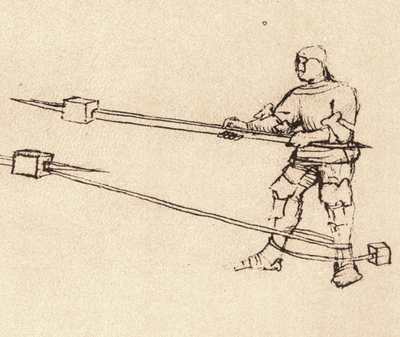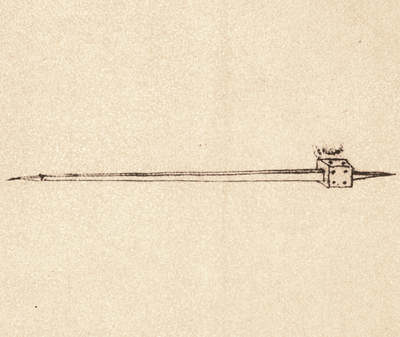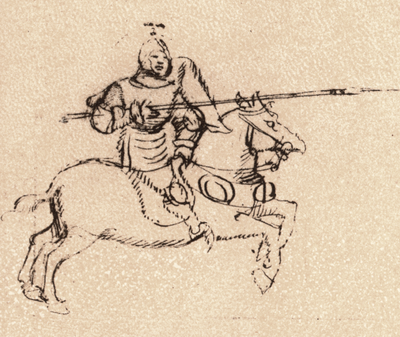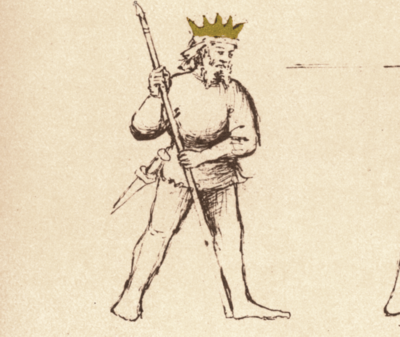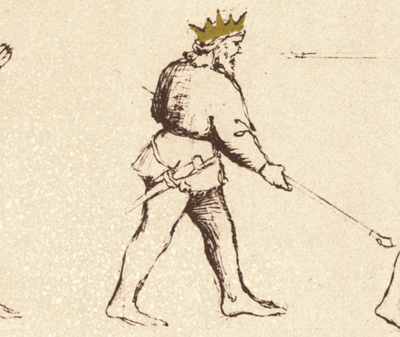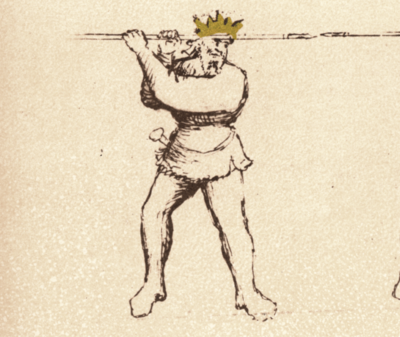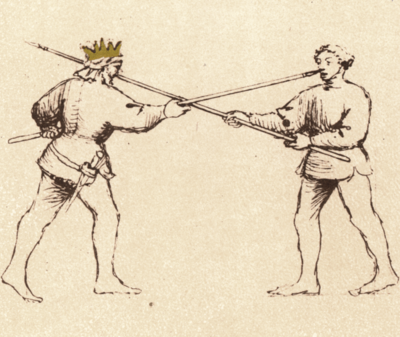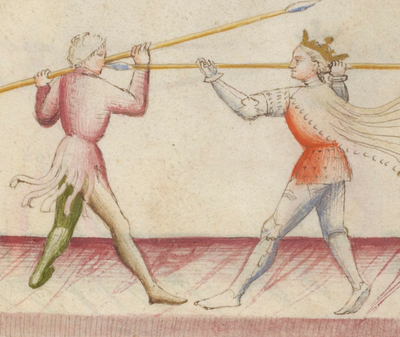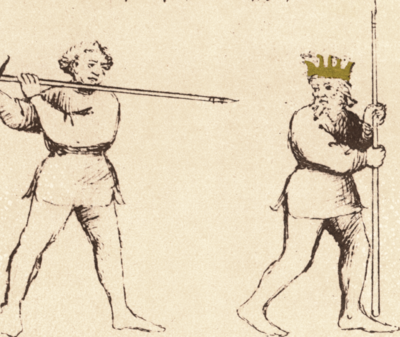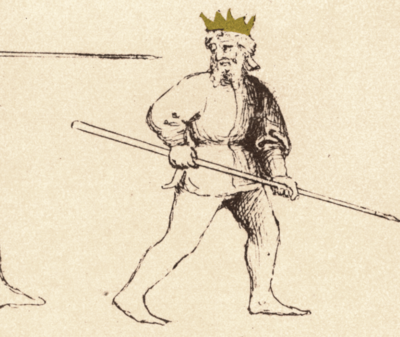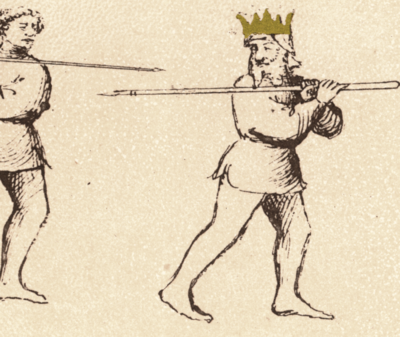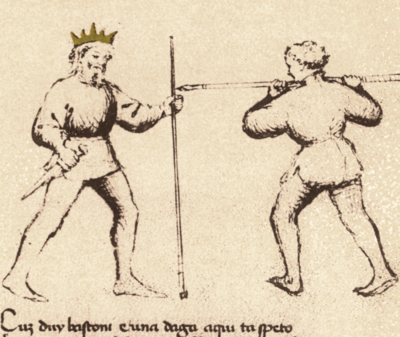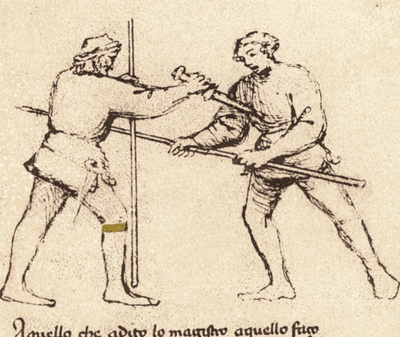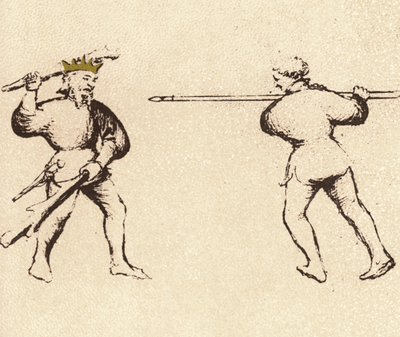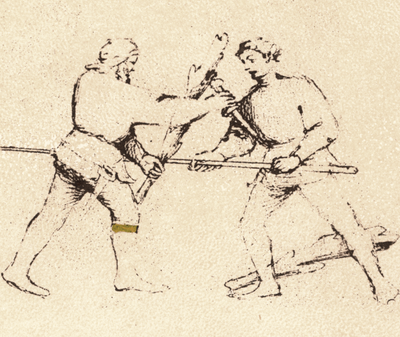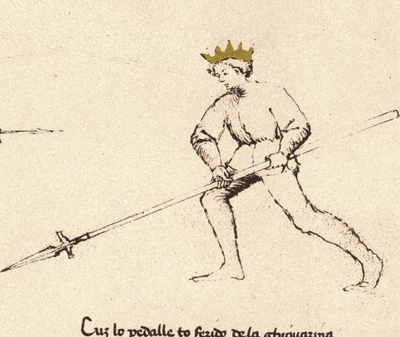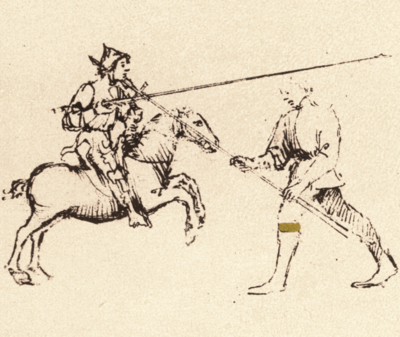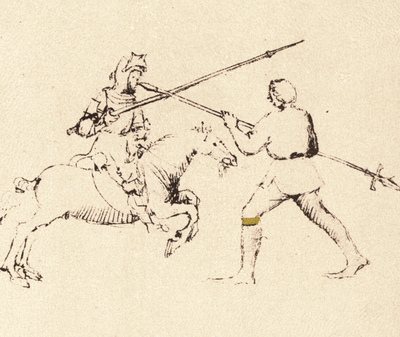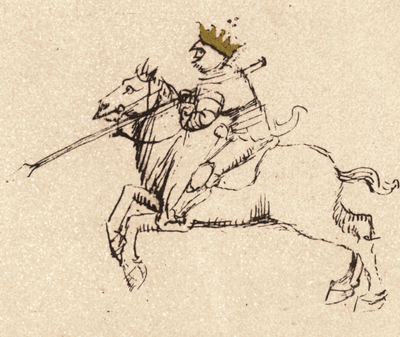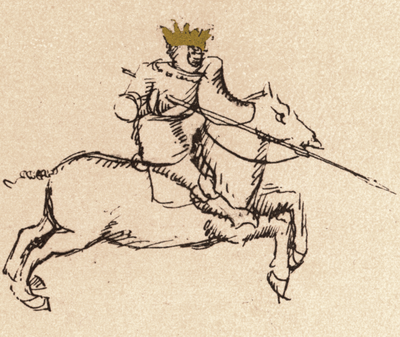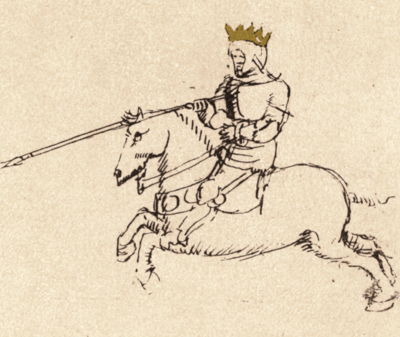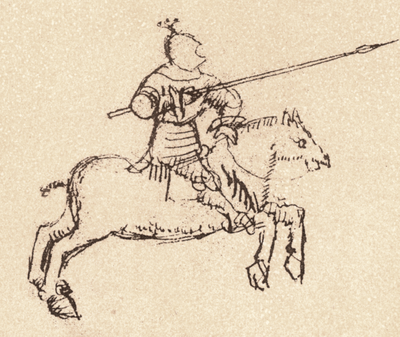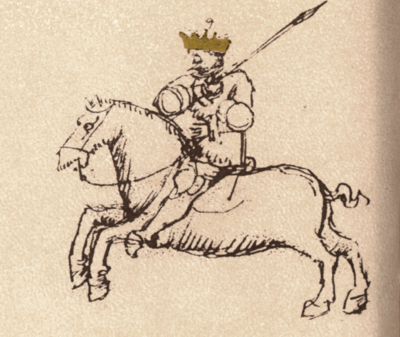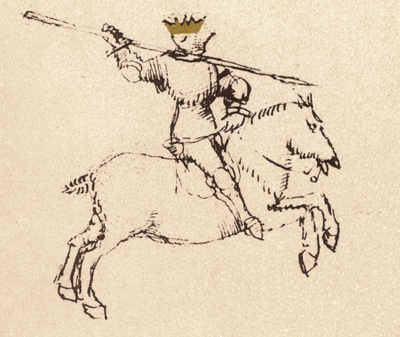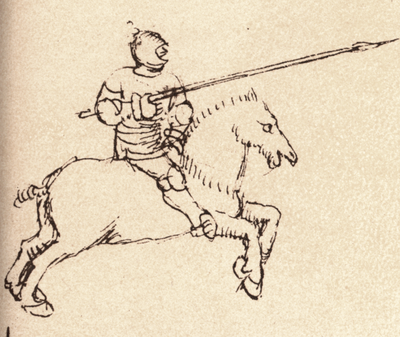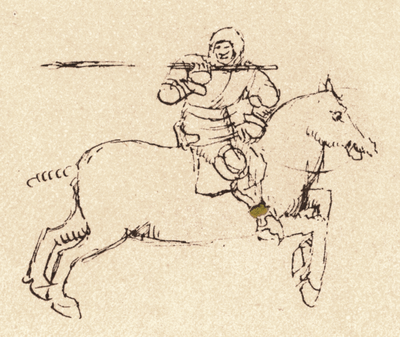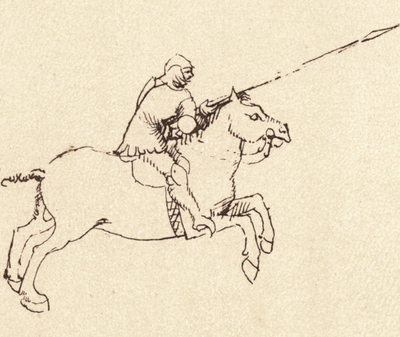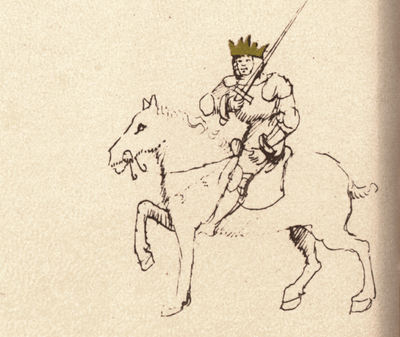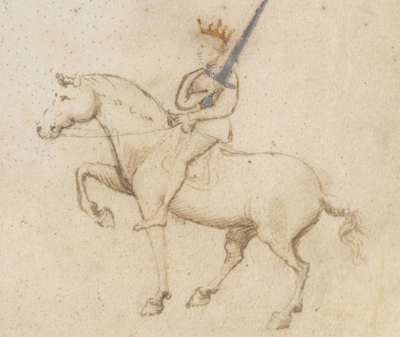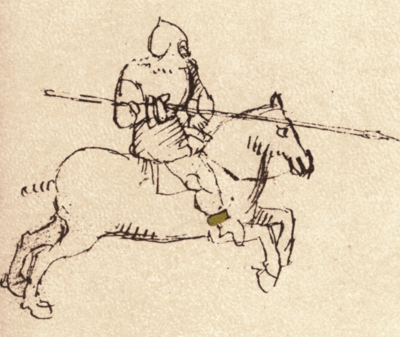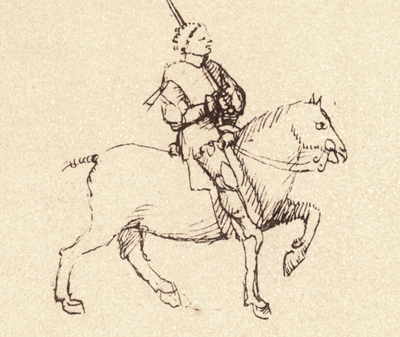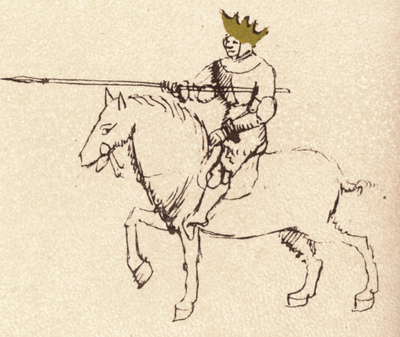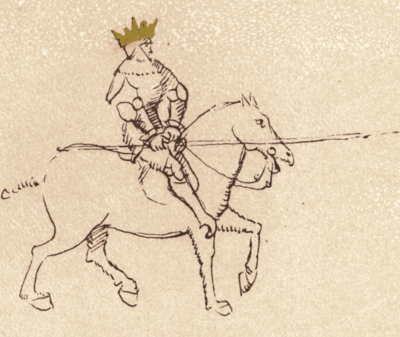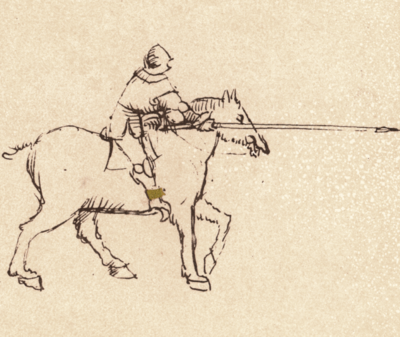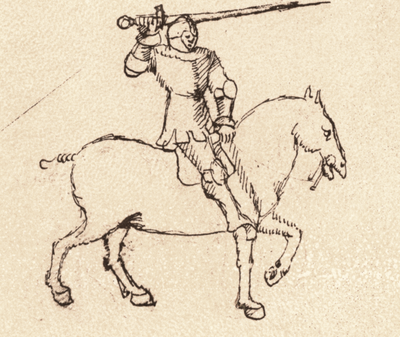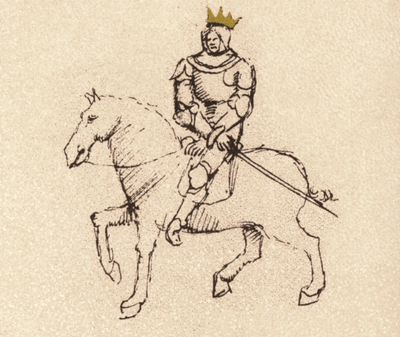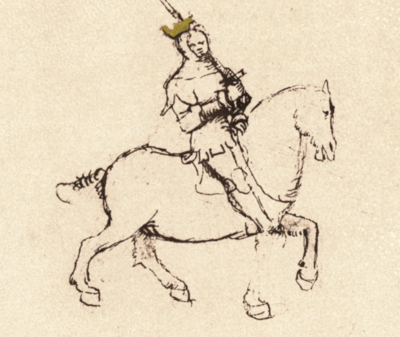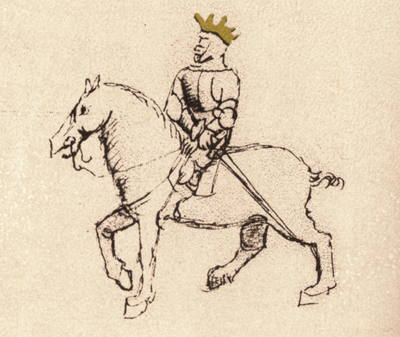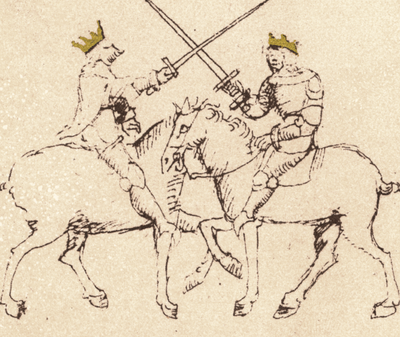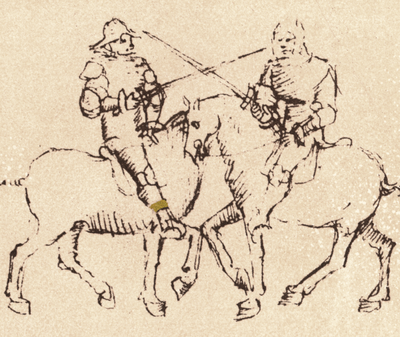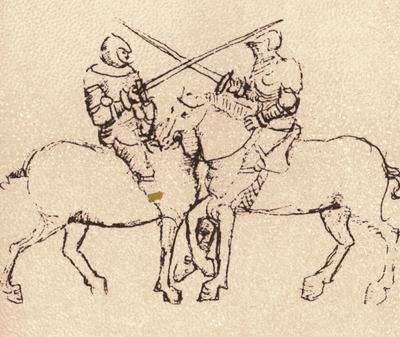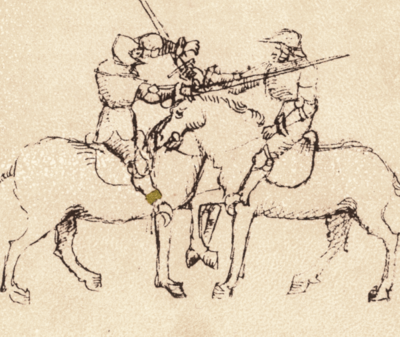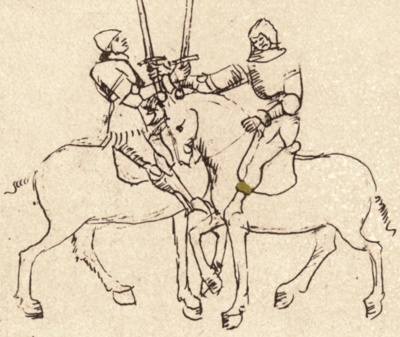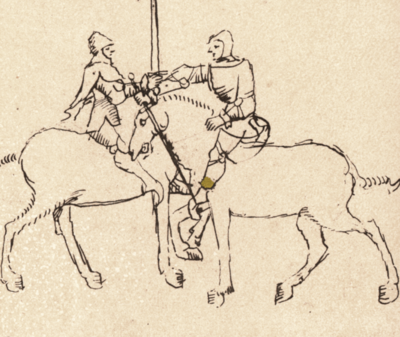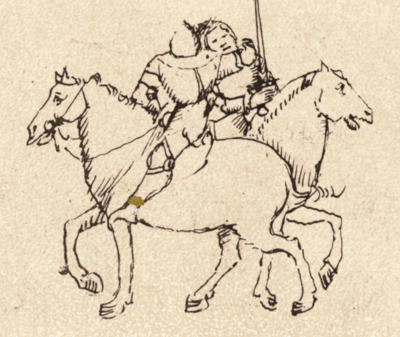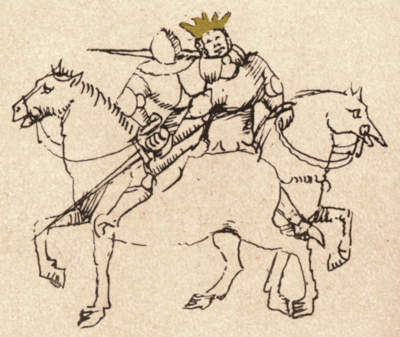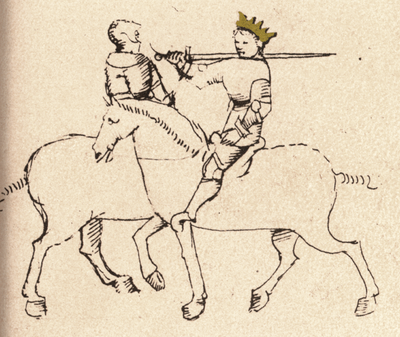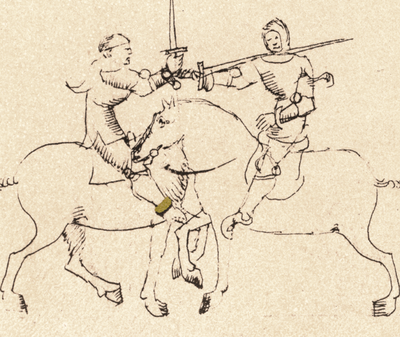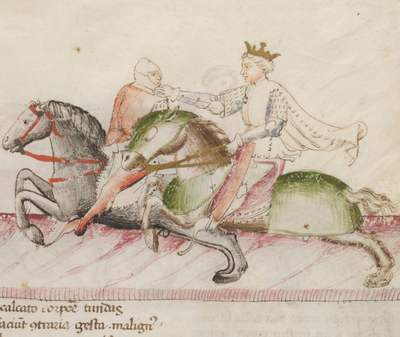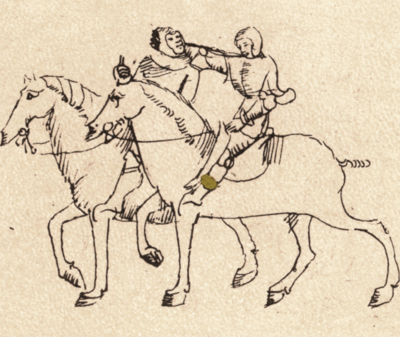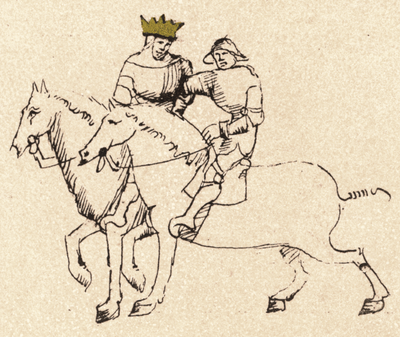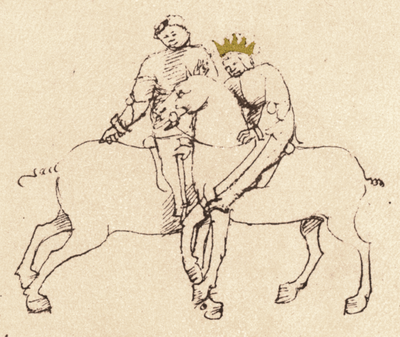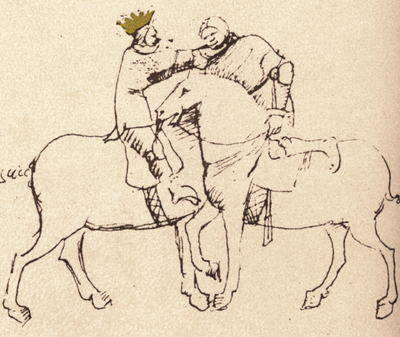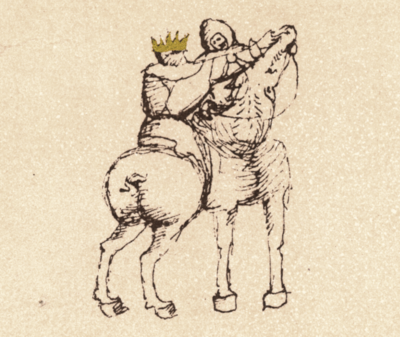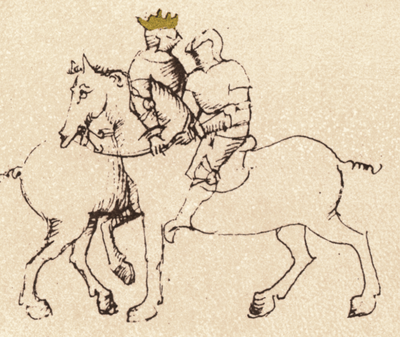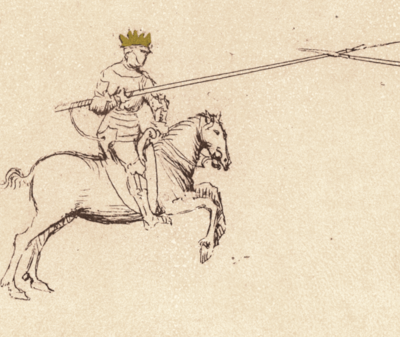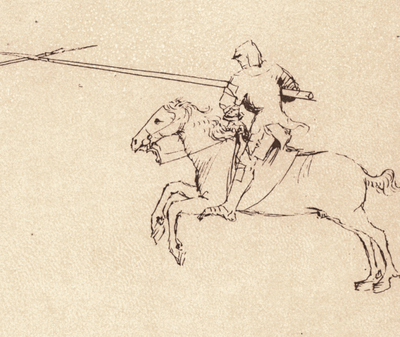|
|
You are not currently logged in. Are you accessing the unsecure (http) portal? Click here to switch to the secure portal. |
Difference between revisions of "Fiore de'i Liberi/Images2"
(Created page with "<div style="width:240em;"> {| class="floated master" |- ! <p>Images</p> ! <p>Images</p> ! <p>{{rating|B|Completed Translation (from the Getty and PD)}}<br/>by translato...") |
|||
| Line 4,243: | Line 4,243: | ||
|- | |- | ||
| | | | ||
| − | | [[File:MS Latin 11269 | + | | [[File:MS Latin 11269 09r-c.png|400px|center]] |
| <p>[7] <em>I have beaten your axe to the ground;<br/>And mine will quickly be thrust in your face.</em></p> | | <p>[7] <em>I have beaten your axe to the ground;<br/>And mine will quickly be thrust in your face.</em></p> | ||
| Line 4,470: | Line 4,470: | ||
|- | |- | ||
| − | | [[File:MS Latin 11269 | + | | [[File:MS Latin 11269 07v-c.png|400px|center]] |
| [[File:MS Ludwig XV 13 39v-d.png|400px|center]] | | [[File:MS Ludwig XV 13 39v-d.png|400px|center]] | ||
| <p>[6] </p> | | <p>[6] </p> | ||
Revision as of 15:44, 4 October 2018
Images |
Images |
Completed Translation (from the Getty and PD) |
Draft Translation (from the Paris) |
Morgan Transcription |
Getty Transcription |
||
|---|---|---|---|---|---|---|---|
| [No Image] | [1] In the name of God and Saint George, we begin our system with Grappling on foot, seeking to gain superior holds. Holds are not superior unless they give you an advantage. Thus we four Masters seek to achieve advantageous holds through the techniques you see depicted here. |
||||||
[2] [The Long Guard] I am ready to show you how I win with my holds, I am Posta Longa and I seek you like this. And in response to the first grapple that you attempt on me I will bring my right arm up under your left arm. And I will then execute the first play of Grappling. And with that lock I will force you to the ground. And if that lock looks like it will fail me, then I will switch to one of the other locks that follow. |
Even if you capture me, I would win; I am truly prepared. |
||||||
[3] [The Boar's Tooth] I seek to reverse the fight, I counter you with Dente di Zenghiaro. And with this move I am sure to break your grip. And from this guard I can transition to Porta di Ferro, which will force you to the ground. And if my plan fails me because of your defense, I will seek other ways to hurt you, for example with breaks, binds and dislocations, as you see depicted in these drawings. |
I seek to shift, <for> which reason I would be able to deceive you well. |
||||||
[4] [The Iron Gate] If you fail to beat me with your skill, I believe I wait for you without moving in Porta di Ferro, ready to grapple with all of my skill. And this guard can be applied not only in the art of grappling, but also in the art of the Spear, the Poleaxe, the Sword, and the Dagger. For I am Porta di Ferro, full of danger. Those who oppose me will always end up in pain and suffering. And as for those of you who come against me trying to get your hands on me, I will force you to the ground. |
If you do not conquer with a trick, I can, of course, believe [that] |
||||||
[5] [The Guard of the Forehead] I advance upon you with my arms well forward I am Posta Frontale, used to get my hands on you. Now if I come against you in this guard, you may lay hands on me. But I will then move from this guard, and with skill I will take you down to Porta di Ferro. Then I will make you suffer as if you had fallen into the depths of hell. And I will serve you so effectively with locks and dislocations, that you will quickly acknowledge my superiority. And as long as I don’t forget my skills, I will gain my superior holds. |
Behold! I am coming, eager to overcome by means of the stretched shoulder, |
||||||
[6] With this move I will either force you to the ground This is the first play of Abrazare and from every grappling guard you can arrive at this play, and from this position, proceed as follows: jam his right inside elbow with your left hand, and bring your right hand up behind and against his left elbow as shown. Now quickly make the second play, that is to say, having gripped him like this, turn your body to the left, and as a result he either goes to the ground or his arm will be dislocated. |
In this way, I, using a capturing, would make you touch the earth. |
||||||
[7] Either I will make you kiss the ground with your mouth, As the Scholar of the First Abrazare Remedy Master says, I am certain to put this man to the ground, either by breaking or dislocating his left arm. And if the Zugadore who fights with the First Abrazare Remedy Master takes his left hand off the shoulder of the Remedy Master in order to make a defense, then I will quickly let go of his right arm with my left hand and instead seize his left leg with my left hand, and grip his throat with my right hand in order to throw him to the ground, as you see depicted in the third play. |
I would compel you, ugly, to lick the ground with your mouth; [In the Paris, the Scholar wears a crown.] |
||||||
[8] And I will put you on the ground on your back, The scholar that came before me speaks truly that from his hold he will force his opponent to the ground or dislocate his left arm. As he told you, if the Zugadore takes away his left hand from the shoulder of the Remedy Master, then the Remedy Master transitions to the Third Play, as you see depicted here. Thus, the First play and the Second play are really one single play, where the Remedy Master forces the Zugadore to the ground with a turn of his body, while in this Third play the Zugadore is thrown to the ground onto his back. |
I would throw you, without pause, into the farthest earth up to the kidneys. |
||||||
[9] Even if you were a master of grappling, This is the Fourth Play of Abrazare, by which the Scholaro [Student] can easily force the Zugadore to the ground. And if he cannot force him to ground like this, he will seek other plays and techniques and use other methods, as you will see depicted below. You should know that the plays and the techniques will not always work in every situation, so if you do not have a good hold, you should quickly seek one, so as not to let your opponent gain any advantage over you. |
In this way, I would make you sink down to the earth using a capturing, [In the Paris, the Scholar wears a crown.] |
||||||
[10] With the grips that I have on you above and below, This grip that I make with my right hand at your throat will bring you pain and suffering, and with it I will force you to the ground. Also let me tell you that if I seize you under your left knee with my right hand, I will be even more certain of driving you into the ground. |
Because of capturing, <by> wrestling above and below [In the Paris, the Scholar wears a crown.] |
||||||
[11] Your hand in my face is well placed, I am the counter of the Fifth Play [10] that is shown earlier. And let me explain that if with my right hand I push up the elbow of his hand that seeks to harm me, I will turn him in such a way that either I will force him to the ground, as you see here depicted, or I will gain a hold or a lock, and so I will have little concern for his grappling skills. [In the Pisani Dossi, the Master is missing his crown.] |
I served up the palms to the face.[2] But still I cheerfully moved |
||||||
[12] By putting my head under your arm, From this hold that I have gained, and by the way I hold you, I will lift you off the ground with my strength and throw you down under my feet head first with your body following. And as far as I am concerned, you will not be able to counter me. |
You, confused one, will be spread on the ground (like a tarp) in sadness and disorder; |
||||||
[13] Because of my thumb pressing under your left ear, When I press my thumb under your ear you will feel so much pain that you will go to the ground for sure, or I will make other hold or lock that will be worse than torture for you. The counter that can be made is the Sixth play [11] made against the Fifth Play [10] when he puts his hand underneath his opponent’s elbow. This counter can certainly be done to me here. |
I but hold this finger to the left ear during wrestling, [In the Paris, the Scholar wears a crown.] |
||||||
[14] With great cunning you grabbed me from behind, You seized me from behind in order to throw me to the ground, and I turned like this. And if I fail to throw you to the ground you will have a lucky escape. This play is a good finishing move, but unless this is done quickly, this remedy will fail. |
<If you>, Traitor, by your art have seized me from behind, |
||||||
[15] This is a grappling move that involves the Gambarola, This is a play that involves a throw over the leg [Gambarola] which is a risky move in grappling. So if you want to make this leg throw successfully, you will need to do it with power and speed. |
Here, meanwhile, the play of turning of legs is discussed. |
||||||
[16] This is a good hold to practice, This is a finishing move and it is a good way to hold someone, because they cannot defend themselves. For the counter, the one who is being held should move as quickly as he can over to a wall or a post and drive himself backwards against it so that the man holding him breaks his head or his back against the aforementioned wall or post. |
By the joint, thought and mind, the capturing is called Outsider. |
||||||
[17] I will strike you so hard in the groin This student strikes his opponent with a knee to the groin to gain advantage in order to throw him to the ground. To make the counter, when your opponent comes in quickly to strike you in the groin with his knee, seize his right leg under the knee with your right hand, and throw him to the ground. |
In this way, <I> myself would destroy your testicles with a hard |
||||||
[18] I'll give you so much pain and suffering to your nose If you seize me with both your arms underneath mine, I will strike with both my hands into your face. And even if you were well armored this would still make you let go. The counter of this play is to place your right hand under the left elbow of your opponent and push hard upwards, and you will be able to free yourself. |
I will redouble so many[3] pains which your nose is suffering |
||||||
[19] No doubt about it, with this move I will free myself This shows how I make the counter to the thirteenth play [18]. As you can see his hands have been removed from my face. And from this hold, if I fail to throw him to the ground I will be worthy of your disdain. [In the Getty, the master grabs the scholar's right elbow rather than his left wrist.] |
I set up your limbs using a similar capturing (and so we demonstrate). [In the Paris, the Master is missing his crown.] |
||||||
[20] I will hurt you under your chin so badly If you come to grips with both your arms underneath your opponent's, then you can attack his face as you see depicted, especially if his face is not protected. You can also transition from here into the third play of grappling. |
And I drag many pains to you below your chin, |
||||||
[21] With your hands in my face you can cause me trouble, This is the counter to the fourteenth play [20], and to any other play where my opponent has his hands in my face while grappling with me. If his face is unprotected, I push my thumbs into his eyes. If his face is protected, I push up under his elbow and quickly move to a presa or a ligadura. [In the Pisani Dossi, the Master is missing his crown.] |
Here, by this twin play, you press the face with the hand. [In the Paris, the Master is missing his crown.] |
Images |
Images |
Completed Translation (from the Getty and PD) |
Draf Translation (from the Paris) |
Morgan Transcription |
Getty Transcription |
||
|---|---|---|---|---|---|---|---|
[1] With a short staff I bind your neck, See how with a short staff I hold you bound by your neck. And from here if I wish to throw you to the ground I will have little trouble doing so. And if I choose to do worse to you I can keep this strong bind applied. And you will not be able to counter this play. |
|||||||
[2] If this short staff play does not put you on the ground, If you were well armored then I would prefer to make this play against you than the previous one. Now that I have caught you between your legs with the short staff, you are stuck riding it like a horse, but you won't be trapped like this long before I turn you upside down onto your back. [In the Getty, the Scholar steps between his opponent's legs.] |
|||||||
[3] I am the Student of the Sixth Remedy Master of the Daga, who counters in this way with his dagger. And it is in his honor that I make this cover with my short staff. And from here I will rise quickly to my feet and I will make the plays of my Master. And this cover that I have made with a short staff can also be done with a hood. And the counter to this move is the same counter shown by my Master [in the dagger section]. [Based on the description, the placement of this image is probably an error and it more likely belongs to the following play.] |
|||||||
[4] I have taken this remedy from the Eighth Remedy Master of the Dagger, and I can defend myself armed only with this short staff. And having made this cover I rise to my feet, and I can then make all of the plays of my Master. And I could defend myself in this way equally well with a hood or a piece of rope. And the counter to this move is the same counter shown by my Master. [Based on the description, the placement of this image is probably an error and it more likely belongs to the previous play.] |
Images |
Images |
Complete Translation (from the Getty and PD) |
Draft Translation (from the Paris) |
Morgan Transcription |
Getty Transcription |
||
|---|---|---|---|---|---|---|---|
| [No Image] | [1] These five figures are the guards of the dagger; and some are good in armor; and some are good without armor; and some are good both in or out of armor; and some are good in armor but not good without armor; and all these are displayed below. |
||||||
[2] [Full Iron Gate, Single]I am Full Iron Gate Single. And I am good in armour and without armour, because I can ward off an attack with or without moving to grapple. And I can play with or without a dagger when I make my covers. |
|||||||
[3] [Full Iron Door, Doubled]I am Full Iron Gate Doubled, and I am good in armour and without armour, but in all situations I am better in armour than without armour, and with a guard like this I cannot use a dagger. |
|||||||
[4] [Middle Iron Gate, Doubled]I am Middle Iron Gate with dagger in hand and I am doubled, and I am better and more strong than any of the others, and I am good in armour and without armour, and I can cover low and high on either side. |
|||||||
[5] [Full Iron Door, Doubled and Crossed]And I am Full Iron Gate with the arms crossed and doubled. And I am like a mighty fortress, and in armour I am especially strong. But without armour I am not sufficient, because I cannot cover long. |
|||||||
[6] [Middle Iron Gate, Doubled and Crossed]And I am Middle Iron Gate doubled and crossed [with dagger]. And I am good in armour but not without armour, because I cannot cover long, but I can cover above and below, from the right and the left, with or without a dagger. |
|||||||
| [No Image] | [7] I am the noble weapon named the dagger who plays at very close range, and he who understands my malice and my art will also gain a good understanding of many other weapons. And since I finish my fight fiercely and quickly, there is no man who can stand against my method. Whoever witnesses my deeds of arms will see me make covers and thrusts as I move to grapple, and will see me take away the dagger by dislocating and binding arms, and against me neither weapons nor armour will be of any use. |
||||||
[8] Everyone should take care when facing the perilous dagger, and your arms, hands and elbows must go quickly against it, to do these five things, namely: take away the dagger; strike; dislocate the arms; bind the arms; and force your opponent to the ground. And never fail to do one or the other of these five things; And may he who seeks to defend himself protect himself in this way. |
|||||||
[9] With the fendente I can strike to the head and the body from the elbow up to the top of the head. But below the elbow I cannot be sure that I can make this strike without danger, and therefore I am reluctant to strike lower. |
|||||||
[10] From the left (reverse) side, you can strike from the elbow to end at the temple of the head. And these are called the colpi mezani (middle strikes). And these reverse strikes from the left cannot be delivered if you are still waiting to make cover against your opponent’s attack. |
|||||||
[11] From the right side you can strike or cover if needed, and your target ranges from the elbows to the temples of the head. And this strike is more safely made from the right side than made from the left side. |
|||||||
[12] The dagger that goes through the middle towards the head strikes below the chest and never higher. And while striking you should at all times make cover with your left hand. |
|||||||
[13] After taking away your dagger, to signify my victoryI hold it in my raised hand in this manner. In my right hand I hold your dagger, and I gained it through my skill, which is so good that if you draw a dagger on me, I will take it from your hand. And I know well how to strike to finish you, no matter what advantage you might have. |
Now sealed with the palm, thus I carry the safe dagger. |
||||||
[14] Because I triumph over those who fight with me,I carry torn-off broken arms as a decoration. I choose to symbolize my skill with the broken arms I carry. And I do not lie when I tell you that I have broken and dislocated many arms in my life. And whoever chooses to go against my art, will find me always ready to use that art against him. |
Whereas I would overcome all which can war with me; |
||||||
[15] Locking the arms of all opponentsIn such a way that none can safely extend their right hand, To show my success I carry a pair of keys in my hand. I am the Master of the unlocking and locking of the arms of those who choose to oppose me. I will cause them great pain and suffering with my techniques of binding and dislocating. And therefore I carry these keys to signify the value of my art. |
Nailing together the arms of all fighting in the region |
||||||
[16] You ask how I force others to the ground under my feet with such prowess,I tell you that because I grapple each man and throw him down; The victory palm is appropriately held in my right hand. You ask how it is that I have this man held under my feet. Thousands have suffered this fate because of my art of Abrazare. And I carry the victory palm in my right hand, because no one can stand up to my grappling skills. |
You ask why I, boasting, ruined so great [a person] with [my] feet: |
Images |
Images |
Complete Translation (from the Getty and PD) |
Draft Translation (from the Paris) |
Morgan Transcription |
Getty Transcription |
||
|---|---|---|---|---|---|---|---|
[17] I am the First Master of the Dagger, full of guile,And with my left hand I will wind the dagger around your arm, And truth to tell I can make many other plays, And my students will do them cunningly. I am the first master and I am called Remedy, because I know how to remedy so well that you cannot harm me whereas I on the contrary can strike you and hurt you. And I cannot make a better play against you than to make your dagger go to the ground, by turning my hand to the left. |
The first master of the dagger, I am called caution itself; |
||||||
[18] If I make a turn around your arm with my dagger,I will strike you in the chest, and it will not be taken from me. I will turn my dagger around your arm. And because of this counter you will not be able to take the dagger from me. And also with this turn I can drive it into your chest without a doubt. |
Truly I sweep the dagger away around your shoulder. |
||||||
[19] With your right arm locked under my left,I can cause you much harm while keeping you trapped. I will lock your arm in the middle bind, and I will do it in such a way that you will not be able to give me any trouble. And if I wish to put you to the ground I will do so with little effort, and you will have no chance of escaping. [In the Getty, the Scholar steps with his left foot in front of his opponent's right, not behind.] |
And behold your right [arm] confined under my left |
||||||
[20] If you wind around my arm and try to lock it in this way,I will put you in the lower bind and this hold will make things hard for you. I make the counter to the play that came before me. You can see the kind of position that I have put him in. I will break his arm or quickly throw him to the ground. |
It is permitted that you hold me pressed hard inward, the lower key having been retained [and] |
||||||
[21] If I can turn this arm of yours,I will make you suffer with a middle bind. This is a good cover from which to take the dagger from your hand, and with this grip I will be able to bind you well. And this art is so effective that if I place my right hand under your right knee, then I will put you to the ground. |
If I myself can now turn the shoulder using the hands, |
||||||
[22] You will not make me suffer in the middle bindWhen I meet you with this counter and make you let go. I make the counter to the play that came before me, so that you will not be able to throw me to the ground, nor take the dagger from me, nor bind me either. You will have to let go, or else you will be quickly stabbed by my dagger. |
You will not make [me] endure in the middle key. But now, |
||||||
[23] This is a play with no counter, and it is inevitable that the player will go to the ground and lose his dagger if the student performs this technique as depicted. And when the player is thrown to the ground, the student can finish him in various ways. |
|||||||
[24] This play is rarely used in the art of the dagger, yet it is an additional defense to know. For after beating aside the attack in this way, the scholar can then strike with a counter to the ribs or the stomach. |
|||||||
[25] This bind is easy for me to doAnd from it I will be able to strike you in the back. I am a counter to the First Dagger Remedy Master. Woe to he who remedies with techniques that allow his left hand to be seized. And from this hold I will be able to drive the dagger into his back. [These two images seem to show the beginning and end of the technique.] |
It is neither labor nor pain to me to make a persistent bind, [The Paris resembles the Getty.] |
||||||
[26] I make the counter-counter to the First Master,For the counter-counter is a fine master. |
|||||||
[27] I make the counter-counter against the First Master,And I will be first to take away the dagger every time. |
|||||||
[28] I counter the First Dagger MasterAnd I will strike your arm from above. [In the Pisani Dossi, the Master is missing his crown.] |
I am of the first king; you retain the dagger, openly |
||||||
[29] I make the counter to the First MasterWith this cover I will hurt him and worse. I am also the counter of the First Dagger Remedy Master, and when his student grips me like this [10], I will strike him, and make him let go. And if he tries to do other plays against me, I will counter him without hesitation. |
I certainly keep the counter of the first master, |
||||||
[30] In the previous counter I told you that you could hurt him and worse;Here I show you how this can be done. This flows from the counter referred to in the previous play. It also flows from the counter referred to two plays back [10], where the Counter Remedy Master has trapped the hand of his opponent with his dagger, and where he told you that he can drive the dagger into his opponent’s back. My play comes from that play, but where he says you drive the dagger into your opponent’s back, I drive it into his chest. But this still flows from the previous play, even though I choose to finish it differently. [In the Getty, the Master's right foot is outside (in front) of his opponent's left foot.] |
Using a counter to the former, which threatens many evils, |
||||||
[31] I am well placed and positioned to force you to the ground;If you do not know the counter, I will throw you down immediately. I am the student of the first Master of [Dagger] Remedies. And with this grip I seek to take your dagger and bind your arm, and since I do not believe that you know how to counter me, I will do this to you without delay. [The Getty resembles the Paris. These two images may show progressive stages of the technique.] |
I am ready now to beat you, gloomy, into the ground. |
||||||
[32] I make the counter like this,And I know well how to strike you from here. I counter you like this, so that you will neither take my dagger nor bind my arm, and my dagger and I will remain at liberty. And then I will be able to strike you when you let go of me in such a way that you will have no defense. |
Now I do this counter quickly; you see duly just as it were. |
||||||
[33] To make a much stronger cover I cross my arms in this manner;And from here I can do all the previous remedies. This cover is known to be much stronger and I make it so as to be able to obstruct you with various plays. And you cannot overcome such a strong cover, because two arms can easily oppose one arm. |
I cover myself using great bodily strength, as you see the movements. |
||||||
[34] With this counter the previous cover will meet with failure;After I have made you turn I will strike you with my dagger. This is the counter to the cover that came before, that I told you was much stronger. And I will turn him with my left hand. Having turned him, I will not fail to strike him. |
Now, by means of this counter, I cheat the earlier plays |
||||||
[35] Since my Master’s technique will not fail me,I will break your arm over my shoulder. With this excellent presa that I have made against you, I will not fail to break your arm over my left shoulder. And afterwards I can strike you with your own dagger, since this play will not fail me. |
Because of how that master now brings about the taking, |
||||||
[36] You will not break my arm over your shoulder,For with my counter I will throw you to the ground. I make this counter to you who in the previous play intended to break my arm over your shoulder. I will throw you to the ground to your death with great force and you will cause me no further injury. |
|||||||
[37] Your dagger will quickly be taken from you,When I twist it upwards close by your elbow. I am in a good position to take the dagger from your hand, and to do it I push the point upwards, close to your elbow. And you will lose it, and I will quickly strike you with it. I took the dagger in this way because I was not able to bend your arm. |
I seize the dagger using a sudden violent whirling motion near the elbow; |
||||||
[38] My dagger will not be taken by your turning it,And I will strike you with it without fail. I make the counter of the play that came before, so that you will not be able to take my dagger in that way. I will press my dagger into your hand, to make you let go, and with the cruel point I will strike you for your trouble. |
|||||||
[39] I will have no problem making you fall to the ground,But you will have a major problem trying to get up. In this way you will be driven into the ground, and you will not be able to make any defense or counter. And I will quickly make the dagger that you hold in your hand go far from you, because of my skillful knowledge of this art. [In the Getty and Paris, the Scholar steps outside of his opponent's right leg.] |
It is not any work to me, laying you out fallen. |
||||||
[40] I do not want to fall to the ground with the previous play,So with this grip I will take away all of your strength. What you plan to do cannot always be done. I am the counter of the scholar who came before, and this counter will make him look very foolish, because in this way I will make him let go my leg. And I will drive the dagger into his face to demonstrate that he is indeed a great fool. [In the Pisani Dossi, the Master is missing his crown.] |
Images |
Images |
Completed Translation (from the Getty and PD) |
Draft Translation (from the Paris) |
Morgan Transcription |
Getty Transcription |
||
|---|---|---|---|---|---|---|---|
[41] And I make cover with arms crossed, I play with my arms crossed, and can make all the remedies that were previously shown. And if we were both armoured, you could not make a better cover. No other crowned [Dagger] Remedy Master makes a stronger cover than I, for I can play both to the right and to the left, and I can cross from both underneath and from above. |
|||||||
[42] You won’t be able to make the plays that came before, nor the plays from the backhand strikes [that follow], I counter the [Dagger] Remedy Master who made the cross before me, so he will not be able to cause me any problems with his crossing. I will give a push to his elbow to make him turn, and then I will quickly strike him. |
|||||||
[43] Take the dagger, dislocate your arm, bind you, I believe that this very strong grapple is fatal to anyone, because I can break your arm, throw you to the ground, or take your dagger. I can also hold you bound in the upper bind. And as a result of these four things, you will be unable to get away. |
|||||||
[44] As for the four plays you mentioned, you won’t be able to do any of them to me, I know the counter to the previous play. And with this grapple I will counter all four of the plays he said he could do before. And as soon as he sees me, I will throw him to the ground, for this grapple is strong and fierce. |
|||||||
I certainly cover myself during wrestling using arms as in the cross. |
|||||||
By this counter your covering is refuted; and behold: |
Images |
Images |
Complete Translation (from the Getty and PD) |
Draft Translation (from the Paris) |
Morgan Transcription |
Getty Transcription |
||
|---|---|---|---|---|---|---|---|
[45] Here begin the powerful plays of the backhand attack,[7]Through which many have been killed. And the plays of my scholars will follow, And so we begin the defense to the backhand attack.[8] |
|||||||
[46] With this play of the Master, your dagger will be takenAnd I will strike you a mortal blow. |
|||||||
[47] Here I believe I will throw you to the ground.First I will do this to you, and then I will do worse to you. Here begin the plays of the reverse strikes,[9] through which countless men have lost their lives. And the plays of my scholars will follow, demonstrating the cover made with the right hand. This play depicted is easy to do, and in this way I will throw this man into the ground. [In the Getty, this Scholar is the Master.] |
I believe you, treacherous one, will now indeed touch the earth. [In the Paris, this Scholar is the Master.] |
||||||
[48] You will go to the ground because of your lack of knowledge,And in armour this is a particularly safe throw. With this method you will be driven into the ground. And I could not make a safer throw, being armoured. But even without armour, there is nothing you can do. And even if you were strong and powerful, I would still be able to do this to you. |
You, incautious one, will touch the earth with [your] chest prostrated. |
||||||
[49] This leads to a broken ruined arm,As you will find out when I have you in this hold. You will go to the ground and your arm will be dislocated by the skill of my crowned Master. And there is not one counter that you can do to me, for I hold you like this… |
Each is able to break the shoulder of the associate in wrestling, as I comprehend. |
||||||
[50] I will have no trouble dislocating your armAnd I will easily take your dagger from you. …and will make you suffer greatly. |
|||||||
[51] This is another powerful dislocationFrom which I will be able to kill you with your own dagger. This is a lock that has no counter and no defense. And in this way I can take your dagger, and it will be no trouble to bind or dislocate your arm. You will not be able to get away without my permission. And I can ruin your arm if I choose. |
He was able to dislocate[10] the shoulder of any companion for himself, |
||||||
[52] I take your dagger as I wish,And now if I choose, I can bind you in the lower lock. You will lose your dagger by the way I hold you. And after taking your dagger I can bind you. and make you suffer in the lower lock, which is one of the key binds, and which I will use on you. And whoever is put into this lock cannot escape, because of the great pain and suffering they will be forced to endure. |
I now take hold of your dagger, nor can I be mistaken. |
||||||
[53] I will turn your dagger upwards with my right arm,And I will quickly bind you in the lower lock. |
|||||||
[54] This is called the strong lower lock,And it is a bind with a great risk of death But this lock, truth to tell, If not properly applied can be escaped from. This is called the lower lock, also known as the “strong key”, and from this bind I can kill you, whether you are armoured or unarmoured, because from here I can strike you in all of your most vulnerable places. And no one can escape from this bind. And if you are put into it, as depicted in the drawing, there you will remain enduring much pain and suffering. |
The lower key is brought under the strong name; |
||||||
[55] This is how to do the counter to the Master's cover to the reverse strike,[11]And with this bind I will make you drop to the ground on your knees. This is the counter to the Third Daga Remedy Master, who covers the reverse attack.[12] I have made this bind against him. Whether he is armoured or unarmoured, this bind is strong and secure. And if I trap a man who is unarmoured in this way, I will ruin his hand and dislocate it. And the pain will be so great I will make him kneel at my feet. And should I wish to strike him, this I can also do. [In the Getty, the Master's left foot is forward.] |
I, the efficient counter of the master, during this wrestling |
Images |
Images |
Completed Translation (from the Getty and PD) |
Draft Translation (from the Paris) |
Morgan Transcription |
Getty Transcription |
||
|---|---|---|---|---|---|---|---|
[56] I am a Master who covers with both hands, I am the Fourth [Dagger Remedy] Master, and I play from this grip. From covers like this my students will hurt many… |
Using both hands, <I> the master now take hold of the associate. |
||||||
[57] My Master spoke truly and unerringly: …And if I turn to the right without releasing your arm, I will take your dagger and put you in great pain. |
|||||||
[58] I am well positioned to force you to the ground, This is an upper bind that locks you up very well. I will take your dagger from you and throw you to the ground. And I can also dislocate your arm. If however you grip your right hand with your left hand, then you can counter me and make me let go of you. [These two images may show the beginning and end of the technique.] |
I am certainly prepared in order to cast you down into the earth. [In the Paris, the Scholar's left foot is forward, but inside (in front) of his opponent's leg.] |
||||||
[59] This is another lock that will throw you to the ground, This is another upper bind that is very powerful. And with this I am certain to throw you to the ground. And if I wish I can dislocate your arm. To counter me, you grip your right hand with your left hand. Then your grip will be strong and mine will be weak. [In the Getty and Paris, the Scholar's right foot is forward.] |
This movement is another to strike down the associate to the earth. |
||||||
[60] As I see this you will quickly go to the ground, |
|||||||
[61] I can also throw you to the ground like this, After I made the cover of my Master, I put my left hand under your right elbow. And my right hand quickly gripped you under your knee in such a way that I could throw you to the ground, and there was no counter that you could do to me. |
Certainly in this way I can send you a second time |
||||||
[62] I will give a turn to your dagger, With my right hand I will make a horizontal turn to your dagger, pushing it round close to your arm that I am holding. And your dagger will be mine to control. And then I will deal with you as you deserve. |
In this way, <I> myself coil your dagger up using the whirlwind, |
||||||
[63] If I raise your dagger upwards close to your elbow, If I raise your dagger upwards close to your elbow, I will keep it in my hand and strike you for certain. But I will need to make this play very quickly, to make sure that you cannot counter me with your left hand. |
Now if I attempt to lift your elbow [and] very own dagger, |
||||||
[64] I moved my right hand like this, |
|||||||
[65] Against the Master who covers with both hands I am the Counter-remedy against the Fourth [Dagger] Remedy Master. And I counter all his plays that came before me. And with one quick wrench like this I will ruin this student’s hand and his master’s too. And if they are well armored the ruin of their hands will be all the more certain. |
By this means I will now seek the opponent, using both palms[14] [The Paris resembles the Getty image.] |
Images |
Images |
Completed Translation (from the Getty and PD) |
Draft Translation (from the Paris) |
Morgan Transcription |
Getty Transcription |
||
|---|---|---|---|---|---|---|---|
[66] I want each of my students to know I am the Fifth Dagger Remedy Master who defends against the collar grab made by this player. Before he can strike me with his dagger I destroy his arm like this, because the grip he has on me is actually to my advantage. And I can do all of the covers, holds and binds of the other remedy masters and their students who came before me. And I say this from experience: all who study this art should be aware that you cannot successfully defend the collar grab unless you move quickly. |
You would grasp my chest. Thus far you have not been able to wound me. |
||||||
[67] After striking against your elbow, I will continue on This is another way to destroy the arm. And from this play I can move to other plays and holds… |
I would now strike close by your elbow. You will then move past me, |
||||||
[68] I will get rid of your spear with my arms in this way, …Also, if you are pinned by a spear then by making this strike against it you will either unpin yourself or break off the haft from the spearhead. |
|||||||
[69] If I want to get this spear off me, This is another way to make you let go, and is also a better method of breaking off the head of a spear… |
|||||||
[70] By striking to your wrist or to your elbow, …Also if I strike you hard in the wrist joint of the hand holding my collar, I am certain to dislocate it unless you let go. I wish to tell you the counter. As the student strikes down with his arms to dislodge the player's hand, the player quickly withdraws his hand from the student’s collar, and he then quickly strikes the student in the chest with his dagger. |
Either I will strike over the elbow, or near the fist, |
||||||
[71] I am confident and certain that you will go to the ground, This play will make you let go of me. And in addition, if I advance my right foot behind your left foot, you will be thrown to the ground without fail. And if this play is not enough, I will try others on your dagger, because my heart and my eyes are never focused anywhere other than upon taking away your dagger quickly and without delay. |
I am able to safely believe that you will go into the ground now; |
||||||
[72] I choose to try this method of throwing you to the ground, I will throw you to the ground like this, before your dagger can get near me. And if your dagger comes down the center line to strike at me, I will release my grip and deal with your dagger, so that you will not be able to injure me in any way. Then with the remedy plays I will make you suffer. |
I put to the test where I would at once lay you sharply on your back.[16] |
||||||
[73] You will find out that over my right shoulder This player had me grabbed by the collar, but before he could strike me with his dagger I quickly seized his left hand with my hands and pulled his arm over my shoulder so as to dislocate it, and then I completely dislocated it. But this play is safer to do in armor than unarmored. |
I will not have been cheated of breaking the left shoulder;[17] |
||||||
[74] By the way I seize you and hold you, In this way I will hurl you to the ground without fail. And I will surely take your dagger. And if you are armored that may help you, since I will be aiming to take your life with your own dagger. But even if we are armoured, this art will not fail me. And if you are unarmored and very quick, other plays can be made besides this one. [In the Getty and Paris, the Scholar's right foot is inside (in front) of his opponent's left leg.] |
I hold you using this form, and I will catch the lamenting one; |
||||||
[75] To take your dagger I make a cover like this, This cover is very good in armor or without armor. And against any strong man such a cover is good for covering an attack from below as well as from above. And from this play you can enter into a middle bind as shown in the third play of the First Dagger Remedy Master. And if the cover is made in response to an attack from below, the student will put the player into a lower lock also known as “the strong key”, as shown in the sixth play [38] of the Third [Dagger] Remedy Master who plays to the reverse hand attack. |
Now I make this cover, for which reason <read: in order that> I would be able to take away the dagger, |
||||||
[76] If I can turn this arm of yours, If I can turn this arm I will be certain to put you into the lower lock also known as “the strong key”. I will however be able to do this more safely if I am armored. I could also do something else against you: if I grip your left hand firmly and seize you under your left knee with my right hand, then I will not lack the strength to put you to the ground. |
If I can now twist your shoulder while fighting, |
||||||
[77] Whether you try to strike at me from above or below, With arms crossed I await you without fear. And I don't care whether you come at me from above or below, because however you come at me, you will be bound. You will be locked either in the middle lock or the lower lock. And if I wished to make the plays of the Fourth Dagger Remedy Master, I would cause you great harm with these plays. And I will have no difficulty in taking your dagger. [In the Getty, the Scholar's left foot is forward.] |
|||||||
[78] By holding your arm with my two hands, This grip is sufficient to prevent you being able to touch me with your dagger. And from here I can do the play that comes after me. And I could also certainly do other plays to you. I disregard the other plays for now, however, because this one is good for me and very fast. |
Now because I am holding you using both hands during wrestling, |
||||||
[79] The student who came before me did not make this play, This is the play referred to by the student who came before me, and I take away this dagger as he indicated. And to disarm him I push his dagger downwards and to the right as written above. And then by making a turn with his dagger I will thrust the point into his chest without fail. [In the Getty and Paris, the Scholar's left foot is forward, and his opponent's right foot is forward.] |
Now I teach taking the dagger away while wrestling the associate; |
||||||
[80] So that this student cannot dislocate my arm, I pull it towards me and bend it. And the farther I pull it towards me and bend it, the better, because in this way I make the counter to the Remedy Master of the close play of the dagger. |
[] Images |
Images |
Completed Translation (from the Getty and PD) |
Draft Translation (from the Paris) |
Morgan Transcription |
Getty Transcription |
||
|---|---|---|---|---|---|---|---|
[81] There is no man who knows more about dagger versus dagger than I. I am the Sixth [Dagger Remedy] Master and I tell you that this cover is good either in armor or without armor. And with this cover I can cover attacks from all directions and enter into all of the holds and binds, and strike to finish, as the students who follow me will show. And each of my students will make this cover, and then they will make the plays shown after, as they are qualified to do. |
I do not recognize the man with whom I can’t play. |
||||||
[82] I made the cover of the Sixth [Dagger Remedy] Master who preceded me. And as soon as I have made this grip I will be able to strike you. And because I position my left hand in this way, I will not fail to take away your dagger. I can also put you in the middle bind, which is the third play [3] of the First Dagger Remedy Master. I could also make other plays against you, without abandoning my dagger. |
|||||||
[83] From the cover of my Master which is so perfect, I have made this half turn from the cover of my Sixth Master and I have quickly positioned myself to strike you. And even if you were armored I would care little, for in that case I would thrust this dagger in your face. However, as you can see, in this case I have thrust it into your chest because you are not armored and you do not know the close range game. |
|||||||
[84] With my Master’s cover and with a half turn to the outside, I have not abandoned the cover of my Sixth [Dagger Remedy] Master. I turn my left arm over your right. And moving my right foot at the same time as my left arm I turn myself to the outside. You are now partly bound, and you will have to admit that you will quickly lose your dagger. And I make this play so quickly that I have no concern or fear of your counter. [In the Paris, the Scholar wears a crown, and both he and his opponent have their right feet forward.] |
|||||||
[85] From the cover my Master made Having made the cover of my Master, I made this grip. And I can strike you whether you are armored or unarmored. And I can also put you into the lower lock of the first scholar of the Fourth Dagger Remedy Master. |
|||||||
[86] Without abandoning the cover of the Sixth [Dagger Remedy] Master, I make this turn [with my dagger]. Your right hand will lose the dagger, and seeing that you have been reversed, my dagger will quickly strike you, and your dagger will be lost to you. Also I can make a turn with my left arm and make you suffer in the lower lock. |
|||||||
[87] If you and I are both armored,
[This play has been moved to its proper location as given in Fiore's explanation.] |
|||||||
[88] With my left hand I will turn you and expose you I make the counter-remedy of the Sixth King [Dagger Remedy Master], turning your body with an elbow push, and in this way I can strike you, because with this elbow push that I quickly do, I will be able to defend against many close plays. And this is a particularly good counter-remedy to the all of the holds of the close-range game. |
|||||||
[89] With my left hand placed in my defense as shown, |
[] Images |
Images |
Completed Translation (from the Getty and PD) |
Draft Translation (from the Paris) |
Morgan Transcription |
Getty Transcription |
||
|---|---|---|---|---|---|---|---|
[90] If I am armored this is a good cover to choose, I am the Seventh [Dagger Remedy] Master and I play with arms crossed. And this cover is better made when armored than unarmored. The plays that I can do from this cover are the plays that came before me, especially the middle bind which is the third play of the first Dagger Remedy Master. Also I can turn you by pushing your right elbow with my left hand. And I can strike you quickly in the head or in the shoulder… |
I, well-fortified, make this cover in arms, |
||||||
[91] In armour this is a very strong cover …And this cover is better for binding than any other cover, and is a very strong cover to make against the dagger. [In the Paris, this Scholar wears a crown.] |
That movement certainly prevails over the dagger while held in the cross[ing], |
||||||
[92] You will not be able to put me into the middle bind, This is the counter remedy to the plays of the Seventh [Dagger Remedy] Master who came before me. With the push that I make to his right elbow, let me tell you that this counter-remedy is good against all close range plays of the dagger, the poleaxe, and the sword, whether in armor or unarmored. And once I have pushed his elbow I should quickly strike him in the shoulder. [In the Getty, the Master's right foot is forward.] |
[] Images |
Images |
Completed Translation (from the Getty and PD) |
Draft Translation (from the Paris) |
Morgan Transcription |
Getty Transcription |
||
|---|---|---|---|---|---|---|---|
[93] I am the Eighth [Dagger Remedy] Master and I cross with my dagger. And this cover is good both armored or unarmored. And some of my plays are shown before me, and some are shown after me… |
In this way, I carry my dagger while fighting during the cross[ing]. Any defense |
||||||
[94] …In the play that is shown before me, three plays back [72], the Zugadore was struck in his hand with the point of his opponent's dagger. Similarly in this play I could strike downwards to his hand just as in the earlier play I struck upwards to his hand. Also, I could seize his hand at the wrist with my left hand, and then strike him hard with my right hand, just as you will find demonstrated by the ninth student [108] of the Ninth [Dagger Remedy] Master, who strikes the Zugadore in the chest. Also, I could do the last play that follows after [109] where I drop my own dagger and take his. |
|||||||
[95] I am the counter-remedy to the Eighth [Dagger Remedy] Master that preceded me, and to all of his students… [This counter was moved before [97] and [98] because it is unclear how they relate to the Eight Master.] |
|||||||
[96] After this turn that I make you do …If I extend my left hand to his elbow, I can push it so strongly that I can strike him obliquely. Also, as I make him turn I can throw my arm around his neck and hurt him in a variety of possible ways. |
|||||||
[97] This is a guard that is a strong cover in armor or unarmored. It is a good cover because from it you can quickly put your opponent into a lower lock or “strong key.” This is what is depicted by the sixth play [54] of the Third [Dagger Remedy] Master who defends against the reverse hand strike and who uses his left arm to bind the Zugadore’s right arm. |
|||||||
[98] This cover that I make like this with arms crossed is good in armor or unarmored. And my play puts the Zugadore into the lower lock, which is also called the “strong key,” which the scholar who preceded me told you about, namely the sixth play [54] of the Third Master who defends with his right hand against the reverse hand strike. And this play is made similarly to the play that immediately preceded me, but is begun in a slightly different way. And our counter–remedy again is the elbow push. [The Master in the right image is missing both garter and crown.] |
[] Images |
Images |
Completed Translation (from the Getty and PD) |
Draft Translation (from the Paris) |
Morgan Transcription |
Getty Transcription |
||
|---|---|---|---|---|---|---|---|
[100] From this grip that I have I can do many plays. I am the Ninth King [and Dagger Remedy Master] and I no longer have a dagger. And this grip that I make from the low attack is similar to the grip made by the Fourth King [and Dagger Remedy Master], only this one is made against the low attack instead of the high attack, and my plays are not the same as his. This grip is good whether in armor or unarmored, and from it you can make many good strong plays, as shown below. Whether in armor or unarmored there is no doubt of their effectiveness. |
|||||||
[101] If I rotate the dagger close to your elbow, I have followed on from the presa of the Ninth [Dagger Remedy] Master. Taking my right hand from the grip, I seize your dagger as shown and I rotate it upwards close to your elbow. And I will then thrust the point into your face for certain, or I will deal with you as the next student will demonstrate. |
|||||||
[102] The first student of this Master I complete the play of the student who came before me, and from his grip this is how he should finish his play. Other students will make different plays from his grip. Watch those who follow, and you will see their techniques. |
The student will perhaps be able to make this play of that master [of yours], [In the Paris, the Scholar wears a Master's crown.] |
||||||
[103] I can dislocate your arm like this, My Master's grip has already been demonstrated. Here my right hand leaves his grip. And if I grip you under your elbow, I can dislocate your arm. And also from this grip I can put you into a bind, namely the “strong key” [lower bind], which is one the third King and [Dagger Remedy] Master showed in his plays In his sixth play [38] he shows you how this one is done. [In the Getty, the Scholar's right foot is forward.] |
I can truly dislocate your shoulder in this same way; [In the Paris, the Scholar wears a crown.] |
||||||
[104] If I can give your arm a half turn, I have arrived at this position from the grip of my Master [Ninth Dagger Remedy Master], and I do not remain in this grip but move into the lower bind, also known as the “strong key.” This I can do without difficulty, and I can then easily take your dagger. [In the Getty, the Scholar's right foot is forward.] |
I prepare to take away your life using the [In the Paris, the Scholar wears a crown.] |
||||||
[105] Without releasing my grip I enter underneath your arm, I have not abandoned the grip of my Master [the Ninth Dagger Remedy Master], but I have quickly entered under his right arm, to dislocate it with this grip. I can do this whether he is wearing armor or not, and once I have him held from behind and in my power, I will show him no mercy as I hurt him. |
Behold! I crossed beneath the shoulder during play, |
||||||
[106] Although this play is not often employed, I did not abandon the grip of my Master [the Ninth Dagger Remedy Master] and the Zugadore saw that he could not break my grip on his arm. And as he pressed downwards towards the ground with his dagger, I quickly reached through his legs from behind and grabbed his right hand with my left hand. And once I had a good grip on his hand, I passed behind him. And as you can see in the picture, he cannot dismount his own arm without falling. And I can now also do the play that follows me. If I let go of the dagger with my right hand, and I grab his foot I will send him crashing to the ground, and I cannot fail to take his dagger. |
It is granted that this play could scarcely be learned by this art, |
||||||
[107] The student who preceded me performed the first part of this play, and I make the finish by driving him into the ground, as has already been explained. Although this play is not commonly performed in the art, I wish to show you that I have a complete knowledge of it. |
|||||||
[108] I made the cover of my Master [the Ninth Dagger Remedy Master] and then quickly I gripped him in this way with my left hand. And then I drew my dagger and thrust it into his chest. And if I do not have time to draw my dagger, I will make the play that follows me. |
|||||||
[109] With this play I complete the play of the student who preceded me, who left his [sheathed] dagger where it was and instead decided to take your live dagger. I have already explained how this play is performed. |
|||||||
| [No Image] | [110] The Counter-remedy to this Ninth [Dagger Remedy] Master's play is as follows: when the Zugadore with his left hand has seized your right hand that has the dagger, then you should quickly seize your dagger near the point and strongly draw or pull it back towards you so that he has to let go of it, or alternately press the dagger point into his elbow to make him think twice. |
[] Images |
Images |
Paris |
Morgan Transcription |
Getty Transcription |
|||
|---|---|---|---|---|---|---|---|
[1] I know how to cover cuts and thrusts with my dagger. Here begin sword against dagger plays, and you will have a significant advantage if you know how to do these.[20] The Master waits in a guard named Boar’s Tusk, a guard that will protect me from both cuts and thrusts. As I beat back[21] my opponent’s sword, I pass backwards with my right foot, for I know the Narrow Play so well it cannot fail me. Attack me one by one as you wish. None of you will escape as I destroy each of you with this turn of my dagger.[22] |
Here the sword and the dagger begin to play. The advantage is great to he who knows how to do it. The Master awaits in this guard with the dagger, and the guard is called Boar's Tusk. Come cuts or thrusts, I know how to guard myself from these: I will withdraw my right foot as I deflect. I understand the narrow play so well that I cannot possibly fail. Come one by one whoever wants to work against me, and if you don't flee from me, I will waste you in one turning. [In the Morgan, the Master is missing his crown.] |
||||||
[2] The proof is found depicted here: I have made the cover against the thrust that my Master showed you, and now I quickly strike my opponent in the face or the chest. With dagger versus sword you should always aim to close with your opponent.[23] Here, since I am at close range I can strike you effectively, and like it or not, you will have to endure it. [In the Getty, the Scholar's left foot is outside of (behind) his opponent's.] |
This is made plain in the picture, constructed with great care, having been pointed out by a witness. My Master makes this cover against the thrust and immediately strikes to the face or to the chest. And with dagger against sword, I always seek the narrow play. Here I am in the narrow and I can strike you well. Like it or not, you must suffer. [In the Paris, this Scholar is the Master and his left foot is outside of (behind) his opponent's.] |
||||||
[3] The sword has won against the dagger here, If the attacker[24] in the previous picture had known how to defend himself, he would have reached across with his left hand and seized the opponent behind his left elbow, turning him in the manner shown here. Then he would have no need of a counter to the remedy of the dagger Master.[25] |
Your dagger is not strong; I set your back in motion so that I have compelled [you] to turn If the Player that came before me had known to do this defense, he would have put his left hand to the Scholar behind his elbow in this way, turning him in the way that is demonstrated here. Then I should have had no need to make the counter to the Master who is in guard with the dagger. [In the Morgan, the Master is missing his crown.] |
||||||
[4] If someone would attack me with a sword to my head, If the dagger Master is attacked with a downward strike to the head, he passes forward immediately making the cover shown, turns his opponent by pushing his elbow, and then strikes him immediately. He can also bind the opponent’s sword with his arm, as shown in the fourth play of the sword in one hand.[26] You will also find this Middle Bind shown in the third play of the dagger,[27] which is made a hands-breadth from the face.[28] |
And whoever would have struck the sword into me and under the crown of the head, If, to the Master that stands in guard with the dagger against the sword, someone comes attacking with a downward blow to his head, he steps forward and he makes this cover quickly, and from the turn [the Master] pushes his elbow and then he can immediately strike him. Also, he can bind the sword with his arm in the way that the fourth play of the sword in one hand is done, and you can also find the Middle Bind in the third play of the dagger (where the hold is a hand's width from the face). |
||||||
[5] Because you have not struck me in the back, |
|||||||
[6] This match is one of dagger to sword: This is one way to defeat[29] dagger against sword. The man with the dagger grabs the man with the sword by the collar[30] and warns: “I will strike you with my dagger before you can draw your sword from its scabbard.” The man with the sword says “Try and strike me then, for I am ready.” And as the man with the dagger attacks, the man with the sword responds in the manner shown in the next picture. |
This is a match which is of the dagger against the sword. He who has a dagger and holds the swordsman by the chest says "I will strike with my dagger before you draw your sword from the scabbard." He of the sword says "Attack, for I am ready." And with that, the swordsman does that which is depicted hereafter. [In the Morgan, the Master is missing his crown.] |
||||||
[7] In this fashion the sword defends against the dagger: When the man with the dagger raises his arm to strike me, I immediately press the sheath of my sword against his dagger arm in such a way that his arm is jammed. I then quickly draw my sword, and I can strike him before he has a chance to even touch me with his dagger. I could also take the dagger from his hand using the method of the First Dagger Remedy Master,[31] or I could put him into the middle bind, using the third play of the First Dagger Remedy Master.[32] |
When he lifts his arm to give it to me with the dagger, instantly I put my scabbard on his dagger arm in such a way that he cannot give me grief. And quickly I draw my sword, and I can strike before he can touch me with his dagger. Also, I can take the dagger from his hand in the same way as does the First Master of dagger. And again, I can bind him in the Middle Bind, which is the third play of the dagger (of the First Master who is Remedy). |
||||||
[8] Here is another way for the sword to defeat the dagger. In this one I hold my sword with its point on the ground, as you see drawn here, and I say to the man with the dagger, who has grabbed me by the collar: “Go ahead and attack me with your dagger from this position. And when you try I will strike against your arm with my sword still in the scabbard, then I will draw my sword as I pass backwards with my right foot, and in this way I will be able to strike you with my sword before you are able to strike me with your dagger.[33] |
That best moving of what will have been played, and [is] careful in the art. |
||||||
[9] This is another odd match: This is a similar defense to the one shown before, although it is done slightly differently. As the man with dagger raises his arm to strike, I quickly raise my sheathed sword up under his dagger, aiming the point of my sheathed sword into his face, while at the same time passing back with my lead foot.[34] From here I can strike him as you see drawn in the next picture. [In the Getty, the Scholar wears a crown.] |
|||||||
[10] I will strike the eye in your face with my scabbard This is the continuation of the play of the Master who made the preceding defense. And I am performing it exactly as he said to do it. And as you can plainly see, you will give me no trouble with your dagger. |
[] Images |
Images |
Paris |
Morgan Transcription |
Getty Transcription |
|||
|---|---|---|---|---|---|---|---|
[1] Here are three opponents who all want to kill this Master. The first aims to kill him with a thrust. The second intends a cut. The third will throw his sword at the master like a spear. If the Master can perform a mighty deed[35] and avoid being killed, then God will have indeed blessed him with great skill.[36] |
We are three players that wish to strike this Master. One would strike with the point, another the edge, and another wants to throw his sword against the aforesaid Master, so that it will be a great feat indeed if this Master is not killed. May God make him suffer. |
||||||
[2] Whether throwing the sword or striking cuts and thrusts, You are cowards[37] and know little of this art. You are all words without any deeds. I challenge you to come at me one after another, if you dare, and even if there are a hundred of you, I will destroy all of you from this powerful guard. … |
If a wild one throws a sword, or if You are wicked and of this art you know little; you do things that words cannot describe. Come one by one whoever knows what to do and is able, and even if you are a hundred I will waste all of you with this guard (which is so good and strong). … |
||||||
[3] With a step, I have made a cover with my sword …I will advance my front foot a little off the line, and with my left foot I will step crosswise,[38] and as I do so I will cross your swords, beating them aside and leaving you unprotected. I will then strike you without fail. And even if you throw your spear or sword at me, I will beat them all aside in the same manner I described above, stepping[39] off the line as you will see me demonstrate in the plays that follow, and which you would do well to study. And even though I am only holding the sword in one hand, I can still perform all of my art, as you will see demonstrated in this book. |
Taking a step, I cover my limb using my raging sword; …I advance my forward foot slightly out of the way, and with my left I step to the side. I cover myself during that step, beating your swords and finding you uncovered, and I will be certain to strike you. And whether lance or sword is thrown at me, I will beat them all just as I have said, stepping out of the way according to that which you see in my plays hereafter. Watch what I show to you, and with the sword in one hand I will make my art. |
||||||
[4] In order to wound you again with this, my point, This is a play where if you wish to make this kind of thrust, you should be armoured. If your opponent strikes at you with a thrust or a cut, you first make your cover, and then quickly counter attack as shown. [The Getty resembles the Pisani Dossi, including the lack of armor.] |
In order to do it again, I will strike a bargain with you using my gloomy point; This is a play in which he who wants to thrust the point wants to be armored. When someone strikes at you with the point, or with the edge, make the cover and immediately thrust this in the way that is depicted. [The Paris resembles the Pisani Dossi, including the lack of armor.] |
||||||
[5] Here I have struck you in your head |
Here I struck the forehead, causing a bloody wound, |
||||||
[6] Again I have struck your head without stepping I have rendered you completely unprotected, and now I will easily strike you in the head. And if I choose to pass forward with my rear foot, I can perform close range techniques against you, such as locks, dislocations and grapples. |
I have found you completely uncovered and I have struck you in the head for certain. And if I want to step forward with my rear foot, I can make many narrow plays against you (that is, the binds and breaks of grappling). |
||||||
[7] In this way, I uncover you to strike you with my point I have done what my teacher[40] told me to do. That is to say I stepped off the line making a strong cover. And having rendered my opponent unprotected I now easily place a thrust into his face. And with my left hand I will demonstrate that I can take his sword, and send it to the ground. |
I uncover you in order to strike a bargain with the point extended. I will avenge after this; I have done that which the Master has said—that is, I stepped out of the way making a good cover. And I found the player uncovered such that I certainly want to thrust my point in his face. And I want to try this with my left hand, to see if I can make your sword hit the ground. [In the Paris, the Scholar wears a crown.] |
||||||
[8] Because of the hand that I have put beneath your hilt, From this position I can easily strike or stab you. And if I advance my front foot forward, I can lock you in the middle bind, as shown in the third play of the first Remedy Master of the dagger.[42] Alternately I can do the play shown next, and strike and lock you as shown there. [In the Getty, the Scholar's opponent has his right foot forward.] |
You would mock me with your voice, and I shall call you blind; |
||||||
[9] With my left arm, I have bound your right Here both your sword and your arm are effectively trapped, and you will not be able to escape before I strike you as described, because you have shown you know nothing of this play. |
|||||||
[10] Because of the way in which I have caught your sword, Here I can easily strike you while taking your sword, and by rotating it in your hand I will make you drop it as the only way to prevent yourself being thrown to the ground. |
I decide to pluck the sword out of your slow hands; |
||||||
[11] I will make you turn with the left hand Here I can strike you from the front, but this is not enough. By gripping your elbow I make you turn away, then I wrap[44] my sword around your neck from behind, and you will have no defense to this. |
At any time, with the hand, I would have turned the elbow, turning my sword around. |
||||||
[12] Because of the turn that I have given you by your elbow In the previous drawing I told you I would turn you and then quickly wrap my sword around your neck, as shown here. And if now I fail to cut your throat, then I am a pathetic fool. [The Getty resembles the Pisani Dossi.] |
Now I consider cutting the middle of your neck using the sword; |
||||||
[13] This is a good break of the point on the ground You aimed[45] a thrust at me and I beat it to the ground. Do you see how you are now unprotected and can be struck? And I can also turn you and do you even more harm, by striking you from behind. |
|||||||
[14] I have sending you to the ground in my thoughts: Because I turned you by pushing your elbow, I have quickly come to this position and from here I can throw you to the ground, where you will no longer be able to fight me or anyone else. |
|||||||
[15] Either your sword is bent or it is broken This opponent struck at my head, and I beat his sword to the ground, coming to the position you see depicted here. Now after forcing you to turn away I will aggressively[46] wrap my sword around your neck. |
[] Images |
Images |
Paris |
Morgan Transcription |
Getty Transcription |
|||
|---|---|---|---|---|---|---|---|
[1] We are two guards that are similar to each other, and yet each one is a counter to the other. And for all other guards in this art, guards that are similar are counters to each other, with the exception of the guards that stand ready to thrust—the Long Guard, the Short Guard and the Middle Iron Gate. For when it is thrust against thrust the weapon with the longer reach will strike first. And whatever one of these guards can do so can the other. And from each guard you can make a “turn in place” or a half turn. A turn in place is when without actually stepping[47] you can play to the front and then to the rear on the same side. A half turn is when you make a step forwards or backwards and can switch sides to play on the other side from a forwards or backwards position. A full turn is when you circle one foot around the other, one remaining where it is while the other rotates around it. Furthermore you should know that the sword can make the same three movements, namely stable turn, half turn and full turn. Both of these guards drawn below are named the Guard of the Lady. Also, there are four types of movement[48] in this art, namely passing forwards, returning,[49] advancing,[50] and withdrawing.[51] [Text spans both images.] |
|||||||
[2] Six Masters we are, and we dispute one to another For throwing I am well-prepared, We are six guards and each of us is different from the other, and I am the first to speak of my purpose. My method is to throw my sword. The other guards follow after me. I believe they will tell you themselves about their particular virtues. |
|||||||
[3] Against the grip of hand and also the throw, I am a good guard, in armor or without armor, and against a spear or a sword thrown from the hand, I am confident I will not be harmed, because I know how to beat them aside and thus evade them. |
|||||||
[4] In order to strike farther and to step stronger I am the guard to use if you want to extend a long thrust, because my grip on the sword increases its reach. I am good to use against you if you and I are armored, because I can make a quick thrust to the front which will not miss you. |
|||||||
[5] Against dagger and against sword, armored I am a good guard against sword, axe and dagger if I am armored, because I grip the sword with my left hand at the middle. And this is particularly useful against the dagger, which can do more harm to me at close range than the other weapons. |
|||||||
[6] This grip is the noble Stance of the Queen: I am named the Guard or Post of the Lady, and[52] I am different from the four[53] sword guards[54] that came before me, even though they are themselves different from each other.[55] And although the next guard that opposes me seems to be my guard also, you will note that I am not using my sword reversed as a poleaxe, whereas that is how he is using his.[56] |
|||||||
[7] This sword I use for a sword and an axe:[57] This sword is being used as both a sword and a poleaxe. And its great force can stop any attack from a lighter weapon. This guard is also the High Guard of the Lady, who with her skill can fool the other guards, because you will think she is going to attack you with a strike, but instead she will attack you with a thrust. All I have to do is raise my arms above my head, and I can then quickly launch a thrust at you. |
|||||||
[8] Downward Blows We are downward blows and we dispute We are the downward blows.[58] In this art our method is to cut with precision[59] from the teeth down to the knee. And we can easily end up in any of the low guards. We are highly effective[60] in breaking the other guards, and with each blow we leave a trail[61] of blood. We downward blows strike fast, and thereafter we return to our guard back the way we came. |
|||||||
[9] Under Blows We are the blows called Under, We are the rising blows, and we go from the knee to the middle of the forehead, following the same path that the downward blows follow. And we return[62] down the same path as we ascend, unless we choose to remain high in the Long Guard. |
|||||||
[10] Middle Blows We middle blows go thwarting; We are the middle blows, and we are so-called because we go crosswise through the middle of the path of both the downward blows and the rising blows. And we strike with the true edge of the sword from the right, and with the false edge of the sword from the left. And our path could be anywhere between the knee and the head. |
|||||||
[11] The Thrusts Thrusts we are, of greatest offense We are the cruel and deadly thrusts. Our target is the body’s center line, and we can strike anywhere between the groin and the forehead. And we thrusts can be made in five ways: two of us can be made from high guards, one from each side, and two can be made from low guards, also one from each side. The fifth one comes from a center line guard, and can be made from Middle Iron Gate, the Short Guard, or the Long Guard. |
|||||||
[12] The Iron Gate (Powerful)[63] We are called stances and guards by name, The Full Iron Gate, I am low to the ground Here begin the guards of the two handed sword, of which there are twelve. The first is the low[64] Iron Gate, which is a very strong guard, and a good guard in which to wait for an attack by every kind of hand-held weapon, whatever its length,[65] as long as you have a good sword that is not too long. And from this guard if you make cover with a passing step you move to the Narrow Game.[66] Or you can exchange thrusts, striking home with yours.[67] Or, as you step, you can beat the opponent’s thrust to the ground.[68] And this guard can cover attacks from all angles. |
Each one <read: us> calls the position by name, and the deceptive guard. I am called the Iron Gate, equal to the earth from all; Here commence the guards of the sword in two hands, and there are 12 guards, and the first is the Full Iron Gate which stands in great strength and is good for awaiting all hand-held weapons, both extended and withdrawn, as long as she has good sword (not one of too much length). She steps with a cover and goes to the narrow, she exchanges thrusts and she delivers her own; she also beats thrusts to the ground and always goes with steps, and against all blows she makes a cover. And whoever joins a brawl with her will make great defense without fatigue. |
[[File:Pisani-Dossi MS 18a-a|p=1}} |
[[File:MS Latin 11269 12v-a|p=1}} | ||||
[14] The Stance of the Queen on the Right (Powerful) I am the Stance of the Queen, noble and proud This is the Guard of the Lady,[69] from which you can make all seven of the sword’s strikes and cover them too. And from this guard you can break the other guards with the strong blows you can make, and you can also quickly exchange thrusts. Advance your front foot offline, and then pass diagonally with your rear foot. This will take you to a position where your opponent is unprotected, and you will then be able to quickly strike him.[70] |
Brave, elevated, I am the Lady’s Position, high, This is the Stance of the Queen,[71] which can make all seven blows of the sword and can also cover all blows. She breaks the other guards through the great blows that she makes, and she is always ready for the exchange of thrusts: the foot which is in front advances out of the way and the one behind steps to the side. And her companion is made uncovered, and that one can immediately strike him for certain. |
|
|||||
[15] The Stance of the Window (Fluid) I am the royal Stance of the True Window This is the Window Guard who is always quick, skillful[72] and deceptive. She is a master at covering and striking. She threatens all opposing guards, whether high guards or low guards. She moves quickly from this guard to other guards to confuse her opponent. And she is a very good guard from which to make powerful thrusts, break the opponent’s thrust or exchange points. |
I am this the regal Position, certainly, of the True Window, This is the Stance of the Casement Window on the right, which is always ready with malice and trickery, and she is the Master of covering and of striking and with all the guards she makes her disputes (with the high and with the low). She often goes from one guard to another in order to fool her companion, and she throws great thrusts, and knows how to break and to exchange them—those plays she can make very well. |
||||||
[16] The Middle Iron Gate (Stable) The Middle Iron Gate, I am strongest This is Half Iron Door, because it stays in the middle and is a strong guard. But, she wants a long sword. She throws strong thrusts and beats with force the swords upwards, and returns with a downward blow for the head or arms, and returns to its guard. But it is called Door, because it is strong and it is a strong guard that badly it can break without danger, and without coming to the close. |
I am the strong Iron, and named[74] Door[75] in the Middle, This is the Middle Iron Gate because she stands in the middle, and she is a strong guard but she doesn't want her sword extended. She throws strong thrusts and beats swords upward with strength, and returns with a downward blow through the head or through the arms and then simply returns to her guard. But she is well-named "gate" because she is strong; she is a strong guard that cannot be broken easily without danger and coming to the narrow. |
||||||
[17] The Extended Stance (Fluid) I am the Extended Stance with my short sword This guard is the Long Guard, which is full of deception. She is skilled in probing[76] the guards to see if she can deceive her opponent. If she needs to strike the opponent with a thrust, she is well-suited to do it. As for the opponent’s blows, she knows how to avoid them and then strike back with blows of her own. This guard employs deception more than any other guard. |
I remain the short sword, but, however, in this Position I am called This is the Extended Stance which is full of deceit; she probes the other guards to see if she can deceive a companion. If she can strike with a thrust, she knows how to do it well; she voids the blows and she can wound when she is able. More than any other guard, her tactic is deception. |
|
|||||
[18] The Headband Stance called the Crown (Fluid) The Headband Stance, I am called the Crown; This is the Forehead Guard,[77] called by some instructors[78] the Crown Guard. She is a very good guard for crossing swords,[79] and is also very good against thrusts. If she is attacked with a high thrust, she crosses swords while stepping off line . If she is attacked with a low thrust, she also steps offline, but this time she drives the opponent’s sword to the ground . She can also do other things. For example, in response to a thrust she can pass backwards with the front foot and respond with a downward strike to the head or arms, ending in the Boar’s Tusk, then she can quickly throw a thrust or two with advancing steps, then deliver a downward strike, ending in that same guard. |
I am called the famous Crown, the Frontlet Position itself. This is the Headband Stance, and some Masters call her the Stance of the Crown. She is good at crossing, and she is also good against thrusts because if a point comes attacking upwards, she crosses, stepping out of the way. And she also steps out of the way if a point comes attacking low, beating the thrust to the ground. Again, she can do it differently, such that in the attack of a thrust she returns her foot behind and comes with a downward blow through the head and through the arms and goes to the Boar's Tusk, and then suddenly throws a thrust or two with an advance of her foot and returns with a downward blow from her own guard. |
||||||
[19] [The Stance of the Queen on the Right] Again, I am the Stance of the Queen against the Boar's Tusk; |
I am the Boar’s Tooth Position placed opposite the Lady’s,[81] This is the Stance of the Queen, which can make all seven blows of the sword and can also cover all blows. She breaks the other guards through the great blows that she makes, and she is always ready for the exchange of thrusts: the foot which is in front advances out of the way and the one behind steps to the side. And her companion is made uncovered, and that one can immediately strike him for certain. |
||||||
[20] The Wild Boar's Tusk (Stable) I am the strong Stance of the Boar's Tusk.My tactic against all the guards is to probe. This is the Boar’s Tusk,[84] because it strikes the way the wild boar strikes.[85] Sometimes it makes powerful thrusts from below up into the face, without stepping forward, and it returns along the same path with a downward strike to the arms. Other times as it thrusts the point of the sword high into the face, it advances the front foot forwards, then returns to its guard with a downward strike to the head or the arms. Then it quickly launches another thrust with another advance of the front foot. And this guard can mount a good defense against the Narrow Game. |
I am the Position of the Wild Boar, brave and immoderate of strength, This is the Wild Boar's Tusk since the tusk of a wild boar has a similar method of striking. She attacks with great underhand thrusts ending in the face and doesn't move a step, and then returns with a downward blow down to the arms. And sometimes she throws her point to the face and goes with the point high, and in that throw of the point she suddenly advances the foot which is in front and returns to her guard, and immediately throws another thrust with an advance of the foot, and thus defends well against the narrow play. |
||||||
[21] The Shortened Stance (Stable) I am the Shortened Stance and I hold my sword long; This is the Short Guard that is more effective with a longer sword. It is a deceptive guard but it is risky to wait in. It is constantly moving, trying to see if it can enter with a thrust and a step against the opponent. And this guard is more effective in armor than without armor. |
I am this, the Shorter Position, and I go back over the long sword. This is the Shortened Stance, which wants a long sword, and she is a malicious guard which doesn't have stability. Also, she always moves and watches to see if she can enter with her point and with a step against her companion, and more appropriate is this guard in armor than without armor. |
||||||
[22] The Stance of the Queen on the Left (Powerful) I am the left Stance of the True Window;I am just as swift in this one as from the right. This is the Guard of the Lady on the left, and she is always quick to cover or strike. She generates powerful blows and easily breaks the thrust, driving it to the ground. Also, because of her skill in traversing, she can quickly enter into the Narrow Game, a game she is very familiar with. |
I[86] am called the On the Left Position itself, and Of the True Window. This is the Stance of the Queen on the left, and she is always ready to cover and to strike. She makes great blows and breaks the thrusts, beating them to the ground, and she enters into the narrow play by knowing how to thwart. Such a guard knows how to make these plays well. |
|
|
||||
[23] The Stance of the Long Tail (Stable) Stance of the Long Tail, I am extended to the ground This is the Long Tail Guard Guard that extends behind you down to the ground. She can attack with a thrust, and can also move forwards to cover and strike. And if she passes forward while striking downwards she can easily enter the Narrow Game. This is a good guard to wait in, because you can quickly transition from it into other guards. |
Behold! I am dragged forward into the ground, the Long Tail Position. And before This is the Stance of the Long Tail which is extended toward the ground. She can thrust the point behind and she can cover and strike in front, and if she steps forward and attacks with a downward blow, into the narrow play she enters without failure. And such a guard is good for waiting, because from her someone can enter into the others quickly. |
|
|
||||
[24] The Two-Horned Stance (Fluid) I make myself called the Stance of the Anvil This is the Two Horned Guard, which is held so strongly locked in position that its point cannot be moved off the center line. And this guard can do all of the things that the Long Guard can do. And the same is true of the Window Guard and the Forehead Guard. [In the Novati, the left hand is not reversed; this may be due to an error on the part of the artist hired to clean up the Pisani Dossi manuscript images before publication.] |
I am surely called by all the actual Two-Horned[87] Position. This is the Stance of the Two-Horned Anvil, which is so strongly enclosed that she always remains with her point toward the middle of the way. And she can do that which the Extended Stance can do, and this can similarly be said of the Stance of the Window and the Headband Stance. |
|
|||||
[25] The Stance of the Boar's Tusk in the Middle (Stable) This is the Middle Boar’s Tusk, so named because the boar has two tusks, one low and this one in the middle, by which I mean this one stays on the center line. And the Middle Boar’s Tusk can do whatever the Low Boar’s Tusk can do. Just as the wild boar strikes diagonally with its tusks, so you strike diagonally with your sword, in such a way as to displace[88] your opponent’s sword, from which position, having uncovered your opponent, you can launch thrusts, or destroy his hands, head or his arms. |
[] Images |
Images |
Paris |
Morgan Transcription |
Getty Transcription |
|||
|---|---|---|---|---|---|---|---|
| [No Image] | [26] I am the sword, deadly against all weapons. Neither spear, nor poleaxe, nor dagger can prevail against me. I can be used at long range or close range, or I can be held in the half sword grip and move to the Narrow Game. I can be used to take away the opponent’s sword, or move to grapple. My skill lies in breaking and binding. I am also skilled in covering and striking, with which I seek always to finish the fight. I will crush anyone who opposes me.[89] I am of royal blood. I dispense justice, advance the cause of good and destroy evil. To those who learn my crossings I will grant great fame and renown in the art of armed fighting. |
||||||
[27] By crossing with you at the tip of the sword Here begins the Wide Play of the sword in two hands.[90] This Master who is crossed at the point of his sword with this player says: “When I am crossed at the points, I quickly switch my sword to the other side, and strike him from that side with a downward blow to his head or his arms. Alternately, I can place a thrust into his face, as the next picture will show.” [In the Pisani Dossi, the player is wearing a crown.] |
I hold the sword constricted in the cross[ing] with the point. Here begins the wide play of the sword in two hands with a little crossing; the honor will be to whoever will know to make it. This Master who is here crossed with this player says "When I am crossed at the tip of the sword, I quickly give a turn to my sword and thus I strike with a downward blow from the other side (that is, through the head and through the arms), or I thrust the point into his face as you see hereafter in my depiction." [In the Paris, both Masters have their right feet forward. In the Morgan, the player is wearing a garter and crown.] |
[[File:MS M.383 13v-t|lbl=13v|p=1}} |
|||||
[28] With the strike of which the Master spoke who came before, I have placed a thrust into his face, as the previous Master said. Also, I could have done what he told you, that is, when my sword was crossed on the right I could have quickly switched sides to the left, striking his head or arms with a downward blow.”[91] |
Now hear my discussion of the earlier master: I have set my point in his face as said my Master who came before. Also, I could have made the [other] play that he said—that is, to have attacked with my sword immediately when I was beside the crossing of the right side: from the other side (that is, from the left) I should have immediately turned my sword into a downward blow to the head and to the arms, as has said my Master that came before. |
||||||
[29] By crossing at mid-sword, I will strike your left arm; I too am crossed in the Wide Play, but this time at the middle of the swords. And immediately after making my cross I let my sword drop down[92] to slide forwards and backwards over his hands. Or, if I choose to pass forward with my right foot and move offline, I can then make a thrust into your chest, as you will see drawn next. [In the Pisani Dossi, the player is wearing a crown.] |
I, the clever one, holding the sword now in the middle, with the sword Again I am crossed here for the long play, at mid-sword. And immediately when I am crossed, I allow my sword to run off over his hands, and if I want to step out of the way with my right foot, I can thrust my point into his chest as is depicted hereafter. [In the Morgan, the player is wearing a garter and crown.] |
||||||
[30] From the Master who crosses at mid-sword, Here you see me completing the play of my teacher. I have made his cover, and then immediately I do what he said to do, that is I strike first to my opponent’s arms, and then I continue with a thrust into his chest. |
I strike a bargain with you just as that earlier master before said. The play of my Master I have completed, in that I have made his cover and I have quickly executed his saying: I have struck first his arms, and then I have placed my point in his chest. |
||||||
[31] Also from this same crossing My master previously[94] instructed me that when I am crossed at mid-swords with my opponent, I should immediately advance forward and seize his sword as shown, and then strike him with a cut or a thrust.[95] Also I could destroy his leg as you see drawn next, by stomping with my foot against the side of his knee or under the kneecap.[96] |
My Master who came before has taught me that when I am crossed at the mid-sword, I should immediately advance forward and grab his sword (as in this match) in order to strike him with edge or point. Also, I can waste his leg in the way that you will be able to see depicted hereafter by striking with my foot over the back of his leg or under his knee. |
||||||
[32] There is no question of the saying of the earlier Master, As the previous student told you, our Master taught us this technique.[97] Here I show you how it’s done, and as you can see my opponent can do nothing to stop me. |
|
||||||
[33] I have uncovered you well by stepping out of the way This play is named “The Peasant’s Strike”[98] and you do it like this: take a narrow stance[99] with your left foot forward, and wait for the Peasant to attack first with his sword. When he launches his attack, immediately advance your left foot to the left off the line,[100] and step diagonally off line to the left with your right foot, receiving his strike in the middle of your sword. Now let his sword slide off yours to the ground, and then quickly counter-attack with a downward strike to his head or arms, or a thrust into his chest as you see drawn in the next picture. This is also a good play if you are fighting sword versus poleaxe, or against a heavy or light staff. [In the Getty, the Master is missing his crown.] |
[In the Morgan, the Master is missing his crown.] |
||||||
[34] The strike to your arms, that play I make, In the previous drawing you saw the Peasant’s Strike, in which you saw a thrust well-placed into the attacker’s chest. And alternatively he could have struck a downward blow to the opponent’s head or the arms, as I explained previously. Also, if the opponent seeks to counter me by striking back up with a rising blow to my arms from the left, I quickly advance my left foot and place my sword over his, and from this position he can do nothing to me. |
|
||||||
[35] When a sword flies for your leg If your opponent strikes to your leg, withdraw your front foot, or pass backwards and strike downwards to his head, as shown in the drawing. With a two handed sword it is unwise to strike to the knee or below, because it is too dangerous for the one striking. If you attack your opponent’s leg, you leave yourself completely uncovered. Now, if you have fallen to the ground, then it is all right to strike at your opponent’s legs, but otherwise it is not a good idea, as you should generally oppose his sword with your sword. |
When one strikes for your leg, withdraw the foot which is forward or return it behind, and throw a downward blow to his head as depicted here. Note that the sword in two hands should not attack from the knee down, because the danger to he that attacks is too great. He that attacks for the leg remains wholly uncovered, unless he would drop to the ground—then he could strike the leg well, but otherwise [he could] not when fighting sword to sword. |
||||||
[36] When I am crossed with someone and come to the narrow, This play, where I strike you with a kick to the groin, is made to hurt you so much that your cover will falter. When you make this play you should do it quickly, to prevent your opponent from being able to counter it. The counter to this play must be done quickly, and is made by the player grabbing the student’s right leg with his left hand, and then throwing him to the ground. |
The counter of this play wants to be made quickly, such that the player should catch the Scholar by the right leg with his left hand, and then he can throw him to the ground. |
||||||
[37] This is a cruel exchange of thrusts: This play is named “The Exchange of Points”,[102] and it is done like this: when your opponent thrusts at you, quickly advance your front foot off the line, and with the other foot step to the side,[103] also moving off the line, crossing his sword with your hands[104] low and with your point high into his face, or chest, as you see drawn here. |
If, suddenly, we turn our sword by means of the play, This play, which is called the Exchange of Thrusts, is made in this way: that is, that when he attacks with the point, quickly advance your forward foot out of the way and with your other foot step to the side (also out of the way), crossing his sword with your arms low and with the point of your sword up in his face or in his chest, as is depicted here. |
||||||
[38] Because of your hilt, which I hold in my hand, This play comes from the exchange of points that came before me. If you make the thrust, and your opponent fails to immediately position his point either into your face or into your chest, perhaps because you are in armor, then you should quickly pass forward with your left foot, and seize his sword as shown here. Then strike him hard with your sword, since you have his sword gripped and he cannot escape. |
Although you hold me with hands, anything is overthrown. I would From this exchange of thrusts that came before me comes this play. Given that the Scholar who came before me did not immediately thrust his point into the face of the player, or that he failed such that he could not thrust into [the player's] face nor into his chest, or that the player was armored, then immediately the Scholar should step with his left foot forward, and he should grab [the player] in this manner, and his sword should throw a good strike because the player has his sword caught and he cannot flee. |
||||||
[39] Here we stand crossed near the ground: This is another defense you can make against the thrust. When someone thrusts at you as described in the “Exchange of Thrusts”,[106] two plays before me, then you must advance and step off the line. You should do the same thing in this play, except that in the “Exchange of Points” you thrust back with your hands low and your point high, as I explained earlier. But in this play, which is named “Breaking the Thrust”,[107] you proceed with your hands high and as you advances and step off the line you strike downwards, crossing the opponent’s thrust at mid-sword, and driving it to the ground. Then you quickly close to grapple.[108] |
We remain in the form of the cross now in this playing. [The Paris resembles the Pisani Dossi image.] |
||||||
[40] I beat your point to the ground very quickly The student who preceded me beat his opponent’s sword to the ground. Now I am going to complete his play, as follows: after I beat my opponent’s sword to the ground I stomp on it with my right foot.[109] This will either break it or prevent him from being able to lift it. But wait—there’s more. As soon as I have pinned his sword to the ground with my foot, I strike him with the false edge of my sword under his beard or into his neck. And then immediately I will return with a downward strike of my sword to his arms or his hands, as you see drawn here. [In the Pisani Dossi, the Scholar stomps with his left foot and his opponent's right foot is forward; the Scholar's opponent is also left-handed.] |
Now your wicked hand would suddenly drag the point through the |
||||||
[41] From the crossing at the ground which the Scholar makes Here is another drawing of the “Breaking the Thrust” play, that you saw first two drawings previously. After I have beaten his sword to the ground I quickly pin it to the ground with my right foot, and then strike him in the head, as you see shown here. [In the Pisani Dossi, the Scholar stomps with his left foot and his opponent's right foot is forward.] |
So, of course, quickly I would tear open your face by means of this action. |
||||||
[42] From the play that came before, I enter into this one: This is another play that flows from the “Breaking of the Thrust” play. After I break his thrust, if he raises his sword to cover as I strike upwards, I quickly drop the hilt of my sword inside his right arm, near his right hand, then I grab my blade near the point with my left hand, and then strike him in his face.[110] Or alternatively, if I chose, I could drive my sword edge into his neck, slicing him across his throat. |
|||||||
[43] I will make you turn by pinching your elbow Also, after I have beaten aside or crossed my opponent’s sword, I can press my left hand to his right elbow and push strongly. This will turn him and leave him unprotected, after which I can strike him. |
|||||||
[44] Because of the turn that I have given you by the elbow The student who preceded me spoke truly when he told you that he could turn the opponent and cut to his head. In addition, before you could turn back to make cover I would give you a major wound in your back with the point of my sword. |
|||||||
[45] I appear to come from the right, but I enter on the left This play is named “The False Point” or “The Short Point”,[111] and I will explain how to do it. I make it look like I am making a powerful attack against my opponent with a crosswise strike to his head. As he makes cover I strike his sword but only lightly. Then I quickly turn my sword to the other side of his blade, gripping my sword with my left hand at about mid-sword. From there I can quickly make a thrust into his throat or chest. This play is however better in armor than without armor. [The Getty resembles the Pisani Dossi image.] |
I steal in on [you] in the sly part from the honest part;[112] |
||||||
[46] To the Deceitful Thrust that you wanted to strike at me, This play is the counter to the previous play, the False Point or the Short Point. And this counter is made like as follows: when the student strikes my sword lightly and then turns his sword around to the other side, I turn my sword around his in exactly the same way, stepping sideways to the left as I do so to gain his unprotected side. From here I can make a thrust into his face. And this counter is good both with or without armor. |
|||||||
| [No Image] | [47] Here ends the Wide Play of the sword in two hands, made up of plays that are all connected to each other, including remedies and counters from both the right and left sides, and counter-thrusts and counter-cuts to each situation, with breaks, covers, strikes and locks, all things that can be easily understood. |
[] Images |
Images |
Paris |
Morgan Transcription |
Getty Transcription |
|||
|---|---|---|---|---|---|---|---|
| [No Image] | [48] Here we begin the Narrow Play of the two handed sword, in which you will see all manner of covers, strikes, locks, dislocations, sword disarms and throws to the ground. There will also be the remedies and the counters needed for each situation, whether you are attacking or defending. |
Here begins the play of the sword in two hands, the narrow play, the method of breaking all thrusts and cuts, in the which will be every method of covering, striking, and binding, and dislocations, and grapples, and takings of the sword, and beating to the ground in diverse ways. And there will be remedies and counters of every category that should offend or defend. |
|||||
[49] Because of the way that we stand here crossed, We stand with crossed swords, and from this crossing either one of us can make all of the plays that follow. And as I told you earlier, these plays will follow one after the other. [In the Pisani Dossi, the Scholar is wearing a crown.] |
We stand here crossed and from this crossing that we make, all the plays that follow us can be made, and by one of us as easily as the other. And all of these plays will follow, one after the other, as was previously said. [In the Morgan, the Scholar is wearing a crown.] |
||||||
[50] Because of your hilt which I hold in my hand, Using the crossing my Master made with his right foot forward, I now complete the first play as follows: I pass forward with my left foot, and I reach over my right arm with my left hand, seizing his sword-grip in the middle, between his hands. And from here I can strike him with either my edge or my point. This grip can be made when fighting with the two-handed sword or the one-handed sword. And I can make this grip by reaching either under or over the crossed swords. |
I would strike, and I will hold your sword; restrained by no From the crossing that the Master has made with his right foot forward, I complete the first play—that is, I step with my left foot and I pass my left hand over my [right] arm and grasp the hilt of his sword in between his hands (in the middle of the hilt), and then I could strike with edge and point. And this catch can be made as easily with the sword in one hand as with the sword in two hands, and this catch can be made as easily crossing under the hands as over. [In the Paris, the Scholar's sword is in front of his arm.] |
||||||
[51] Because my sword has received a blow This is another play that flows from the crossing of my Master. And from that crossing I can make this play and all of the others that follow. In this play I grip my opponent at the elbow as shown, and then strike him in the face with the pommel of my sword. After that I can also strike him in the head with a downward strike before he has a chance to make cover against me. |
I strike to your face using this hilt, obviously ferocious. This is another play that comes from the crossing of my Master, and as he is crossed, he can make this play and the others that follow after—that is, he can make or grasp the player in this way to strike him in the face with the pommel of his sword. Also, he can strike him in the head with a downward blow before [the player] could make a cover ready. |
||||||
[52] This is another strike with my pommel, This is another pommel strike, which is effective against a man with or without armor. Make this strike quickly if his face is unprotected, and you will certainly hurt him. I can tell you from experience that with this strike you’ll have him spitting out four teeth. From here, if you wish, you can also throw your sword around his neck, as my fellow student will show you next. |
This second blow is striking the companion in return using the hilt, This is another strike of the pommel and it can be done quickly; if his face is uncovered then do it without fear, because it may be done armored or unarmored. You will bore four teeth from his mouth with this play (as has been proven), and if you wanted, you could throw the sword to his neck as does the Scholar who is after me. |
||||||
[53] I send you to the ground in this match; As the student who preceded me told you, after doing the previous play I now put the sword-edge into your neck. And from here, if I discover that you have no neck armor, I will easily cut your throat. |
I, the great one, throw you to the ground, you anticipating something, From the play that came before me and as the Scholar has said, I have placed my sword at your neck and I could cut your throat well because I feel that you do not have an armored collar. [The Morgan and Paris resemble the Getty, but the Scholar's right foot is inside of (behind) his opponent's right foot.] |
||||||
[54] From the right cover I have caught you so well, |
A covering more on the right foretells when I will catch [you] by the throat; This play is made in this fashion: that is, that one goes with a middle blow against a middle blow to his left side, and then quickly goes to the narrow with a cover. He throws his sword to the neck of his companion, at the same time grasping his right hand with his left (as you see depicted here). He can then throw him to the ground without fail, thrusting his right foot behind [the player's] right. |
||||||
[55] This play is performed as follows: against a crosswise strike from his left, you meet it with a crosswise strike of your own from your left.[114] Then you quickly move to close range under cover, and then throw your sword around your opponent’s neck, as you see drawn here. From here you can easily throw him to the ground. [In the Pisani Dossi MS, the Scholar's right foot is outside (in front) of his opponent's right foot.] |
During a similar play, we bring you down into the deep earth. This is another catch to throw someone to the ground, sword and all—that is, that this Scholar crosses with the player on the right side and steps into the narrow; he pinches the right elbow of the player with his left hand, and then quickly he throws his sword to [the player's] neck, grasping his own sword at the middle (his right foot behind the right of the player). In this way, he throws [the player] to the ground with little honor. |
||||||
[56] If he covers from his right side, seize his sword with your left hand as shown and strike him with a thrust or a cut. Then after striking him hard, if you wish, you can drop your own sword and cut his face or neck with his own sword, in the manner shown by the student in the next picture.[115] |
This is another method of throwing someone to the ground, and it is done in this fashion: the Scholar crosses with the player on the right side and comes to the narrow. He grasps the sword of the player with his left hand (passing the middle of the sword), … [Text accompanies subsequent image.] |
||||||
[57] I have in hand the catch that I have sought with you Following on from the play of the student before me, I cut my opponent’s face with his own sword, then force him to the ground. Here I am demonstrating just how effective this art really is. |
I undertake with my hands the special taking for a …and immediately he throws his sword to the ground and thrusts the player's own sword to his neck, grasping the hilt in the middle—that is, between the hands of the player—with his right foot behind [the player's] right. And in this fashion he throws him to the ground with his own sword. |
||||||
[58] This is the cover of the backhand |
|||||||
[59] From the cover of the backhand have I enclosed you here: |
|||||||
[60] This is a strong catch that comes from the backhand: |
|||||||
[61] If he covers from his left side, grab his left hand including his pommel with your left hand, and pull it upwards and backwards. From there you will be able to strike him with thrusts and cuts. |
|||||||
[62] |
In order for you to be able to overthrow my sword, with the left hand [This Master appears to be missing his crown.] |
||||||
[63] In this fashion I have bound you so well If I am crossed at Narrow Play with someone, I can quickly make this move[116] to prevent him from attacking me by taking my sword, or a lock. |
This is another counter against the taking of the sword, and it can be made readily and quickly in this fashion. When one comes to cross with you and steps or advances close with his left foot forward, then grasp his hand at the wrist with your left hand (from under his hilt) and turn his sword toward your left side in such fashion as is depicted here. And thus you strike him in the chest, or in the belly, or wherever he likes least. |
||||||
[64] When I am crossed I move to the Narrow Game, and I place the hilt of my sword between your two hands. Then I push your two hands upwards so that your sword is high. From here I throw my left arm over your arms from the left, binding[117] them with your sword pinned under my left arm. Then I will strike multiple times until I am exhausted. The student who follows me will show you what happens next. |
|||||||
[65] I locked your arms with my left arm, The student who is before me has completed the play which I said to do. Your arms have been bound in ligadura mezana (middle bind). Your sword is prisoner, and it can not help you. And with mine I can cause you a lot of injuries. Without doubt I can put my sword to your neck. I can immediately do the play which is after me. |
|||||||
[66] This play follows on from the previous one, where the student struck his opponent multiple times while using his left arm to keep the opponent’s arms and sword pinned. Now I throw my sword at my opponent’s neck as depicted. Then I throw him to the ground to complete the play. |
|||||||
[67] I have locked your hand with my sword, |
On my sword I enclose the palm. You, miserable, also endure many wounds |
||||||
[68] I have hindered your sword with my arm, When I am crossed, I pass with a cover, and I injure you in your arms in this part. And this thrust you get in the face. And if I advance the left foot, both your arms will be bound. Or, that in the other play after me of grabbing you, you are bound at the sword by the hilt's retention. |
From the crossed swords I pass with cover and bind[119] your arms as shown, then I thrust my sword into your face. And if I advance the left foot forward I can bind both your arms. Or alternately I can do the play shown next, where I bind your sword by gripping your cross-guard.[120] [In the Paris, the Master is missing his crown. In the Morgan and Paris, the Master has his hand in position but hasn't grabbed his opponent's arm.] |
||||||
[69] I have trapped your sword by the hilt, This is the grip that the student before me said to do to you. I can injure you without danger. I retain your sword's hilt, I will give you cuts and thrusts cheaply (with no risk?). And this play breaks all sword-disarms, and doing it immediately spoils the narrow play. [In the Getty, the Master is missing his crown.] |
I, the very strong, seize your sword in the cross[ing]. Here I am making the bind that the previous student told you about, and from this position I can strike you with impunity. I have your sword bound by its cross-guard, and from here I can strike you with both cuts and thrusts. In addition, if done quickly this play can defeat all attempts to take my sword, and if it is done quickly enough it will defeat the opponent’s Narrow Game. [In the Paris, the Master is missing his crown.] |
||||||
[70] This play is taken from the first play of the First Dagger Remedy Master, who places his left hand over the opponent’s wrist[121] to take the dagger from his hand. In similar fashion the student here places his left hand over the opponent’s right forearm, rotating it outwards to remove the sword from his right hand…[122] |
Using the sword to strike back, I become acquainted with your very own shoulder, |
||||||
[71] …Or from here he can transition to a middle bind, as shown in the second play of the above-mentioned First Dagger Remedy Master.[123] And that bind belongs to this student.[124] |
How prudently I drive your very own shoulder and sword by means of [their being] |
||||||
[72] You wanted to lock my sword under your arm I am the counter to the student who preceded me, if he tries to use the second play of the First Dagger Remedy Master against me that you heard about previously, and this is how I am done. And when I do this play I doubt you will be able to remain on your feet holding your sword.[125] |
You wanted to confine the sword under your very own deceptive |
||||||
[73] I am also a counter to the student who tried to use the second play of the First Dagger Remedy Master against me.[126] From the previous picture, if I now start to cut into his throat, he will stand up a little, and then if I move quickly, I can throw him backwards to the ground. |
|||||||
[74] From the cover on the right side, thus have I caught you: |
You will be on your back again on the earth, and my sword will hold |
||||||
[75] This taking of the sword is called Above; This is a high sword disarm. With my left hand I pin his hands, while at the same time I press forwards against his blade with the grip of my sword so that he loses his grip on his sword. Then I will deal him several good strikes. The student who comes after me will show how this play finishes with the opponent’s sword lying on the ground. |
That movement by which I rob the man during the playing with the sword This is the taking of the sword from above: with the hilt of my sword I push forward and with my left hand I grasp his arms in such a way that it would serve him well to lose his sword. And then the Scholar who is after will make a bargain with great strikes. This play he demonstrates as the sword of the player is positioned on the ground. [In the Paris, the Scholar reaches in front of his opponent's sword, and his foot is outside of (behind) his opponent's.] |
||||||
[76] Following the disarm performed by the student who came before me, you will feel your sword fall to the ground. And now there is no question as to whether I can strike you. |
Because of the catch of the Scholar who came before me which I have made, your sword has fallen to the ground. You can feel that I could thus make you truly wounded. |
||||||
[77] Here I make the taking of the sword in the middle, This is how you do the middle sword disarm. The rotation of the opponent’s sword is the same as in the first disarm, but the grip on his arm is not the same. [In the Getty, the Scholar's left foot is outside (in front) of his opponent's.] |
I immediately execute the “middle sword taking” This is the taking of the sword from the middle: whoever knows how to make such turnings of the sword makes this one just as the first is made, save only that the catch is not the same. The first taking of the sword binds both of the arms, but I do not want to have such trouble so I separate one arm and hand from the other. He is not so strong that he could hold [his sword] and keep it from falling. As was said above, I am the taking of the sword from the middle, which was made a thousand times by Fiore Furlano. [In the Morgan, the Scholar's left foot is outside (in front) of his opponent's.] |
||||||
[78] This is the taking of the sword from below: This is another sword disarm, named the low disarm. The low disarm is performed in a similar way to the high disarm, with the same rotation of the opponent’s sword, following the same path. With your right hand you press his blade forwards, making his sword handle rotate upwards, and you must keep your left hand on his handle as it turns. |
The sharp sword is seized thus in the lower position, This is another taking of the sword, called Below: make this one in the same way as you do those from above and from [the middle][127]—that is, with a turn of the sword. This one follows the way of the others, with the right hand carrying forward a full rotation with the hilt, and the left hand should follow with a full turn. |
||||||
[79] I take this sword for my own: Here’s another way you can take his sword if you are crossed at close range: put your right hand above his and grab his sword at mid-blade keeping it upright, then immediately drop your sword to the ground. Now with your left hand you grab your opponent’s sword under the pommel, and turn it to his left.[128] Then immediately your opponent will be forced to release his sword. |
I consider the sword to be mine, which you certainly see. This is another taking of the sword, and it is done in this way: that when one is crossed in the narrow, the Scholar should thrust his right hand under his [sword] and grasp that of the player at the middle or above, immediately releasing his own sword to hit the ground, and with his left hand he should grasp under the pommel of the player's sword and give it a full rotation to the right, and then suddenly the player will have his sword lost and the Scholar, righting [the stolen] sword with a half turn, can strike the player. |
[] Images |
Images |
Paris |
Morgan Transcription |
Getty Transcription |
|||
|---|---|---|---|---|---|---|---|
[1] Here are three friends who seek to kill this Master, who is waiting for them with his two handed sword. The first intends to throw his sword at the Master like a spear. The second aims to strike him with a cut or a thrust. The third intends to throw two spears he has made ready, as you see drawn here. |
|||||||
[2] I wait in this guard—the Boar’s Tusk—for these three to attack, but I could also wait in other guards, for example, left side Guard of the Lady or left side Window Guard, and with any of these I would be able to defend just as well as I can with the Boar’s Tusk. Each of these guards uses the same method of defense. I wait unperturbed for them to come at me one after the other, and my defense will not fail against cuts, thrusts, nor any handheld weapon they throw at me. I advance my right front foot off the line and with my left I step obliquely, beating the incoming weapon aside towards my opponent’s left side. And in this way I make my defense, first by making cover and then quickly counter attacking. |
|||||||
[3] We are two Masters that await the throw |
I wait here in the Boar's Tusk for I know all cuts and thrusts, and I know how to turn away thrown lances, and swords, and darts, and I know how to recover from everything. And that which I do, the Stance of the Long Tail (Posta de Coda Longa) could also do: I step out of the way to the side, beating aside that which comes thrown toward me. When I have deflected the point I am doubtful of the advance of the weapon; so that the person doesn't strike me through another turn, it is best that I beat [his weapon] quickly. |
[] Images |
Images |
Paris |
Morgan Transcription |
Getty Transcription |
|||
|---|---|---|---|---|---|---|---|
| [No Image] | [1] We are six guards for armored fencing, We are 6 masters who are very knowledgeable in the art of armed fighting, and each one of us is an expert in this art. Hand-held weapons do not worry us, because we know how to defend against any cuts and thrusts that may come our way. |
We are in deeds of arms six greatly skillful acts. Here begins the sword in armor, and great will be the Master who can make these plays. These Masters are six and each one is in guard; they will not delay in covering and striking. And whoever knows most in this, their art, will have a part in all of the following plays. |
|||||
[2] The Shortened Stance, the Serpent I am the Shortened Stance, the Serpent, I am the Short Serpent Guard, and I consider myself superior to the other guards. And when I thrust those I strike will be well-marked. |
I am the Short Position itself. I am called by the proper name Serpentinus; In the Shortened Stance, the Serpent, do I want to come. If you are not well-armored, I will make you feel it! I hold myself better than any other guard for striking with the point. Because of my edges, I sign myself with the cross, and nothing can you do to me. In armor and without I want to prove it. |
||||||
[3] The Stance of the True Cross I am the stance called the True Cross I choose to use the True Cross Guard against you. And your thrust will fail to strike me. I will make cover to your attack as I make my step, and my thrust will strike you without fail. Neither you or the other guards concern me, because I am so well versed in the art of armed fighting that my crossing cannot fail me. Step, cross and strike, and this art will never fail you. |
In this Position of the Leopard,[129] I truly observe the Serene One, I am the Stance of the True Cross which I want to make to counter you. Your thrusts will not enter into me. I cover myself from you in the step that I make and my thrust will injure you without fail, so that you and the other guards can do little to me. I know armored fencing so well that I can never fail in the crossing (for stepping, crossing, and striking, the art wants these things without fail), and I break all your thrusts and I certainly will not fail: I come over and through, I go under the point and upward. |
||||||
[4] The Raised Serpent I am the Raised Serpent, I am the High Serpent and I am well positioned to give great underhand thrusts, since I begin high but end low. I will throw a great thrust into you as I step. That is my skill and I do it well. Your cuts do not concern me in the slightest, because when it is time to hand out great thrusts, you’ll get a large portion from me. |
I am called Serpentinus, and Raised. And, point high, I am the Serpent and I am High and well-armored. I quickly make great underhand thrusts because I am high and return down low. I'll drive a strong thrust to you with a step: this is my art and I know how to do it well. I have not a care for your edges, for I know the art and I will give you the better part of my point. |
||||||
[5] The Middle Iron Gate I am the Iron Gate in the Middle: My name is Middle iron Gate, and whether you are armoured or unarmored I make strong thrusts. I step offline with my left foot and I put a thrust into your face. I can also place my point and blade between your arms in such a way that I will put you into the middle bind, as depicted and identified earlier. |
I am the guard in the formerly established Middle Iron Gate. Of Iron, I am called the Middle Gate, because in armor or out I give strong thrusts. And I will step out of the way with my left foot and thrust my point in your face, or I will enter [with] my point and with the edge between your arms and force you into the Middle Bind (which was previously depicted and named). |
||||||
[6] The Archer's Stance I am the Archer's Stance, the sentinel, I am known as the Archer’s Guard, and I throw great thrusts as I step offline. And if strikes or thrusts come against me, I make a strong cover, and then immediately I strike with my counter. This is my skill, and I never vary from it. [The Getty resembles the Pisani Dossi image.] |
Here the sword will shift into a Malignant Position by penetrating; The Archer's Stance, by this name I am called. Great thrusts I give while stepping out of the way. And if you come against me with a blow of the edge, I make a good cover and quickly I strike my counter. This is my art and it does not change. |
||||||
[7] The Stance of the Bastard Cross Of the Stance of the Cross, I am the Bastard, I am the Hybrid Cross Guard, and I am related to the True Cross Guard, in that anything it can do, I can do also. I make strong covers, thrusts or cuts, usually avoiding your strike by stepping offline, and my strikes are my greatest asset. |
I am the Position consecrated[130] as the True Cross by many masters. Of the True Cross I am the Bastard Stance (Posta di Crose Bastarda); that which she can do, I also choose to do. For my strategy, I make good covers, thrusts, and cuts, always while voiding blows out of the way, and with my blows I make my greatest bargain. |
||||||
[8] With this cover I believe that I can waste anyone, This cover is made from the True Cross Guard, when I step diagonally offline. And so that you can see what can be done from this cover, my students will show the plays that follow it, and since they are experienced in mortal combat, they will show these skills without hesitation. [In the Pisani Dossi, the Master is missing his crown.] |
By using this covering, you would now be sure to repel whomsoever, I come with this cover from the Stance of the True Cross, stepping out of the way to the side. And you will see what I can do from this cover; through my Scholars I can show it, because they make my complimentary plays (those that are for combat to the death). The art they will show without a doubt. |
||||||
[9] This thrust exits from the Master's cover, I am the first student of the Master who came before me, and I make this thrust from his cover. You should also know that you can make this thrust from the True Cross Guard and from the Hybrid Cross Guard. As the opponent makes his thrust, the Master or his student who is waiting in one of these guards (or posts) keeps his body low and steps offline crossing the opponent's sword, with his point high into the opponent's face or chest, and with the hilt of his sword kept low, as shown here. [In the Getty, the Scholar's opponent's right foot is forward.] |
I would do other plays if ever it will be pleasing; I am the first Scholar of the Master that came before me, and I make this thrust because it is from his cover. Also, I say that this thrust could quickly be made from the Stance of the True Cross and from the Stance of the Bastard Cross, and I say that immediately as the player throws a thrust to the Master (or Scholar) who was in the aforesaid guards (or stances), the Master (or Scholar) should move lower with his body and step out of the way, crossing the way and thrusting upwards to his face or chest (the cross of the sword held low) as is depicted here. |
||||||
[10] If I see my thrust cannot penetrate his chest, or his face due to his visor, I can lift his visor in order to thrust into his face. And if this does not satisfy me, I can apply other stronger plays. |
|||||||
[11] When I closed with this opponent, his armor prevented me from striking him as shown in the previous play. So instead I push strongly against his elbow and make him turn away. Let’s see now if his armor is strong enough when he is attacked from behind. |
|||||||
[12] When I saw that my sword was ineffective against you, I quickly applied this grappling technique. I believe, see and feel that your armor will be useless to you when I put you in this strong lower bind, which is shown further in the next[131] picture. |
Indeed, by means of this lower bind you will depart on your face. |
||||||
[13] I have you locked in the lower bind or “strong key”, and from this position you cannot escape regardless of how strong you are. I could hurt you or even kill you. I could stop to write a letter and you would not even be able to see what I was doing. You have lost your sword and your helmet, you have been humiliated[132] and you’ll soon be hurting.[133] |
|||||||
[14] You go to the ground because of the point of the sword, This play flows from the first Master who showed the True Cross Guard or the Hybrid Cross Guard, as follows: when the opponent makes a thrust at the Student who is waiting in guard, the student quickly steps off line to make cover, and counters with a thrust to the opponent’s face. Then the student advances his left foot behind[134] his opponent’s lead foot as shown, in order to throw him to the ground, using the point of his sword to hook around the opponent’s neck. |
You will depart on your face, with the point of the sword in the ground, When the Scholar that came before me [9] cannot finish the player with a thrust, he advances his left foot behind [the player's] right. And the point of his sword he thrusts under [the player's] throat to throw him to the ground as is depicted here. |
||||||
[15] You feel the sword that I have set at your neck Also let me point out that if the Student has moved to close range, and finds himself unable to destroy his opponent with his sword, then he should use his sword to grapple as shown, that is, he should cast his sword to his opponent’s neck, then step with his right foot behind the opponent’s left foot, and throw him to the ground to the right. |
I hold the point above the neck, and you feel that. This Scholar that came before me [14], if he cannot throw the player to the ground with the point of his sword and with his left foot outside of [the player's] right, he steps with his right foot in front of [the player's] left and throws his sword to his neck. And this play I make on his behalf. |
||||||
[16] When I move from my guard to a close range cover and am unable to strike you with a cut, I strike you with a thrust. If I cannot strike you with either, I strike you with the cross guard or with the pommel, depending on my preference. And when I choose to play at close range, and my opponent believes I intend to use my sword, I switch to grappling when this gives me an advantage, or, if not, I can strike him in the face with my cross guard as I told you before, whichever I like. |
|||||||
[17] As you saw, the student who preceded me struck his opponent in the face with the crossguard of his sword. Thereafter he can quickly strike him in the face with his pommel, as you see depicted below. |
|||||||
[18] Also let me tell you that the student immediately before me who struck his opponent in the face with the pommel of his sword, could also have done what I do, that is, step with his right foot behind his opponent’s left leg, and then hook his opponent’s neck with his sword handle, in order to throw him to the ground as I do. |
|||||||
[19] If I turn myself close on your left side, This student is unable to strike his opponent effectively,[135] so he transitions to grappling as follows: he places his sword point to the inside of his opponent’s right arm. Then the student slides his sword and his left arm under the opponent’s right arm, so as to throw him to the ground, or lock him in the lower bind, known as the “strong key”. |
The sword will fall on your right side. Again I, who am the fourth Scholar, say that our Master can make this play from the cover which he has made—that is, that he should step with his right foot forward, and he should thrust the point of his sword under [the player's] right arm, and then follow the sword with his left arm. And when he has passed the [player's] right arm with his left arm behind the [player's] elbow, he will twist him into the Under Bind without a doubt. That which he has not done, I do for him—he will have the honor, and I the trouble. |
||||||
[20] This play also flows from the True Cross Guard, as follows when a student is in that guard, and an opponent comes against him and suddenly attacks him, then the student should step off the line and thrust his sword point into his face as you see me do here. |
|||||||
[21] I have wasted your hand, you can feel it well, [In the Pisani Dossi, the player is wearing the garter.] |
You can perceive that I have beaten[136] your hand[137] with great wounds. My Master has shown me that when I am armored and someone wants to thrust his point in my face in this way, I should thrust the edge of my sword under his left hand and I should step with my right foot behind his left, and in this fashion I can strike his face with my pommel or with my elbow, as can do this Scholar who is after me. If I can perform such a play, it would not fail me. [In the Morgan, both figures wear garters. It's unclear if this Scholar should also wear a Master's crown.] |
||||||
[22] Here I waste your hand by coming to a bind |
Here I strike you truly in the hand; the thing Again, as the Scholar who came before [21] said, I will not fail in that I could make these two plays that are after me—that is, the first play strikes with the pommel to the face and slams you to the ground; the other (which is the second) follows, that if I can advance my right foot and the cross of my sword, then with that I strike you in the ear and in the cheek, and in that way you will go to the ground without fail. |
||||||
[23] I will send you to the ground with my hilt, |
Learned in my art, I will turn your body face-up onto the ground. The previous Scholar of the Master [22] is well-informed. With my pommel, I strike you in the face and then I throw you to the ground, in such a way that neither your breastplate nor your helmet will save you. [In the Morgan, the Scholar's sword is behind his opponent's.] |
||||||
[24] You will either lose the sword from your left hand, |
Either you will leave your very own sword from the left part, This play has not failed, as said the second scholar that came before [22], because I could come to this play and strike you in the ear and in the cheek, and I hold myself certain of sending you to the ground. You will go to the ground and I will remain upright. [In the Morgan, the player faces away from the scholar as in the previous play.] |
||||||
[25] This catch makes me safe from your sword: |
This taking makes <me> safe from your sword. Therefore it happens that I have little concern for the Master nor for his Scholars. I do this counter against him with good measure: that is, when he comes with the cover, I beat the elbow of his left arm with my left arm, and because of this he cannot make a defensive grapple and he can be harmed. Again another counter I could make: I could turn his elbow with my left hand. Such a play is done well both armored and unarmored. |
||||||
[26] This is a good strong grapple: as he makes his grip on the opponent’s right arm, the student steps with his left foot behind opponent’s left foot, and thrusts the point of his sword into his face. He can also throw him to the ground to the student’s right. |
|||||||
[27] This is the counter to the Remedy Master and all of his students. It is the case that every counter you use against a Remedy Master will also break the plays of all of that Remedy Master’s students. And this is true for the spear, poleaxe, sword, dagger, and grappling, that is, for the entire art. Let me return to address the Remedy Master: when he is making his cover, the Counter-Remedy Master places his left hand behind his opponent’s right elbow and gives it a powerful push, turning him in order to strike him from behind as you see drawn next. |
|||||||
[28] I am the student of the Counter-Remedy Master who came before me and I complete his play as follows: when I have turned my opponent, I immediately strike him from behind, either under his right arm, or under his coif into the back of his head, or into his buttocks (excuse my language), or into the back of his knee, or in any other place where he is unprotected. |
|||||||
[29] This sword can be used as a sword or a poleaxe, and should not be sharpened from the guard down to one hand’s-width from the point. The point should be sharp and the sharp edge should be about a hand’s-width in length. The roundel below the hilt should be able to slide down the blade to a hand’s-width from the point and no further. The hilt needs to be strongly made with a heavy pommel with well-tempered spikes. The spikes should be well-tempered and sharp. The front of the sword should be as heavy as the back, and the weight should be from three and a half to five and a half pounds,[139] depending on how big and strong the man is and how he chooses to be armed. |
|||||||
[30] This other sword is fully sharpened from the hilt all the way to the point, except there is an unsharpened section in the middle[140] about a hand’s width, big enough for a gloved hand to be able to hold it there. Just like the previous sword, this sword should be sharp with a fine point. And the hilt should be strong with a heavy pommel and a sharp well-tempered spike. |
[] Images |
Images |
Paris |
Morgan Transcription |
Getty Transcription |
|||
|---|---|---|---|---|---|---|---|
[1] The Stance of the Shortened Serpent I am the Shortened Stance, the Serpent, with axe in hand; I am the Short Serpent Guard and I consider myself better than the other guards. And whoever receives one of my thrusts will bear the scars.[141] This guard delivers a powerful thrust that can penetrate cuirasses and breastplates. Fight with me[142] if you want to see the proof. |
Behold, with grasping hands I am called the Short Spear Position |
||||||
[2] The Stance of the True Cross I am the strong stance called the Cross: I am named the Guard of the True Cross, since I defend myself by crossing weapons, and the entire art of fencing and armed combat is based on defending yourself with the covers of crossed weapons. Strike as you wish, I’ll be waiting for you. And just as the student of the First Remedy Master of the sword in armor does, so I can do with a step and a thrust with my poleaxe. |
Behold, I am a Position of strength, and I am called the Cross. No blow is |
|
|||||
[3] [The Stance of the Queen] I am the Stance of the Queen, of pure loyalty: I am the Guard of the Lady, and I go against the Boar’s Tusk guard. If he waits for me, I will make a powerful strike at him, in which I move my left foot off the line, and then I pass forwards, striking downwards at his head. And if he blocks strongly under my poleaxe with his, then even if I can’t strike him in his head I will not fail to strike his arms or hands. |
Behold, I am pure of faith standing in the Position of the Woman. |
||||||
[4] [The Wild Boar's Tusk/Middle Iron Gate] I am the Boar's Tusk, full of daring: If my Middle Iron Gate is opposed by the Guard of the Lady, we both know each other’s game, for we have faced each other many, many times in battle with swords and with poleaxes. And let me tell you, what she claims she can do to me, I can do better against her. Also let me tell you that if I had a sword instead of a poleaxe, then I would thrust it into my opponent’s face as follows: when I am waiting in the Middle Iron Gate with my two-handed sword, if he attacked me with his poleaxe with a powerful downward strike from the Guard of the Lady, then I quickly advance forward striking him strongly under his poleaxe as I step off the line, and then I quickly grasp my sword in the middle with my left hand and make the thrust into his face. While there is little difference between we two guards, I am the more deceptive. |
I am the strong Boar’s Tooth and, horribly daring, [The Paris image resembles the Pisani Dossi.] |
||||||
[5] [The Stance of the Long Tail] I am the Long Tail, used against the Window Guard, and I can strike at any time. With my downward strikes I can beat every poleaxe or sword to the ground, setting me up nicely for close play. As you see the plays that follow, please consider each one in sequence. |
|||||||
[6] [The Stance of the Casement Window on the Left] I am named Window Guard on the left, and I am made with the right arm pulled back.[144] This is not a good guard to wait in.[145] Everything I do is deceptive. You think that I am going to strike a downward strike, but I pass backwards and switch guards. So while I began on the left, I actually enter on the right. And I can quickly transition to the plays that follow. |
|||||||
[7] I have beaten your axe to the ground; These are the plays that these guards put to the test. Each guard can do them, and each guard believes it will prevail. As is drawn here, whoever beats his opponent’s poleaxe to the ground can do these plays, and will succeed as long as the opponent fails to counter him. [In the Getty and Pisani Dossi, the Master is missing his crown.] |
I will certainly throw your poleaxe down to the earth, |
||||||
[8] This student puts his axe between his opponent’s legs, and covers his eyes with his left hand. When the opponent, who cannot see, tries to turn, he will surely fall to the ground. |
|||||||
[9] I have come from the Boar's Tusk with my axe, The previous student can also do this play when he is at close range, as you can see here. He steps with his left foot on top of his opponent’s poleaxe head, and draws back his own poleaxe, then thrusts it into his opponent’s face. [In the Getty, the Scholar's right foot is on his opponent's poleax.] |
Now from the Boar’s Tooth and the particular poleaxe, ready I immediately sprang forth. [In the Paris, the Scholar wears a crown.] |
||||||
[10] I have lifted your visor—you can feel it— The previous student saw that it was not possible to strike his opponent in the face with his poleaxe, because his opponent’s visor is too strong. So he advances his left foot forward and lifts the opponent’s visor, and drives his point into his face with as much force as he can give to his poleaxe. You can add on this play to any of the previous plays, as well as to any of the plays which follow. |
Lo, I press your very own face with the strong hand, and you feel that. [In the Paris, the Scholar wears a crown.] |
||||||
[11] Because of my hand which I have under your arm With this hold[146] I can strike you in the head with my poleaxe, and with my left arm I will put you in the Strong Lower Bind, which is more deadly than any other lock. [These two images seem to show the beginning and end of the technique.] |
|||||||
[12] I will make a quick rotation from this catch: With a half-turn of this poleaxe I will take it from your hands. And once I have taken it from you with this particular turn, I will strike you in the head with it, as the next student shows. And I do not believe you will survive this. |
By means of this taking, I will possibly have made a whirling around. [In the Paris, the Scholar's right foot is forward and he wears a crown.] |
||||||
[13] This play follows on from the student before me. As he clearly told you, you will likely drop to the ground dead after being struck in the head like this. And if this blow is not enough then I can give you another. If I choose I can also drag you to the ground by your visor, which is drawn next. |
|||||||
[14] I am demonstrating what the student before me said he would do to you, that is dragging you to the ground by your visor. This is a grappling technique that is one of the better ones you can do.[147] |
|||||||
[15] This play is easy to understand, and you can clearly see how I can drag him to the ground. And when I have him on the ground, I can drag him behind me. And when the long tail of my poleaxe can no longer hold him, then he’ll feel my strikes. |
|||||||
[16] This poleaxe of mine is filled with a powder and is hollow and perforated.[148] And this powder is so strongly corrosive that the moment it touches your eye, you will no longer be able to open it, and you may be permanently blinded. I am the poleaxe, heavy, vicious and deadly. I deliver blows more powerful than any other hand-held weapon. If my first strike misses, then my poleaxe becomes risky to hold on to and is no more of any use to me. But if my first blow is powerfully made on target, then I can stop any other hand-held weapon. And if I am accompanied with good protective armor, then I can defend myself with any of the powerful striking guards of the sword. My most noble lord, my Marquis, there are some vicious things shown in this book that you would never do. I show you them purely to aid your knowledge.[149] |
|||||||
[17] This is the powder that you use in the poleaxe drawn above. Take the sap of the spurge,[150] and dry it in a warm oven to make a powder. Now take two ounces of this powder and one ounce of powder of fior d'preda,[151] and mix them together. Now load this powder into the poleaxe shown above. You can do this with any good caustic powder, but you won’t find a better recipe than the one in this book. |
[] Images |
Images |
Paris |
Morgan Transcription |
Getty Transcription |
|||
|---|---|---|---|---|---|---|---|
| [No Image] | [1] The extended lance which is used in hand; I am a noble weapon, Lance by name: |
Here begins the art of the noble weapon called Lance; in the beginning of battle, on horse and on foot, is its use. And whoever watches it with its dashing pennant should be frightened with great dread. And it makes great thrusts which are dangerously strong, and with a single one it can give death. And if in the first blow it makes its due, then axe, sword, and dagger will all be upset. |
|||||
[2] I wait in this guard with my lance shortened: We are three masters using spear guards that are closely related to the sword guards. I am the first, which is the Full Iron Gate. I am positioned to quickly beat aside my opponent’s spear, and to do that I step crosswise off the line with my right foot, crossing his spear and beating it to the left. When you step and beat aside together, that combination is hard to beat. |
This is commonly employed: changing, and withdrawing We are three Masters in guard with our lances, and we conform to the grips of the sword. And I am the first, and I am set in the Full Iron Gate to beat the lance of the player quickly—that is, that I will step with my right foot out of the way to the side, and crossing his lance I will beat it to the left side such that the step and the beat are made in a single pass with the strike. This is a thing that cannot fail. |
||||||
[3] Your lance is extended and mine is shortened: I am positioned in the Middle Iron Gate. My method is to beat aside then counter-strike. Come against me as you will with short spear or staff, when I beat your weapon aside as I step I will never fail to strike you. When you are using a short spear or sword, all guards that are made with the point offline are sufficient for you to wait in when facing any long hand-held weapon. Guards that cover from the right are followed with a step and a thrust. Guards from the left side can also cover and beat aside, but these will wound with a strike, because they cannot effectively place a thrust. |
Although my very own spear is shortened, nevertheless you will I have set myself in the Middle Iron Gate with shortened lance, and to beat and to strike is always my method. Come whoever wishes with extended lance or staff and I will beat with a step and I won't botch the strike. And all the guards that stay off to the side with shortened lance or shortened sword are sufficient to await any extended hand-held weapon; those of the right side cover, and with the cover step and thrust the point, while the guards of the left side cover or beat and then strike with blows, but cannot thrust very well with the point. |
||||||
[4] I will beat your [lance] with my lance as I step I am the noble Right Side Window, always ready to beat aside and counter-strike, and a long spear hardly bothers me. Also if I was using a sword I would wait for the long spear in this same guard, which beats aside and obstructs all thrusts. I can also exchange thrusts, or beat them to the ground without difficulty. I would finish this play with the play shown next. |
Now penetrating, my spear refutes your javelin, I am the noble Stance of the Casement Window on the right; I am always quick to beat and to strike, and of extended lances I care little. I would also await an extended lance with a sword by standing in this guard, which beats and retards every thrust. I could also make the exchange of thrusts, or beat them to the ground (which cannot fail). In the play hereafter I want to finish. [In the Paris, the Master's spear leaves his face uncovered, appearing to go behind his head.] |
||||||
[5] This is the strike of these three previous Masters, The three guards shown above (Full iron Gate, Middle Iron Gate and the overhead Right Side Window) should all finish with this strike, which is used to end the play and demonstrate their skill. Here I show the finishing strike for each of them. [In the Getty, the Master is missing his crown.] |
This particular thing lies in ruins by means of the three preceding masters; it concerns striking back, The three guards which came before should finish in this play—that is, the Full Iron Gate and the Middle Iron Gate and the Stance of the Casement Window, high on the right. In this play they finish the plays of their art. And I strike this man in the face on their behalf… [In the Morgan, the Master is missing his crown.] |
||||||
[6] This is the counter to the three spear masters shown above, who all finish their play with the strike shown above. Let me explain how to do it: When the Master believes he has driven my spear off-line, I rotate my spear and will strike him with the butt end, which is steel-capped, like the point. Thus, the plays of these masters pose little threat to me. |
So that you would not harm me more, I stir up counters in opposition, …This is the counter to the three Masters of the lance that would finish in this play and in the way that was said. When the Masters believe my lance to be away from harming their persons, I give a turn to my lance and strike with its butt, since it has as good iron in the butt as in the point. The plays of these Masters bother me little. |
||||||
[7] We are three Masters who play on the left side: We are three left side guards, and I am the first, in the Boar’s Tusk. The left side guards do the same as the right side guards. We step offline advancing our lead foot, and then we strike with our thrusts on the left side. Both right side and left side guards beat aside then thrust, because other attacks with the spear are not as effective. |
We are three guards of the left side and I am the first, in the Boar's Tusk. Those guards that are on the right side do the same as we do on the left side: we step out of the way, first advancing the foot which is behind (as was said, out of the way), and with our thrusts on the right side we make a bargain. And to finish the beat, both the right side and the left converge in a thrust so that other offenses with the lance cannot follow. |
||||||
[8] I know how to ward any lance with this guard: I am waiting for you in the Guard of the True Cross. You have clearly approached too close to me. I will pass backwards with my leading right foot, beating your spear offline to my right. My thrust will not fail me. Yours however will fail you. |
|
||||||
[9] I will finish you without fail in my turn, I am positioned in the Left Side Window Guard. If I do not strike you with a thrust you will be lucky. I will step offline to the left with my left foot, with my point held high and my arms low. Then I will thrust into your face and you will have no defense. The play that follows is the finish used by all three Masters. If you try it once, you won’t wish to try it again. |
|
||||||
[10] The art of the lance makes its end here. Here we end the plays of the spear that are made from the left side against threats and attacks. These three guards shown above are carefully chosen to easily defeat the long or the short spear, since they are effective in offense or defense.
[In the Getty, the Master is missing his crown.] |
And the counter to this thrust can be done well. When the thrust is broken with that strike, the butt should be turned [forward]. This may be enough of the play of the lance.
|
[] Images |
Images |
Paris |
Morgan Transcription |
Getty Transcription |
|||
|---|---|---|---|---|---|---|---|
[11] In this way I wait with the dagger and with the staff: This master awaits these two with their spears. The Master, who is waiting with a staff and a dagger, sees that the first intends to attack with an overhand strike, while the second intends to strike underhand. Before one opponent attacks with his spear,[153] the Master tilts his staff to the right, similar to the guard Full iron Gate, turning himself without moving his feet nor lifting the staff off the ground. And the Master waits in this guard. As one opponent attacks, the Master pushes the spear aside with his staff to the left, using his dagger too if needed. Following that cover, the Master steps and strikes. Both attackers with their spears will discover that this is his defense. |
In the same way, holding fast to dagger and staff, For this play, which is of staff and dagger against a lance, the Scholar awaits him of the lance in the Full Iron Gate, turning his body but not moving his feet from the ground nor his staff toward the right side. And as he of the lance attacks the Scholar with his lance, the Scholar advances his left foot out of the way, beating and voiding the lance. And he steps close to him without delay and with the dagger he can strike him. This play he wants to make without fail. |
||||||
[12] This is the play of the Master who awaits the two opponents with their spears. The Master has a dagger in his right hand, and with his left hand he holds a staff vertically in front of him. He can show you this play, but I will demonstrate it for him. If my opponent had known what to do he could have easily avoided my dagger strike. If he had widened his grip on his spear, and made cover under my dagger (that is, a crossing) with the back end of his spear, then this would not have happened. If he had known how to do this counter with his spear, he would have destroyed me. |
|||||||
[13] In that way that the previous Master has said, This is the play of the Master who waits for those two with spears. The Master has in his right hand a dagger, and he keeps a stave straight in front of him in his left hand. He can do the play in this way. And I do it for him in his place. But if this player knew how to do well, he could have avoided the dagger’s point. If he had lifted his hands with the spear, and with the rest of the spear which remains at the rear-end, he had covered under my dagger, which means crossing, it would not have happened to him. And he could have damaged me with his spear, if he knew how to do this counter to me. |
|||||||
[14] I wait here with two sticks and a dagger: This Master defends with two cudgels against a spear, as follows: when the spear man approaches to attack, the Master with strikes at his opponent’s head with the cudgel in his right hand. Then he quickly strikes with the cudgel in his left hand so as to make cover against the spear, and then he strikes his opponent in the chest with his dagger, as is shown next. |
Here, I delay you with two clubs at the same time and also a dagger. |
||||||
[15] That which the Master has said, so do I do, I show the play of the Master before me. If he had known the counter, he would have obstructed me as follows: he would have lifted my hands with his spear by rotating it under my dagger, and in that way he would have been able to obstruct me and destroy me. So take this, since you know nothing. |
This deed having been done, [that] which the master now says will be told, |
||||||
[16] Here are three opponents who wish to kill this Master. The first intends to strike underhand, and he carries his spear at the mid-point. The second carries his lance couched and fully extended. The third intends to throw his spear. They have agreed that no one will make more than one strike each. Also they will take it in turns. |
Here are three companions who want to strike this Master: the first wants to strike underhand and carries his weapon at the middle of the lance; the other carries his weapon in rest at the full of the lance; the third wants to throw his lance. And they are agreed that none should strike more than one blow per man, and that they should do it one by one. |
||||||
[17] Even if Rolando and Pulicano were to make me an invitation with lances, Attack me one after another if you choose. For I am not going anywhere. I am ready and waiting for you in the Boar’s Tusk guard. When the spear is launched against me, whether fixed grip or thrown from the hand, I quickly step off line by advancing my right foot and stepping crosswise with my left foot, beating aside the spear that comes to strike me. Even if I were attacked a thousand times, my defense would not fail me even once. What I can do with my ghiavarina I could also do with a staff or a sword. The defense I make against the spear I could also make against a sword or a staff. My plays are shown next. |
If Roland, and likewise Pulicanus and the rude one, would attack me, the foot-soldier Come one by one whoever wants to come, and I will run from no one. Again, I am positioned in the Boar's Tusk to wait, and when the lance will come against me (carried or thrown by hand) I immediately avoid its path—that is, I advance my right foot out of the way and with my left I step on the traverse, beating the lance that comes to strike me such that of a thousand, I couldn't fail to beat even one. This I do with the spear, and with the staff or with the sword I would also do it, and the defense that I make which is against the spear, I could also make against the sword or the staff. I ask that you view the plays that are hereafter. |
||||||
[18] I cut you in the head with my spear This is the play of the Master who waits with his ghiavarina in the Boar’s Tusk for an attack from the three on horseback. To enter into this play he steps off line and beats aside his opponent’s spear. And although he knows this play, I will demonstrate for him that my ghiavarina is so fast that I can strike my opponent with both thrusts or cuts against his head. |
Now that lance cuts your gloomy head with a great wound. This play belongs to the Master who came before, who awaits him of the horse with his spear in Boar's Tusk. In stepping out of the way and beating as he does, he enters into this play and so that it is understood, I do according to his word and with the edge and the point I could strike him in the head, since I carry my spear with such readiness. |
||||||
[19] With the butt I have struck you with my spear, This is also a play made by the Master above, who waits in the Boar’s Tusk. In his place I can make this play instead of the other: if he beats aside my spear with his spear, I rotate my spear and strike him with the butt, which is capped with well-tempered steel. |
I, the clever one, strike your lips with this hard thrust, Again is this the play of the aforesaid Master who was previously in the Stance of the Boar. In his stead I do this, which he also could have done: when the lance is beaten, I turn my spear and I strike him with the butt (since it is well-tempered iron). |
[] Images |
Images |
Paris |
Morgan Transcription |
Getty Transcription |
|||
|---|---|---|---|---|---|---|---|
[1] I carry my lance in the Boar's Tusk: I carry my lance in the guard Boar’s Tooth, because I am well-armoured and have a shorter lance than my opponent. My intention is to beat his lance offline as I raise mine diagonally. And this will result in our lances crossing each other at about an arm’s length from the point. My lance however will then run into his body, while his will pass offline far from me. And that is how this is done. (This text applies to the drawing on the right.)[155] |
[Now] I bear [my] spear, but brandishing with the Boar’s Tooth I carry my lance in the Stance of the Wild Boar's Tusk because I am well-armored and have a shorter lance than my companion. And so I make my strategy to beat his lance out of the way (so that it is off to one side and not high), and thus will I strike with my lance to his and enter with an arm on my haft, and my lance will run into his person. And his lance will go out of the way far from me, and in such fashion will I do it as is written and depicted here. |
||||||
[2] In the Boar's Tusk I carry my lance; This is the counter to the previous play when one rides against another with sharp steel, but one has a shorter lance than the other. When he who has the shorter lance carries it low in the Boar’s Tusk, then he with the longer lance should similarly carry his lance low, as drawn here, so that the short lance cannot beat aside the long lance. |
|||||||
So that you won't have advantage over me with your lance, [In the Getty, the Master on the right is missing his crown.] |
This is the counter to the play of the lance which came before, that here one runs against the other with sharp iron and he has a shorter lance than the other. When he that has a short lance carries his low in the Boar's Tusk, he that has the long lance should similarly carry it low in the way which is depicted here, so that the short cannot beat the long. |
||||||
[3] Because of the short lance that I hold, I come in the Stance of the Queen: This is another way to carry your lance when fighting another lance. This Master has a short lance, so he carries it in Guard of the Lady on the left as you can see, so he can beat aside his opponent’s weapon and strike him. |
Behold! I come, holding the lance in the Woman’s [Position] at the chest. This is another way to carry the lance. This Master has a short lance and carries it in the Stance of the Queen on the Left as you can see, to beat and then to strike his companion. |
||||||
[4] To waste you or your horse, I make this throw: [In the Getty, the Master on the left is missing his crown.] |
If I throw my lance into the chest of your horse, your beat will fail. And as soon as I’ve thrown my lance, I will take up the sword for my defense and with your lance you will not do me offense. |
||||||
This Master also carries his lance in Guard of the Lady on the left, in order to knock aside the spear his opponent is about to throw at him. Just as he can beat it aside using his lance, so too he could beat it aside using a staff or a short sword. [In the Pisani Dossi, the Master on the right is missing his crown.] |
Again, this Master carries his lance in the Stance of the Queen on the Left to beat the lance that the companion wants to throw. And that beat which he wants to strike with the lance he could also do with a staff or with a sword—except that if he throws his lance into the chest of my horse, my beat will be turned to failure. [In the Morgan, the Master on the right is missing his crown.] |
||||||
[5] Fleeing, I cannot make any other defense This master who is fleeing is not wearing armor and rides a horse built for speed, and as he flees he constantly throws his lance point behind him so as to strike at his opponent. And if were to turn his horse to the right he could quickly enter into the Boar’s Tusk guard with his lance, or he could take the left side Guard of the Lady, to beat aside his opponent’s weapon and finish him in similar fashion to the first and the third plays of the lance. [In the Pisani Dossi, the Master is missing his crown.] |
Correct in opposition, I would make you strong pains. This Master who flees is not armored and is on a running horse, and he is always throwing thrusts with his lance backward to strike his companion. And if he were to turn to the right side he could easily enter into the Boar's Tusk with his lance or into the Stance of the Queen on the Left, and beat and strike as he could do in the first and third plays of the lance [on foot]. |
||||||
[6] With my sword, I will beat your lance, This method of carrying the sword against the lance is well suited for beating aside your opponent’s lance when you are passing him on his right side. And this guard is effective against all hand held weapons, namely pole axe, staff, sword etc. |
The regal Form of the Woman is suitable, and piercing you This carry of the sword against the lance is very good for beating the lance while riding to the right side of your companion. And this guard is good against all other handheld weapons—that is, against the ax, the staff, the sword, and so forth. [Morgan text accompanies previous pairing.] |
||||||
[7] I make the counter to your guard, This is the counter to the previous play. This Master attacks with his lance held low in order to strike his opponent’s horse either in the head or the chest, and the opponent will be unable to beat aside such a low attack with his sword. [In the Getty, the Master on the right is missing his crown. In the Pisani Dossi, both Masters are missing their crowns.] |
This is the counter to the play that came before. And this Master with the lance carries it low to strike the horse in the head and in the chest, because his companion cannot reach so low with his sword. |
||||||
This carry of the sword is very fine, and it is called by a name that was said before: I carry my sword in the left Queen's Stance. And if this one comes to me with the lance in rest (to strike me and not my horse), I will beat his lance and I will strike him with my sword without fail. Note that the sword cannot defend below the neck of a horse. [Morgan text accompanies subsequent pairing.] |
|||||||
[8] So that you do not beat my lance out of the way, This is another counter of lance versus sword. In this one, the man with the lance couches his lance under his left arm, so that his lance cannot be beaten aside. And in this way he will be able to strike the man with the sword with his lance. |
[In the Morgan, the Master's opponent is wearing a crown.] |
||||||
[9] At mid-lance thus I come, well-enclosed [In the Pisani Dossi, the Master on the right is missing his crown.] |
Drawing the members close at the same time, I, the harsh one, seize the javelin <I delay the javelin> [In the Paris, the Master on the right is missing his crown.] |
||||||
Here the man with the sword awaits the man with the lance, and he is waiting in the Boar’s Tusk guard. As the man with the lance approaches him, the Master with the sword beats aside the lance to the right side, covering and striking with one turn of the sword. [In the Getty, the Master on the left is missing his crown.] |
This one with the sword awaits him with the lance. He waits in the Boar's Tusk as he with the lance comes, and then the Master with the sword beats his lance away toward the right side. And thus can the Master do with the sword—that is, he can cover in one rotation of the sword. [In the Morgan, the Master on the left is missing his crown.] |
||||||
[10] So that you cannot cross your sword with my [weapon], This is the counter to the preceding play of lance versus sword. Here the man with the lance strikes his opponent’s (the man with the sword) horse in the head, because he cannot beat aside the lance with his sword since it is too low. [In the Pisani Dossi, the Master is missing his crown.] |
[In the Morgan, the Master's opponent wears a crown.] |
||||||
[11] Such a carry of the sword gives me four plays to make: This way of carrying the sword is named “the Long Tail Guard”. When you are riding to your opponent’s right side, this is a very good guard to use against the lance and all other hand held weapons. Keep firmly in your mind that thrusts and strikes from the left side should be beaten aside to your outside line, beating them diagonally upwards, not vertically. And the downward strikes should similarly be beaten aside to the outside, lifting your opponent’s sword a little as you do so. You can make these plays as these drawings show. |
Truly there are four ways of carrying a sword; This carry of the sword is called the Stance of the Long Tail, and it is very good against lance and sword and against all other handheld weapons, while riding to the right side of the enemy. Bear in mind well that the thrusts and the backhand blows should be beaten out to the side and not upward, and the downward blows should also be beaten to the side (lifting the sword of the enemy slightly); [this guard] can make all the plays corresponding to the figures that are depicted. |
||||||
[12] Of these two guards I make no comparison; This version of the Long Tail Guard is a good guard when your opponent attacks you from his sword on his left shoulder, as this opponent is shown doing here. And be advised that this guard will work against all attacks from both the right and the left sides, and against anyone, whether right handed or left handed. Hereafter begin the plays from the Long Tail that always begin with beating aside the opponent’s weapon, as you saw drawn in the first guard of the Long Tail. [In the Getty, the Master on the left is missing his crown.] |
Again this same Stance of the Long Tail is good when one comes against you with the sword on the left-hand side, as this enemy of mine does, and know that this guard counters all blows from the right side and from the left side, and counters anyone, be they right- or left-handed. And hereafter commence the plays of the Long Tail, which always beats in the fashion that was said earlier in the first Guard of the Long Tail. |
||||||
[13] This is an equal crossing, without advantage; |
|
||||||
[14] This point I gladly have set in your throat This is the first play that comes from the Long Tail Guard shown above. Here the Master beats aside his opponent’s sword, and then places a thrust into his chest or his face, as you see drawn here. |
I pierced through the exposed neck with the point of my sword. This is the first play which belongs to the Guard of the Long Tail which appeared here before: that is, that the Master beats the sword of his enemy and thrusts the point into his chest, or into his face as depicted here. [In the Paris, the Scholar wears a crown.] |
||||||
[15] Per the first Master that is in guard with the sword This is the second play that you can do after beating aside your opponent’s weapon. Here I strike this man over the head, because I see his head is unarmored. |
Using a wound, I, the fighting one, terrify the neck with a wound. This is the second play which can give a beat. I strike this man over the head, for I see well that he is not armored on his head. [In the Paris, the Scholar wears a crown.] |
||||||
[16] By crossing ahead of your sword I have deviated it This is the another play, the third, where, after beating aside your opponent’s sword, you grab it with your left hand and strike him in the head. You could also strike him with a thrust. |
Here is another play, which is the third that beats the sword of his enemy; he grasps with his left hand and strikes the [enemy's] head, and he could also strike thusly with the point. |
||||||
[17] You will lose your sword because of this catch This is the fourth play, in which the student strikes his opponent in the head and then takes his sword in the manner shown here. |
You, shamefaced, on account of this will either perhaps abandon your sword, This is the fourth play that the scholar wants to make—that is, take the sword in this way that you can see depicted here. [In the Paris, the Scholar wears a crown.] |
||||||
[18] So that my sword would not be taken from me This is the sixth [fifth] play, where you take away your opponent’s sword. You use the hilt of your sword to lift his hilt upwards, which will make his sword fall from his hands. [This Master is missing his crown.] |
This is the fifth play, in which he wants to take the sword of his companion with the hilt of his sword; the other hilt he will have above, and the sword will fall from [his companion's] hand for certain. |
||||||
[19] From horse to ground it will behoove you to go; This is the fifth [sixth] play that flows from the cover where you beat aside his sword. Here I throw my arm around his neck and turn quickly, and with the base of my sword I drive him to the ground. My counter is the second play that follows me, but this counter will not work if your opponent is armored.[159] |
He disengages lest I trample the beating heart on the ground. This is the sixth play that makes a cover with the beating of the sword. I throw my arm to his neck and quickly turn, and I will throw you to the ground, sword and all, without a doubt. My counter is here after and is the seventh play. Well that he has not achieved being armored. [In the Paris, the Scholar wears a crown.] |
||||||
[20] If it would behoove me to go to the ground, [sword] and all, This is the seventh play, which is the counter to the fifth [sixth] play above. It employs a strike to your opponent’s leg. But if your opponent is armored, you can’t trust this counter to work. |
[In the Morgan, the Master is missing his crown.] |
||||||
[21] I want to make my defense against the point and the edge, This is the eighth play, which is the counter to all of the preceding plays, but especially the plays of the mounted sword when the masters are in the Long Tail guard. When the Masters or their students are in this guard, and when I strike or thrust at them, and when they quickly beat my attack aside, then I quickly turn my sword and strike them in the face with my pommel. Then I move quickly from my position[160] and strike them in the back of the head with a horizontal backhand strike. |
I now protect myself from the cutting, and also the strong point. This is the eighth play and it is the counter to all the plays that came before, and especially of the plays of the sword on horseback and of the Masters that are in the Guard of the Long Tail. And when the Masters or Scholars stand in the aforesaid guard and I strike with a thrust or another blow, and they quickly beat my sword, I immediately give a turn to my sword and with my pommel I strike them in the face. And I can pass with my cover quickly and strike them behind the head with a backhand middle cut. |
||||||
[22] So that you could not hit me in the face with your pommel, I am the ninth play, which is the counter to the counter that preceded me. When he turns his sword, I quickly place my hilt as you see drawn here, so that he cannot strike me in the face with his pommel. And if I raise my sword up, and turn it to the left, you[161] could well have your sword taken away. And if I am unable to do that, I could instead strike you with a backhand strike to the face, or with a quick turn of my sword strike you in the head with my pommel. Here ends the plays of sword against sword on horseback. If you know more of this, please share it. Here ends the plays of sword against sword on horseback. If you know more of this, please share it. [This Master is missing his crown.] |
This finishes the mounted play of sword against sword, and whoever keeps it in mind will give a good deal. |
||||||
[23] In such a way have I grabbed you, running up behind, This is a grappling play, that is a play of the arms,[162] and this is how you do it: if your opponent is fleeing from you, you come up behind him to his left side. Now with your right hand grab the cheek piece of his bascinet, or if he is unarmored, grab him by the hair or by the right arm from behind his shoulder. In this way you will make him fall backwards to the ground. [In the Getty and Pisani Dossi, the Master is missing his crown.] |
I hold you captured by the helmet, whereby you turn your back backward. This is a play of grappling, and inasmuch as it is a play of grappling it is a play of the arms, and it is done in this way: when one flees from you and you come up behind him from the left side, grab him on the cheek of his helmet with your right hand (or, if he is unhelmed, grab him by the hair or the right arm from behind his shoulder), and in this way you will make him fall backward such that you will make him go to the ground. [In the Morgan, the Master is missing his crown.] |
||||||
[24] You wanted to throw me from my horse This is the counter to the previous play, and that play will not work when this counter is quickly applied as follows: when he grabs you from behind you quickly switch hands on the reins, and with your left hand you lock him up as shown here. |
It is useful that you merely beat the ground This is the counter to the play that came before; this counter goes in this way with the catch that was made: that is, that quickly when he grabs him from behind, [the Master] should immediately exchange the hand on the reins, and with his left arm he should grab him in this fashion. |
||||||
[25] I want to lift your leg with the stirrup, This student is about to throw his opponent off his horse, by grabbing the stirrup and pulling it upwards. If his opponent does not fall to the ground, he’ll be helpless in the air, and unless his opponent is tied to his horse, this play will not fail him. If he does not have his foot in the stirrup, the student can grab him by the ankle and raise him up into the air in the same way, as I described above. [In the Getty, the Master is missing his crown.] |
Lifting the leg simultaneously by the stirrup, this, my Powerful right [hand], turns you to the furthest. Nor will your leg be made better. This Scholar wants to throw this one from his horse—that is, he grabs him by the stirrup and lifts him up. If he doesn't go to the ground, he would clearly be floating in the air! Assuming he isn't lashed to his horse, this play cannot fail. If he does not have his foot in a stirrup, grab him by the ankle and it will be even easier to lift him up than I said before so do as was written here earlier. [In the Morgan, the Master is missing his crown.] |
||||||
[26] You wanted to throw me well from my horse; Here is the counter to the previous play: when your opponent grabs your stirrup or your foot, throw your arm quickly around his neck, and in this way you will be able to unhorse him. Follow this advice and he’ll end up on the ground for sure. |
Look how strongly I hold your neck by the shoulder, <in front of you> This here is the counter of the play that appeared before it, so if one grabs you by the stirrup or by the foot, throw your arm to his neck. You should do this quickly, for in this fashion you could dismount him from his horse; if you do this, he will hit the ground without fail. |
||||||
[27] I want to throw you and your horse to the ground; This is a method of throwing your opponent to the ground by throwing his horse. It’s done like this:[164] when you and your mounted opponent close, ride to his right side. Then throw your right arm over the neck of his horse, and grab the bridle close to where the bit enters its mouth, and forcefully wrench it upwards and over. At the same time make sure your horse’s shoulders[165] drive into his horse’s haunches[166] In this way you will bring down both him and his horse at the same time. [In the Getty, the Master is missing his crown.] |
I will throw you and your horse, prevented by none, This is a play of throwing one to the ground, horse and all: that is, the Master rides to the right side of his enemy and throws his right arm over the neck of his [enemy's] horse. And he grabs the bridle of his [enemy's] horse behind the bit, rotates the head of the horse up, and he should spur his horse with his foot striking the rump or flanks. And in this way he will fall, horse and all… |
||||||
[28] This is the counter to the play before, where you throw your opponent to the ground together with his horse. This is an easy counter: when the student throws his arm over the neck of your horse to grab the bridle, you should quickly throw your arm around the student’s neck, and you will effectively make him let go. Just do as the drawing shows. |
…This is the counter of the play that came before in which he wants to throw his companion to the ground along with his horse. This is an easy thing to remember, that when the Scholar throws his arm over the neck of his horse to grab the bridle, the player should quickly throw an arm to the neck of the Scholar, and thus he is forced to release it. Following that which you see depicted here, so should you do. |
||||||
[29] I seek to take the bridle from your hands In this play you take the reins of your opponent’s horse out of his hands, as you see drawn here. When you and your mounted opponent close, ride to his right side, and throw your right arm over his horse’s neck and grab the reins near his left hand with your right hand turned down. Now pull the reins over his horse’s head. This play is safer to do in armor than unarmored. [In the Getty, the Master is missing his crown.] |
This is a play of taking the bridle of a horse from the hand of your companion in the way that you see depicted here. The Scholar, when he goes against another on horseback, should ride to the right side and throw his right arm over the neck of the horse, grabbing its bridle near his hand on the left-hand side, and so take the bridle off the horse's head. And this play is more secure in armor than unarmored. |
||||||
[30] This Master has lashed a cord to his saddle This Master has bound one end of a strong rope to his horse’s saddle, and the other end to the butt of his lance. First he strikes his opponent, then he will cast the lance to the left side of his opponent, over his opponent’s left shoulder, and in this way he can drag his opponent from his horse. |
This Master has lashed a strong cord (that is, one end) to the saddle of his horse, and the other end is lashed to the foot of his lance. First he wants to strike, and then to put the tied part of the lance to the left of his enemy, throwing it over his shoulder, and thereby to be able to pull him off his horse and onto the ground. |
||||||
[31] This scoundrel was fleeing from me towards a castle. I rode so hard and fast at full rein that I caught up with him closed to his castle. And I struck him with my sword in his armpit, which is a difficult area to protect with armor. Now I withdraw to avoid retaliation from his friends. |
|||||||
Here ends the Flower of the Art of Combat, Here ends this book that was written by Fiore the scholar, who has published here everything he knows about this art, that is to say, everything he knows about armed fighting is contained within this book. This same Fiore has named his book “The Flower of the Battle”. Let he for whom this book was made be forever praised, for his nobility and virtue have no equal, Fiore the Friulian, a simple elderly man, entrusts this book to you. |
Florius, the most skilled authority, previously[167] brought forth |
- ↑ Nec sine is an emphatic, not a negation.
- ↑ Apposui is clearly “I served up,” but with the convention that the captions are spoken by the wearer of the crown or garter, this makes little sense (as the palms are in the face of that person). Further, the Pisani Dossi text reverses the speaker.
- ↑ Tot: so many, such a number.
- ↑ Possibly a scribal error—the first sentence seems to be missing a “me” and the second has one it doesn’t need.
- ↑ The illustration clearly shows a thrust to the arm, not the shoulder.
- ↑ Alternative with accusatives in opposite order: “I would seize the arm(s) in front suddenly / <I> the strong one would bring the dagger around in a violent whirling motion close by the elbow.”
- ↑ Or "backhand cover"
- ↑ Or "of the backhand cover"
- ↑ Or "reverse cover"
- ↑ Denodare appears to be a technical term for breaking or dislocating limbs; appears only in Ducange.
- ↑ Or "Master's reverse cover"
- ↑ Or "with the reverse cover"
- ↑ Demittere mentem is recorded (by Bantam dictionary) as an idiom meaning “to lose heart”. Possibly mente sedebit is referencing this, in a pun (e.g., demittere in the sense of depose, and sedeo in the sense of hold court).
- ↑ Literally “the two palms”.
- ↑ Note: pectora is plural, perhaps meant to indicate both halves of the chest.
- ↑ Or “I put to the test where I would at once bend you back acutely.”
- ↑ Or “I will not be deceived while breaking the left shoulder.”
- ↑ Or possibly “weighed”.
- ↑ N.B. “I will enter” begins the fourth line in the Latin. It was moved to fit English sentence structure.
- ↑ Meaning “if you know how to use a dagger to fight against a sword”.
- ↑ The word Fiore uses is “rebatter” which means “to beat back”. This suggests a hard block, not a gentle parry.
- ↑ Fiore just writes “with a turn” (“in un voltare”), but I have added language to make it clearer that he is talking about the move with his dagger as well as the footwork.
- ↑ Here Fiore literally says “you need the close game”. Note that “zogo stretto” can mean both “Narrow Play”, or the “Narrow Game”, or simply “close range”. Here I believe the translation “close with your opponent” works best.
- ↑ “Zugadore” means “player”. Here I’ve used “attacker” to make the translation more understandable.
- ↑ Fiore is pointing out that this play is made early, after the opponent has made cover with his dagger but before the opponent has had time to launch a Remedy. Since the Remedy was never launched, no Counter is needed. Note Fiore calls the man with the dagger “the Master who waits in guard with his dagger”. I have shortened this to “dagger Master”.
- ↑ See Getty 20v-c and 20v-d.
- ↑ See Getty 10v-c.
- ↑ I can see no relevance to Fiore’s comment here that the middle bind is made “a hands-breadth from the face”. The middle bind technique in the dagger section is NOT made close to either your own face or your opponent’s face. It remains a mystery, other than to point out that the entire text of the Getty is written in loose rhyme. Here Fiore chooses the word “spana” to rhyme with the earlier word “mezana”. That appears to me to be the sole reason for its use here.
- ↑ Meaning here is a play where the attacker with the dagger is defeated.
- ↑ Cavezo means “collar”, that is, the front of the tunic up at the neck. In modern terminology it is a lapel grab.
- ↑ See Getty 10v-a.
- ↑ See Getty 10v-c.
- ↑ The conclusion to this play is not illustrated in Fior di Battaglia, but does appear in Blume des Kampfes; see Cod.5278 202r, MS B.26 32v, and Cod.10799 199r.
- ↑ Fiore literally says “returning my foot that is in front to the back”. This refers to a passing step backwards with the right foot.
- ↑ A “grande fatto” is something of great worth, like a mighty deed.
- ↑ “Tristo” can mean “sad”, but it can also mean “crafty”, “clever”, or “skillful”
- ↑ “Cativi” means “cowardly wretches”. Here Fiore’s Master is talking directly to the three men who seek his death.
- ↑ “ala traversa”—crosswise. Here this means sideways.
- ↑ Remember, “passando” might mean “passing” (passing step) or it might mean simply “stepping”.
- ↑ “Magistro” means both “Master” and “Teacher”. The translation “teacher” works well here.
- ↑ Lit. “made to the fingernails”, an expression meaning to be a perfect person.
- ↑ Getty 10v-c
- ↑ Romans used dative to describe body parts
- ↑ “Butare” actually means to “cast” or “throw”. I decided “wrap” would work better here.
- ↑ “Zitassi” means “cast” as in “threw”.
- ↑ “Ardito” means “bold”, “passionate” (“ardent”). But here I went after the meaning as I understand it, which is with intensity, thus “aggressively”.
- ↑ The expression “stando fermo” translates literally as “remaining firm”. In the context of Fiore’s art I interpret this “volta” when referring to step (footwork) to refer to weight transfers between the two feet with the feet turning slightly on the balls of the feet, but without actually stepping. Used in relation to the crossed swords, I translate “stando fermo” as “maintaining pressure”. In my interpretation this refers to crossed swords in front of the opponent’s sword attack, maintaining strong pressure against his blade, crossing his blade at the “front”, i.e. the incoming sword, and then thrusting to the “back”, i.e. at the opponent’s body. The “volta” or “turn” of the sword involved here is a clockwise rotation of the sword around its long axis, i.e. a “screwing” motion as you turn the sword from crossguard more vertical to crossguard more horizontal. This motion is of course the Germanic tradition “winden” or “winding” of the sword. Thus I translate “volta stabile” as a “turn in place”.
- ↑ Fiore’s word is actually “cose”—“things”. In this context it is better translated as “movements”, “steps” or “footwork”.
- ↑ “Tornare” literally means “to return”. Thus it is a “returning” step. Note it does NOT mean “to turn”. In certain instances “tornare” refers simply to a passing step backwards, i.e. the reverse of a passing step forwards. Elsewhere it is used by Fiore to show a second movement that returns along the path the first movement took.
- ↑ “Accressere” means literally “to increase”. The noun form would be “accresso” or “accressimento”. As I interpret it it refers to a shuffle step in any direction where the lead foot moves out away from the body first, resulting in an increase in distance between the feet. Fiore does not include passing steps forward or backward under this term.
- ↑ “Discressere” means literally “to decrease”. The noun form would be “discresso” or “discressimento”. As I interpret it this refers to a shuffle step in any direction where the first foot that moves, moves back towards the body, i.e. the distance between the feet is shortened (decreased). A shuffle step forwards thus is made up of two of Fiore’s “cose”: first an “accresso” as the lead foot moves forward, then a “discresso”, as the rear foot moves forwards too.
- ↑ The word Fiore uses is not “and” (“e”) but is “perche”, which usually translates as “because”. But if we translate the line with “because” then it reads “I am named the guard or post of the Lady, because I am distinct from the other sword grips.” That line then makes no sense at all, and certainly does NOT tell us WHY the high guard over the shoulder is named “Guard of the Lady”. I’ve changed it to make more sense.
- ↑ Fiore actually says “these other guards” (“queste altra prese”), not “the four sword guards shown above” but I have changed this so that the sentence makes more sense. Fiore is comparing the Guard of the Lady, which is number five out of the six guards shown in this section, with the previous four guards. This section is one of Fiore’s most poorly written passages, very hard to understand and a challenge to translate!
- ↑ Fiore uses the expression “prese de spada” which means literally “grips of the sword”. He means the guards.
- ↑ This sentence is confusing. I have therefore made an interpretive translation to make sense of the sentence. Here I believe Fiore means that the Guard of the Lady is different from the prior four guards shown, which are all low guards, in that the Guard of the Lady is a high guard (held above the shoulder).
- ↑ The sixth guard is indeed also the Guard of the Lady but the sword is held reversed so as to use it like a poleaxe. The character in the drawing here is simply pointing out that while you might think the two guards (fifth and sixth) are the same guard (both hold the weapon high on the right shoulder), they are different in that the sixth is wielding the sword reversed like an axe. The text of the sixth guard points out that notwithstanding this, this guard too is named “Guard of the Lady”.
- ↑ For more information about this sword, see Armored Sword 29.
- ↑ Fiore sometimes spells the word “fendente” for the plural, and sometimes “fendenti”.
- ↑ “Cum rasone” literally means “with reason”, which makes no sense. I decided to translate this as “with precision”, since “rasone” suggests mental calculation is involved.
- ↑ Fiore actually says “cum inzegno”—“cleverly”. But there is nothing “clever” about a fendente strike. It is a big downward hit. So I changed this word to “effectively”.
- ↑ Fiore actually uses the word “sangue segno”—“a sign of blood”, but I think the expression “trail of blood” works better.
- ↑ Another use of the “returning” concept—here making it clear that the verb is “return” not “turn” by spelling it “retornamo”—“we return”.
- ↑ “Pulsativa” actually means “good for hitting”. Fiore names only a few of his guards “pulsativa”, namely the ones from which you can strike really hard. Hence my choice of the translation “powerful”.
- ↑ The word is “tutta” Iron Gate. While this is sometimes translated as “Whole Iron Gate”, “Full Iron Gate” or “Complete Iron Gate” (“tutta” also meaning “all”), none of these translations make much sense to me. I note however that in the Morgan manuscript (Morgan 6r-b) Fiore uses “tuta” to refer to the base of the sword (at the crossguard). Thus in that case “Tuta” or “Tutta” carries the meaning of “at the base”, from where I get my translation “Iron Gate at the base”, or simply “low Iron Gate”.
- ↑ Fiore’s words are “longa e curta” (“long and short”). I’ve liberally translated that as “whatever its length.”
- ↑ “Strette” literally means “narrow”. At times Fiore uses it to refer to swordplay made when the defender covers (crosses swords) in front of the opponent’s blade with the right foot forward instead of the left. Fiore terms this configuration (both parties’ right foot leading at the crossed swords position, with the defender’s sword crossed in front of the attack), the “Narrow Game”, or “Zogho Stretto”. Why this “game” is “narrow” is beyond the scope of these footnotes.
- ↑ Fiore is referring here to the “scambiar de punta” (“Exchange of Thrusts”) of Getty 26v-a.
- ↑ Fiore is referring here to the “rompere de punta” (“Breaking of the Thrust”) of Getty 26v-c.
- ↑ I have deliberately translated this “Guard of the Lady” and not “Lady’s Guard” so as to leave open the possibility of a link between Donna and the Madonna. “Donna” means a “Lady”, with perhaps a reference to “Our Lady”, the Madonna.
- ↑ The last two words “per certo” (“for sure”) serve no purpose other than to rhyme with “discoperto”, so I have omitted them.
- ↑ “Donna” means noble lady or mistress, and is also the name of the chess piece. I use the latter translation because I believe the name is a reference to the versatility of the guard.
- ↑ “Di malizie” can mean “malicious” but can also mean “skillful”. I’ve chosen “skillful” as it makes more sense here.
- ↑ I.e. quick.
- ↑ This is an additional instance of “dicor,” which on 19v we identified as a pun (also meaning consecrated) when used to describe the True Cross.
- ↑ Note that this verse says “janua” rather than “porta” in the previous Iron stance; we’ve rendered “porta” as gate and “janua” as door.
- ↑ The word Fiore uses is actually “tastando”—“tasting”. I’ve translated this as “probing”.
- ↑ Frontale means “front” or “forehead” (The “frontale” is the name given to the armor a war horse wears around its head, protecting its forehead all the way down its nose). So the guard could translate as simply the Front Guard. I like the name Forehead Guard because Fiore links it to another part of the head when he says it is also named (by others) the Crown Guard.
- ↑ “Magistro” can mean “Master”, or simply “Instructor”.
- ↑ “Making the cross” i.e. crossing the opponent’s incoming sword with yours, is one of the fundamental skills of Fiore’s system.
- ↑ I.e. I show compassion to no one
- ↑ The text contains an error here; the illustration shows the Lady’s Position, not the Boar’s Tooth.
- ↑ Versito: full of stratagems, wily, cunning
- ↑ A revelation: the umlauts placed over the words seem to correspond with two words which form the name of a guard but which are not placed near each other.
- ↑ “Dente” means “tooth”, but Fiore is clearly here using the image of the boar’s tusks. The wild boar, when fighting, hooks diagonally with its tusks (elongated lower teeth).
- ↑ My translation here is fairly liberal. Fiore says literally “because it takes its method of striking from the wild boar.”
- ↑ The umlaut theory falls down here: there’s only one. Possibly, the “i” in ipse is meant to have two dots, which would make the pair here “I Myself.”
- ↑ The superscript says “certainly I”; we believe this note represents an incorrect reading of the line, and have not incorporated it into our translation.
- ↑ The expression “ala traversa” here just means crossing swords diagonally, but based on what comes after this I prefer my translation.
- ↑ The word Fiore uses is “languire” to make someone collapse, without either strength or spirit.
- ↑ “Spada a doy man” means “two handed sword” or “sword in two hands”. I prefer the latter however, because Fiore’s “sword in one hand” (shown elsewhere) is not a single hand or arming sword. It is the Italian “longsword” being wielded in one hand. In both “sword in one hand” and “sword in two hands” the same sword is being used—the two handed sword. So strictly speaking here this section is “the two handed sword being used with two hands”.
- ↑ In translating this text I have left out the repetition of the expression “what the previous Master told you”, as it is redundant. Generally when I translate Fiore I try to make the text make sense to the modern reader. This may sometimes mean leaving words out, altering an expression, or altering the tense of verbs entirely.
- ↑ “discorrere” means to run backwards and forwards. This suggests a sawing motion if applied to the sword, i.e. a push forward and a pull back.
- ↑ Levum previously appeared on 13v; it is likely laevum (“left”, rather than levum, “light” in the weight sense) despite not having the ae ligature used on earlier pages in this text (an e with a narrow loop sticking off the lower left side, pointing down and left). Several of these e-for-ae substitutions have happened; maybe he has stopped using the ae symbol.
- ↑ “Denanzi” or “denanci” means “in front of” when applied to position, and “previously” or “before” when applied to time.
- ↑ Fiore rarely uses the word “taglio” when talking of the sword striking as opposed to thrusting. For hitting he usually uses the word “colpo”, a “blow”.
- ↑ Fiore actually writes “against the back of his leg or under his knee” which makes no sense. The stomp depicted is effective against the inside of the knee joint from the side or just under the kneecap from the front. This is an example where my personal knowledge of the mechanics of this stomp contradicts the literal text, and where the literal text thus makes no sense.
- ↑ “Zogho” translates as “play” or “game” but could also translate as “technique”.
- ↑ A “Villano” is a peasant, i.e. a person not of noble birth. Fiore uses the term “Villano” to refer to a man lacking in skill. Fiore’s art, in Fiore’s own words, was not taught to commoners. The “Peasant’s Strike” is an over committed and uncontrolled downward strike, a strike that does not stop on the center line but continues to the ground. Because it is uncontrolled it lies outside Fiore’s Arte e Scientia. Thus it is attributed to a Peasant, who is unskilled in sword-fighting.
- ↑ Another example where the word “passo” does NOT mean “a passing step”. Here it translates best as “a stance” (foot position).
- ↑ Fiore actually writes that you should move your left foot off the line “inverso la parte dritta”, which translates “towards the right side”. However, you are NOT moving your left foot to your right side but to your left side. The translation “towards the right side” only makes sense if you translate it as “towards your opponent’s right side.”
- ↑ I understand "against the right side" to mean "toward the left side", but it's an odd expression.
- ↑ “Scambiar de punta” could translate as either “exchange of points” or “exchange of thrusts”. Both work here, but I favor the translation “exchange of points”.
- ↑ “Passa a la traversa” means “step crosswise”. I've used "step to the side". You will note that only a few words later Fiore uses the word “traversando” which here means “crossing” as in “crossing swords.”
- ↑ Fiore actually says “brazzi” (“arms”) low, but he means your hands.
- ↑ Madentem means dripping with either sweat or tears.
- ↑ There is a pun here, since this play could be called both “Exchange of Thrusts” and/or “Exchange of Points” (“punta”).
- ↑ There is a pun here too, since this play could be called both “Breaking the Thrust” and/or “Breaking the Point” (“punta”).
- ↑ “Le strette” (“La stretta”) means “close range” here.
- ↑ Fiore literally writes: “I put with strength my right foot above his sword.” I’ve translated all that simply as “I stomp on it.”
- ↑ Fiore says strike to the head, but clearly in this play the sword blade will strike into the opponent’s face. Thus it would not be an effective move if the opponent had a steel visor protecting his face.
- ↑ Other translations translate “Punta Falsa” as “False Thrust”. However, this is not a false thrust. It is a false (pretend) strike. The final killshot is a thrust, as Fiore says “into the throat or chest”, but that thrust is not “false”, i.e. not a feint. Therefore I choose to translate it as “False Point” or “Short Point”.
- ↑ Or “I extend underneath into the oblique part from the straight part.”
- ↑ The compound subject in the Latin necessitates the plural comparison, but would be rendered with a singular in English.
- ↑ I’ve added some language here to make the description understandable.
- ↑ Fiore actually writes “per lo mood ch’è depento”, “in the manner shown”, but this move is actually not shown until the next drawing.
- ↑ A presa is a grappling move, a grip (hold) or a grapple.
- ↑ Fiore uses “ferero” which translates as “strike” or “wound”, but this is clearly a bind.
- ↑ While contra is not normally a noun and contrario has been the noun for counter thus far, it seems to work best here to make contra a noun.
- ↑ Again Fiore actually says “fiero in gli toy brazzi”, “I hurt your arms”. But the move is a bind.
- ↑ “Elsa”, “elso”, “elzo”,”elço” are all variations on the word for “hilt”. But the picture clearly shows the bind is around his sword blade and the grip is made on the opponent’s cross-guard, not his sword handle. Hence I have translated “elzo” as “cross-guard”.
- ↑ Fiore actually writes that you grip him “below the dagger” Fiore means you grip the opponent’s dagger arm around the wrist. This play is taken from the dagger play at Getty 10v-a. I’ve changed the language to make this understandable.
- ↑ I’ve again added some language here to make this play more understandable.
- ↑ The second play of the First Dagger Remedy Master (the middle bind) is found at Getty 10v-c.
- ↑ “Ligadura” translates as “bind”, or “lock”, as in binding or locking a joint so that it cannot move. By “That bind belongs to this student” Fiore means that it is this student from this position who could demonstrate it for us.
- ↑ Meaning he is going to drive you forwards face first into the ground. Note, this counter is also seen in the dagger plays and is taken from Getty 10v-d.
- ↑ Meaning another counter against the student in Getty 29v-b.
- ↑ Text says "from below", but appears to be referring to the previous two sword-takings.
- ↑ Fiore says “a man riversa”, which means “to the left”. The turn however is clockwise, which is to your right. That means HIS left.
- ↑ The position shown is called True Cross in Fiore’s other manuscripts, whereas Vadi calls it the Leopard’s Tail. Vadi also has a Serene Leopard, but it is Fiore’s Bastard Cross (which is called the True Cross in this manuscript).
- ↑ Dicor could be a present passive indicative first person conjugation of either dicere (say, talk, name/call, et c) or dicare (dedicate, consecrate, deify, devote)—since the stances are usually named using the verb vocor, perhaps this was intentionally chosen as a pun. Also, in other Fiore texts this is the Bastard Cross.
- ↑ Here the word “subito” (immediately, quickly) means the picture following immediately after this one.
- ↑ Literally “lost your honor”.
- ↑ Literally “You’ll have short comfort.” The use of “festa” here is so as to rhyme with “testa” before it.
- ↑ Fiore actually says “outside the lead foot”, but I’ve translated it as a step behind the lead foot to make the meaning clearer.
- ↑ Fiore says unable to strike “cum danno”, “with danger”. “Effectively” seems a good choice here.
- ↑ Lit. “pounded to pulp”.
- ↑ Lit. “palm”.
- ↑ Bipennifera (two-edged axe) likely refers to the poleaxe, even though in that section the manuscript refers to it as “three-pointed” instead.
- ↑ A Medieval Italian pound was an approximate measure equal to 300-350 g, or 0.66 to 0.77 standard pounds. Fiore indicates here that the sword should be 5 to 7 [Italian] pounds, so taking the upper and lower values as bounds, this gives a potential range of 3.3 to 5.4 lbs. Values are derived from this link: Measurement in the Middle Ages.
- ↑ The “terza” of the sword is the same as the “mezza spada” or middle of the blade.
- ↑ Fiore literally says “will be marked”.
- ↑ Fiore literally says “defend yourself”.
- ↑ Literally “trident”, perhaps referring to the three striking surfaces of the weapon’s head (axe or hammer, hook, and spear point).
- ↑ Literally “I am made with a short right arm”.
- ↑ Literally “We do not have stability.”
- ↑ “Presa” means a hold, a grip or a grapple.
- ↑ Fiore actually writes that this grappling move is “better than the others”, but gives us no clue as to what the “others” are.
- ↑ As in full of holes.
- ↑ I believe this is not an apology for the poleaxe itself but an apology for showing the dirty trick of the corrosive powder. As such it should really be placed higher up.
- ↑ “Titimallo” refers to a plant named spurge, genus Euphorbia. Used in medieval medicine as a laxative, spurge has a poisonous milky white latex-like sap. For more information, see "Pollaxe in Armour" by Matt Easton and "Being wrong can lead to wonderful things" by Guy Windsor.
- ↑ Tom Leoni notes that this is a flower also used to create a powder commonly used as makeup. It had a swelling effect on the skin.
- ↑ Possibly “pulsating/throbbing teeth”.
- ↑ Fiore actually writes “When the opponent attacks…” But the guard must be assumed before the attack, not during it.
- ↑ Or “the precaution of the proud master moves me”.
- ↑ Fiore means that the text of 41r-a actually applies to the drawing at 41r-b (i.e. the drawing to the right, who is the rider winning the engagement, hence the “Re” [King]). I assume this was an error by the scribe. I've expanded the line so that it is comprehensible.
- ↑ Depending on the interpretation of the final abbreviation, the last line may be read in different ways; the final verb might be perdet (loses), raedet (pillages), or prodet (thrusts forward). We have chosen the last of these as it is least specific to whether the lance in question is winning or losing the fight, which is unclear from the rest of the verse.
- ↑ Supposing cuspide means sword and not point, ense could mean something other than sword, such as “sword technique” or “sword position”.
- ↑ Rebecca notes: small words like et or hoc may be left out in order to shape it into something like meter.
- ↑ I’ve expanded this sentence so that it makes more sense.
- ↑ Fiore actually writes “Then I pass from my quick cover” but the words make no sense, since he is not in a cover but has just hit his opponent in the face with a pommel strike. I’ve altered it to give it more sense.
- ↑ Note the switch from “he” to “you”. This is something Fiore does quite a lot.
- ↑ Abrazare comes from “A brazi”—“with the arms”.
- ↑ We have rendered per terram as “to the ground” rather than “through the ground”.
- ↑ I’ve removed the redundant repetition.
- ↑ Petto means chest but no part of a horse is named the “chest”, so I changed this to “shoulders” which refers to the area of the horse Fiore is talking about that would ram the opponent’s horse.
- ↑ The “groppa” means the crupper, which refers to the horse’s hind quarters.
- ↑ This word was the source of considerable trouble. We initially assumed, as others have, that it denoted that Fiore was deceased when the manuscript was prepared (quondam Florius, “the late Fiore”). However, further research on the word (which seemed merited since it could indicate a significant biographical fact) indicated that such a reading was simply not possible for most examples of the word in Medieval literature, e.g. “ubi quondam Deus” is probably not seeking to describe a deceased God. In fact, “quondam” is generally an adverb rather than a quasi-adjective, and some dictionaries, such as Lewis & Short, specify that it only has the meaning of “the late” if the person it is applied to is deceased. Rather than becoming trapped in a loop of circular reasoning (assuming Fiore is deceased and translating quondam that way, and then concluding that Fiore is deceased due to the translation of quondam), we interpreted the word in its more normal adverbial sense and applied it to “edidit”. For more definitions of quondam, see the entries in Logeion: http://logeion.uchicago.edu/index.html#quondam

